Patch News – June 2023
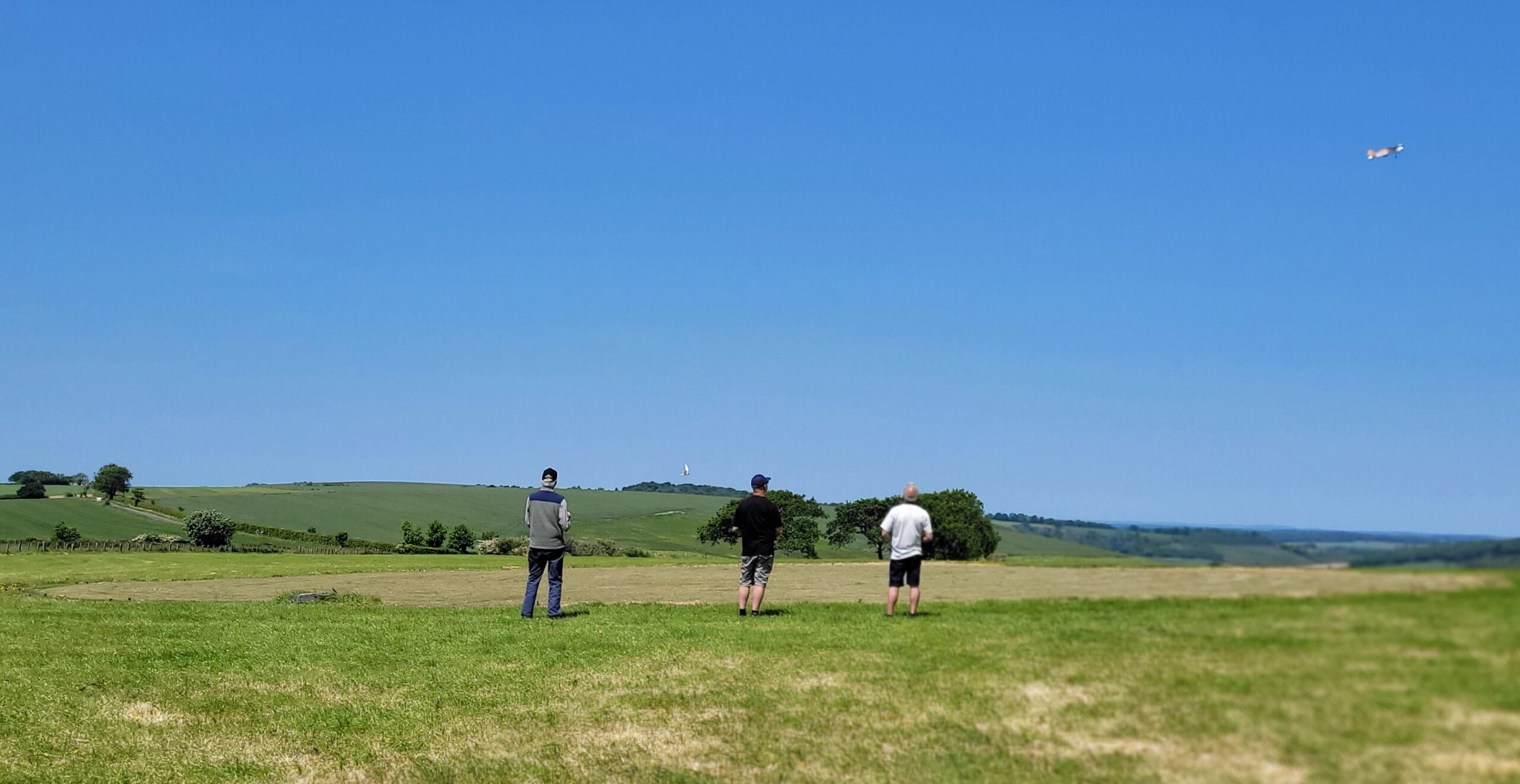 We had some excellent turnouts on the better days, not all those present are in this photo.
We had some excellent turnouts on the better days, not all those present are in this photo.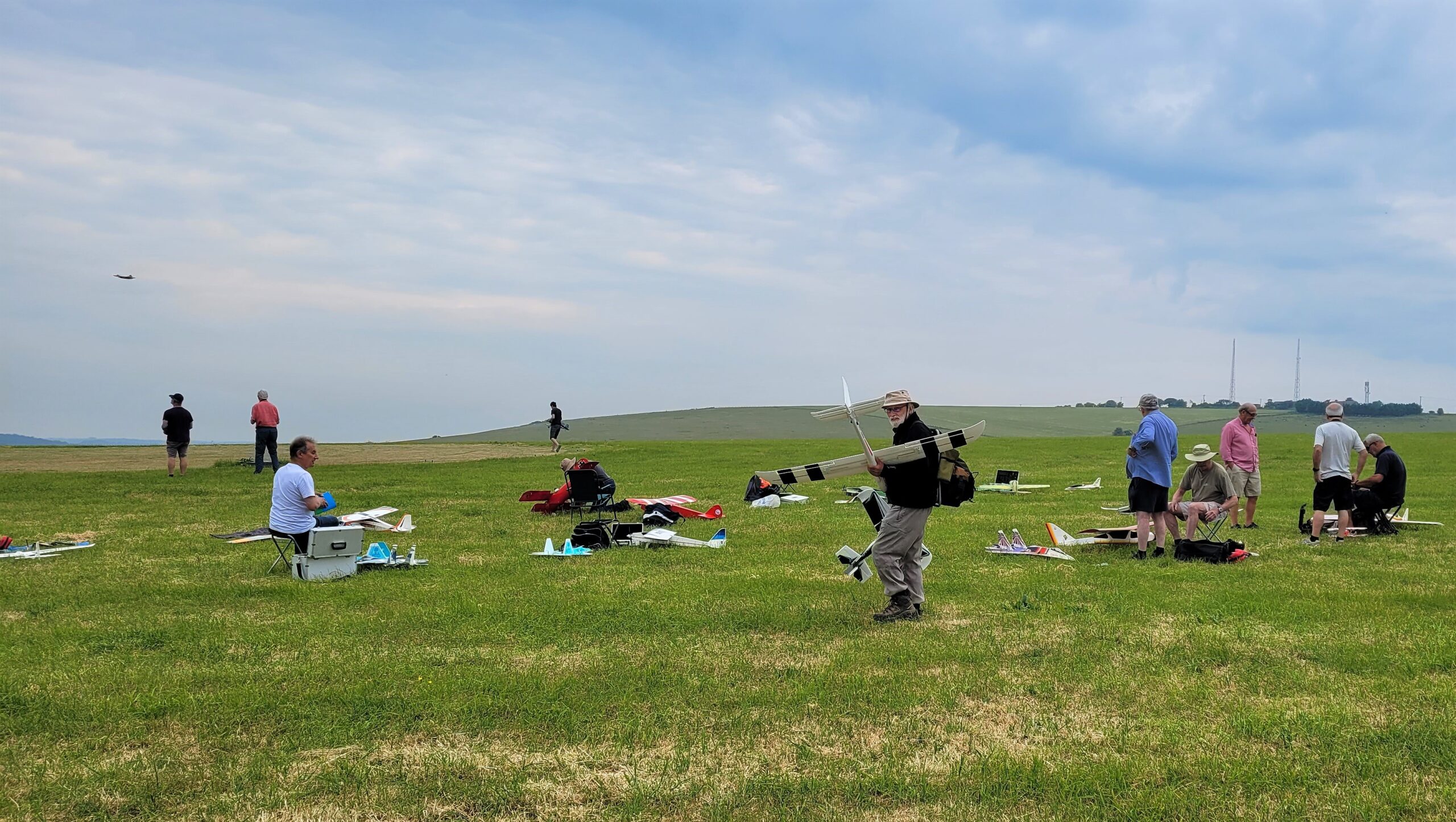 But a few of us flew on the last day of the month and it was as if winter had returned. 1066 snapped this photo of me wearing shorts but also a winter jacket and fingerless gloves!
But a few of us flew on the last day of the month and it was as if winter had returned. 1066 snapped this photo of me wearing shorts but also a winter jacket and fingerless gloves!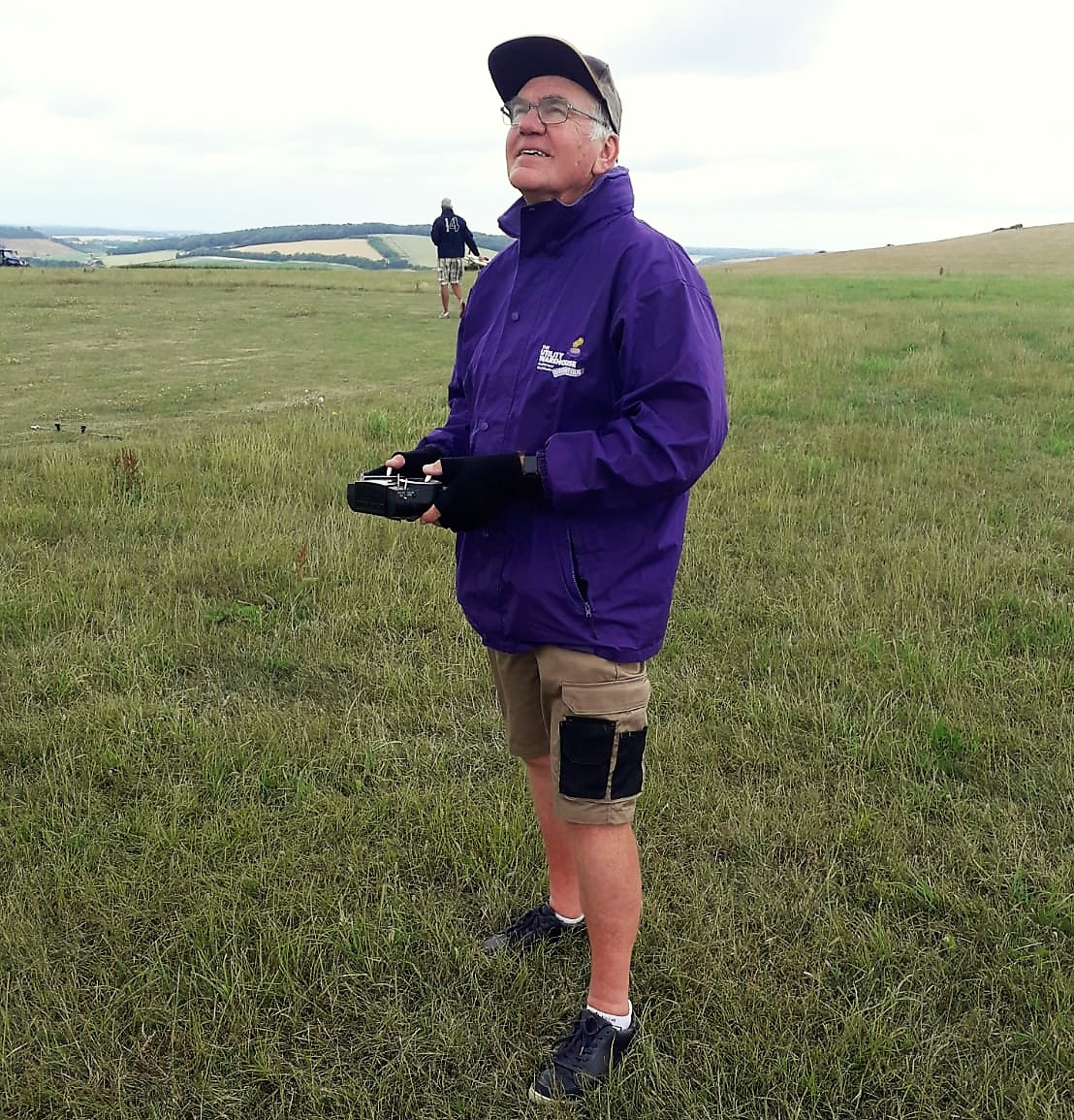 We took the opportunity to warm ourselves up by trimming back the undergrowth around the parking areas using a cordless hedge trimmer that Bob the Builder had brought along.
We took the opportunity to warm ourselves up by trimming back the undergrowth around the parking areas using a cordless hedge trimmer that Bob the Builder had brought along.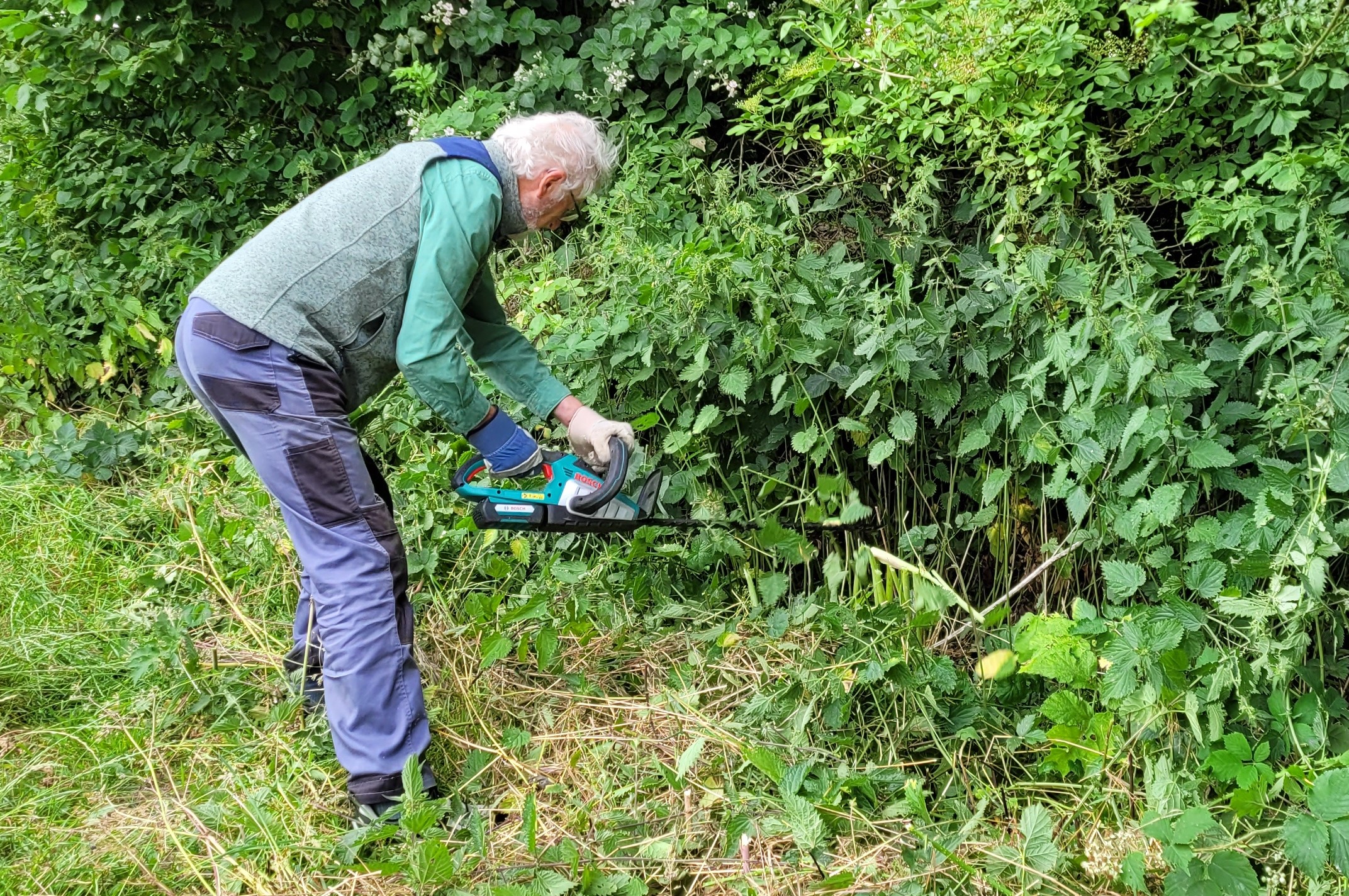 Recently 1066 bought himself a second-hand project and he finally got it flying in June. Here’s his tale: About 3 months ago a model popped up on Facebook Marketplace, it was a Fiesta-V thermal soarer. The description said the model would be ready to fly with a little ironing and your own receiver, which was a bit of a stretch as some of the covering was completely missing! The seller was in Gosport and the asking price was £60.00. I did fancy having a floater for the summer but I felt the asking price was a little high, and I could not be bothered to drive to Gosport, so I gave it a miss. Over the next few weeks the price kept dropping, so when it reached £30.00 I offered £20.00 which was accepted, plus there was the added bonus that it could be taken to Waterlooville for me to collect.
Recently 1066 bought himself a second-hand project and he finally got it flying in June. Here’s his tale: About 3 months ago a model popped up on Facebook Marketplace, it was a Fiesta-V thermal soarer. The description said the model would be ready to fly with a little ironing and your own receiver, which was a bit of a stretch as some of the covering was completely missing! The seller was in Gosport and the asking price was £60.00. I did fancy having a floater for the summer but I felt the asking price was a little high, and I could not be bothered to drive to Gosport, so I gave it a miss. Over the next few weeks the price kept dropping, so when it reached £30.00 I offered £20.00 which was accepted, plus there was the added bonus that it could be taken to Waterlooville for me to collect.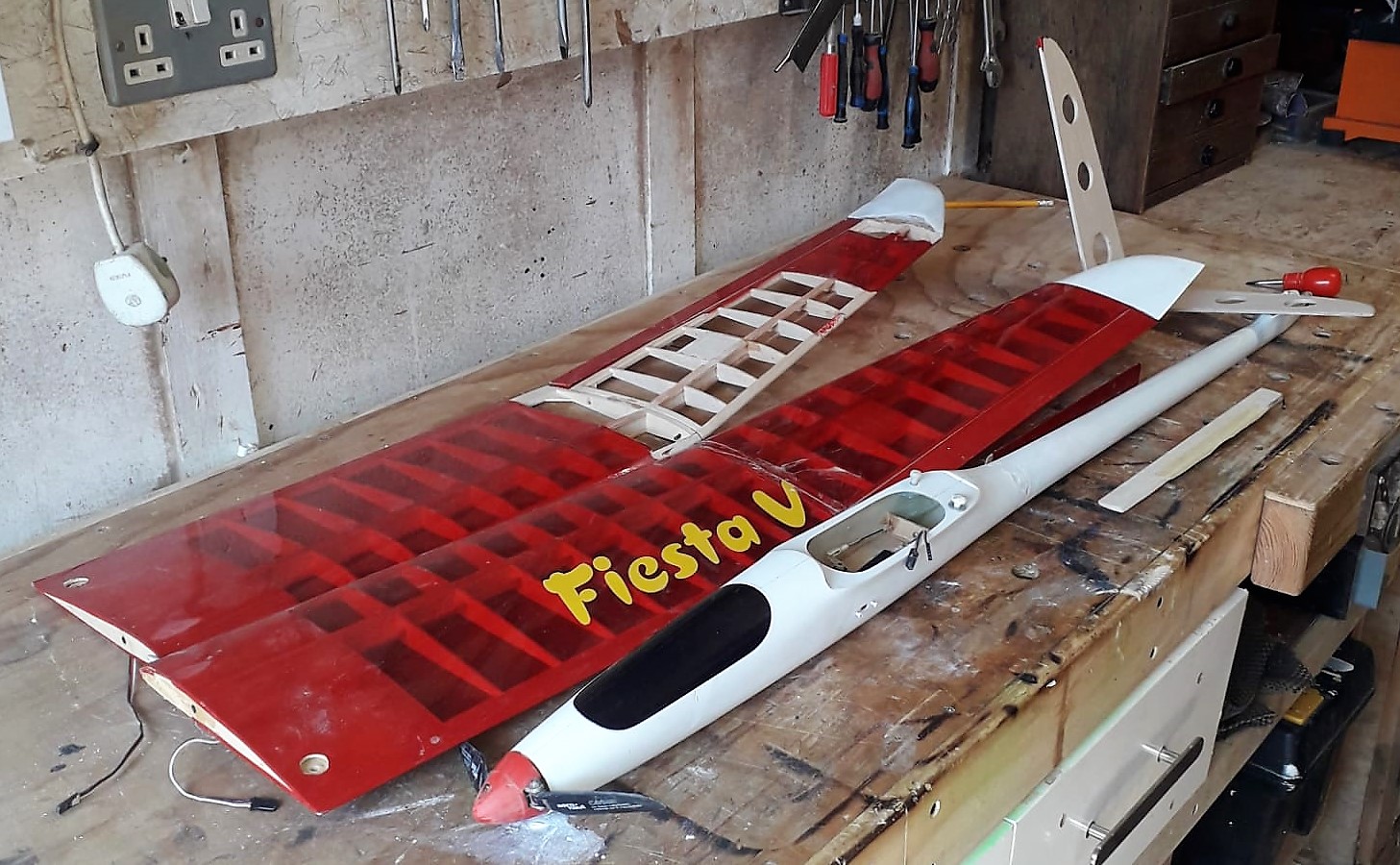 When I got the model home, closer inspection showed the fuselage had been repaired in many places and was very fragile, the covering on the underside of the wings had many splits patched up with loads of Sellotape, the motor was an old brushed Speed 600 (thanks for pointing that out Andy) but it did have the correct speed controller with built in BEC, and there was no wing joiner.
When I got the model home, closer inspection showed the fuselage had been repaired in many places and was very fragile, the covering on the underside of the wings had many splits patched up with loads of Sellotape, the motor was an old brushed Speed 600 (thanks for pointing that out Andy) but it did have the correct speed controller with built in BEC, and there was no wing joiner.
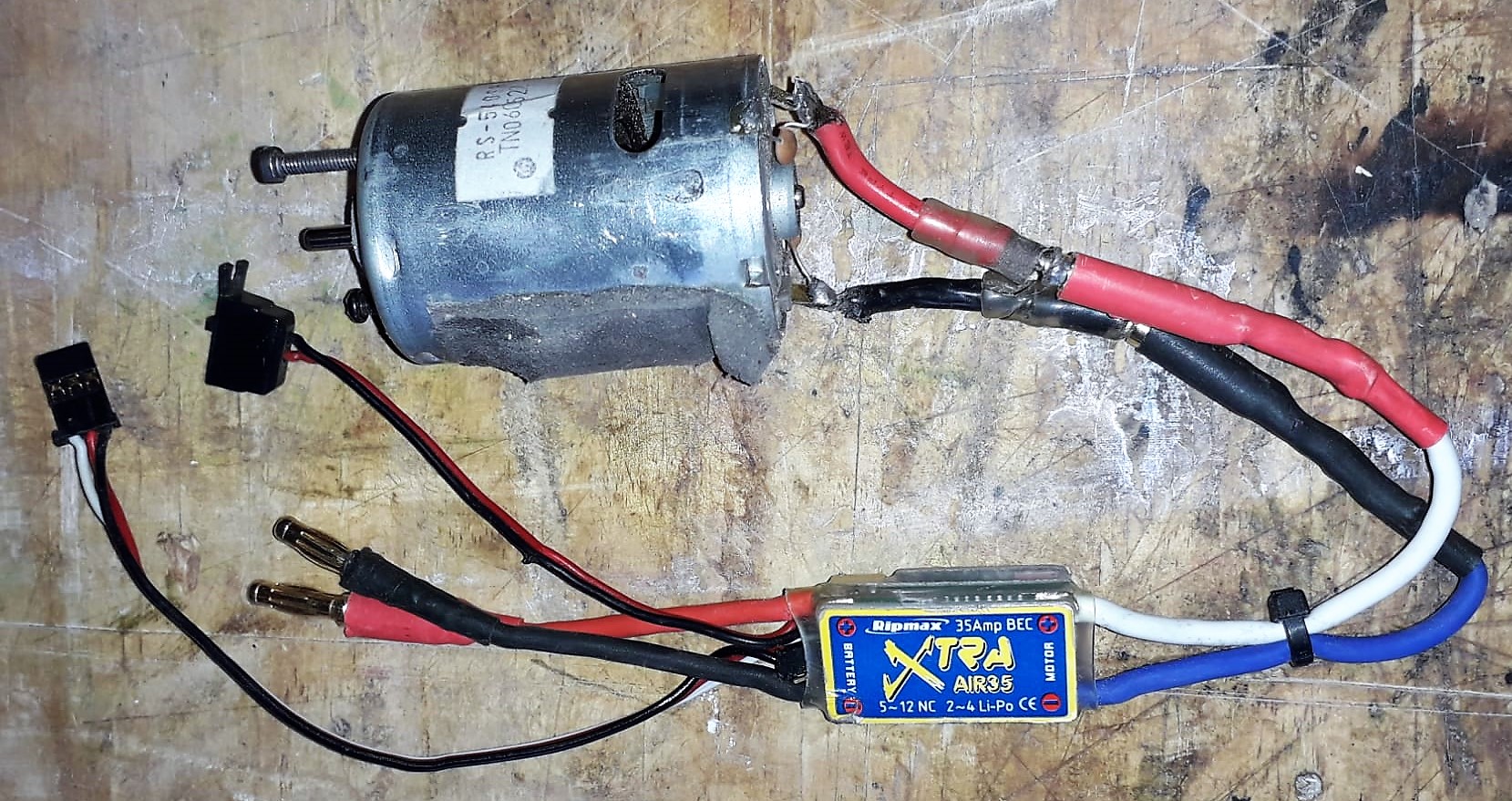 As I had some covering in the shed, the decision was made to completely remove all the original covering, which turned out to be the right decision as it revealed internal wing damage, however this was easily repaired and the wings recovered.
As I had some covering in the shed, the decision was made to completely remove all the original covering, which turned out to be the right decision as it revealed internal wing damage, however this was easily repaired and the wings recovered.
 Attention now turned to the fuselage which was strengthened, filled, and repainted with a tin of spray picked up in the Range, I promise I did not have a piece of the covering with me but the resulting match could not have been better.
Attention now turned to the fuselage which was strengthened, filled, and repainted with a tin of spray picked up in the Range, I promise I did not have a piece of the covering with me but the resulting match could not have been better.
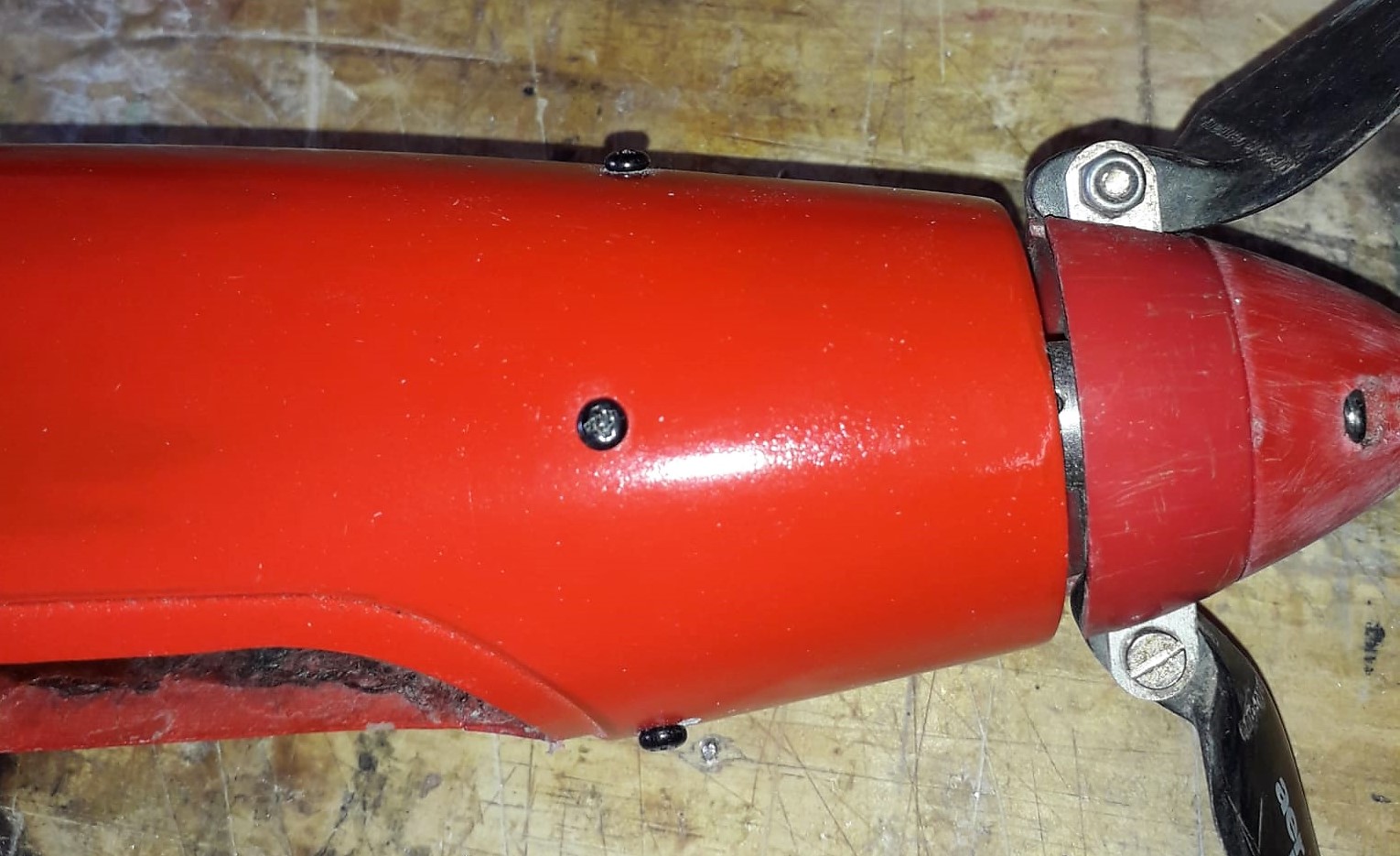 Feeling pleased with my progress I decided to check all the electrics worked, I know what you’re all saying, ” I would have done this first” and you would have been right, because the motor or speed controller was not working, as I have never used this type of setup before, I decided to replace both components. I now had to find a way of fitting a brushless outrunner (from stock). The resulting fix is far from ideal, but it will allow me to remove the bulkhead and replace the motor if the 1000 KV one fitted does not have enough power. In hindsight this would have been much easier and would have looked a lot better if it had been done along with the fuselage repairs, and not after everything had been painted. But on a more positive note all the servos did work.
Feeling pleased with my progress I decided to check all the electrics worked, I know what you’re all saying, ” I would have done this first” and you would have been right, because the motor or speed controller was not working, as I have never used this type of setup before, I decided to replace both components. I now had to find a way of fitting a brushless outrunner (from stock). The resulting fix is far from ideal, but it will allow me to remove the bulkhead and replace the motor if the 1000 KV one fitted does not have enough power. In hindsight this would have been much easier and would have looked a lot better if it had been done along with the fuselage repairs, and not after everything had been painted. But on a more positive note all the servos did work.
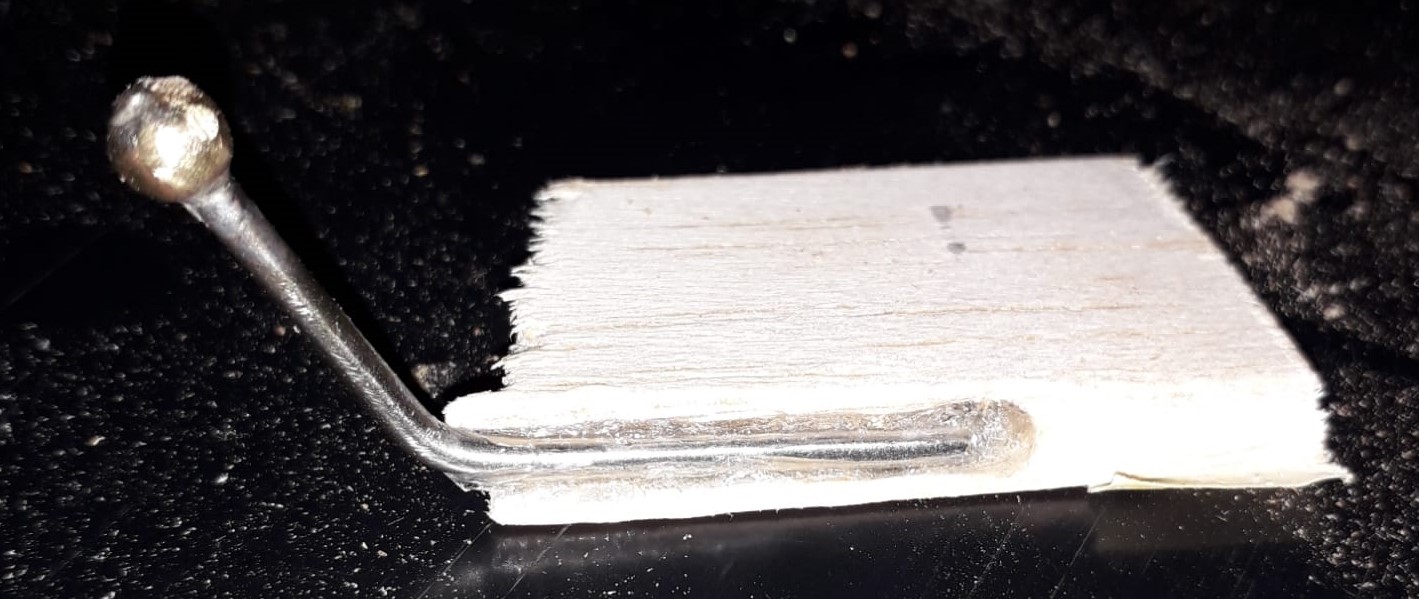 Next problem was the operation of the V Tail elevator/rudder controls, the original had a very neat ball link system concealed within the back of the fuz. I think the original owner had tried to replace one of the elevators, but had managed to produce two left hand halves! Plus the original one still in place had been damaged, so I decided to make two new elevators using the torque rods from the originals, But when it came to fitting the new elevators to the model I discovered that the two homemade torque rod/ball link assemblies were very slightly different, guess who lost that 50/50. This was very frustrating, and meant I had to make two more elevator halves, this was made more annoying because I did not have any trailing edge stock, more carving and sanding. Having learnt my lesson, this time I tried fitting the tailplane before the elevators were covered, this turned out to be an incredibly difficult process, with very little access to the ball links, in fact it was so difficult I never actually achieved it. My next move was to cut off a small portion of the rear of the fuz for better access, I could now get the ball links to fit, but now found they were so loose that I was not happy to use them in flight. I was determined to use as much of the original linkages as possible, mainly because I did not have anything else in the shed and did not want to spend any money LOL.
Next problem was the operation of the V Tail elevator/rudder controls, the original had a very neat ball link system concealed within the back of the fuz. I think the original owner had tried to replace one of the elevators, but had managed to produce two left hand halves! Plus the original one still in place had been damaged, so I decided to make two new elevators using the torque rods from the originals, But when it came to fitting the new elevators to the model I discovered that the two homemade torque rod/ball link assemblies were very slightly different, guess who lost that 50/50. This was very frustrating, and meant I had to make two more elevator halves, this was made more annoying because I did not have any trailing edge stock, more carving and sanding. Having learnt my lesson, this time I tried fitting the tailplane before the elevators were covered, this turned out to be an incredibly difficult process, with very little access to the ball links, in fact it was so difficult I never actually achieved it. My next move was to cut off a small portion of the rear of the fuz for better access, I could now get the ball links to fit, but now found they were so loose that I was not happy to use them in flight. I was determined to use as much of the original linkages as possible, mainly because I did not have anything else in the shed and did not want to spend any money LOL.
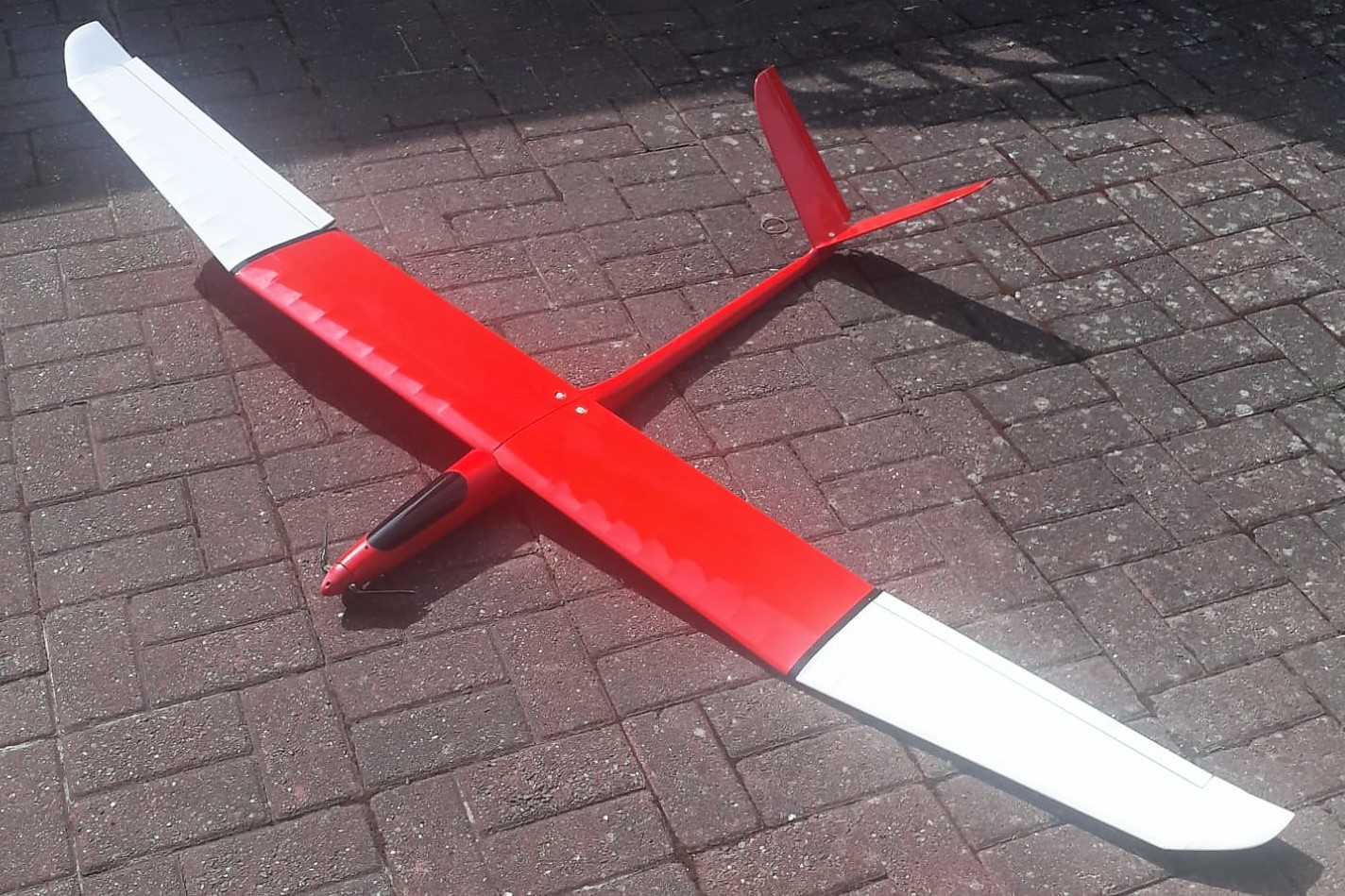 My next move was to cut away a bit more of the fuselage, fit control horns, and bring the pushrods out at the side, however this had another surprise, as one pushrod was piano wire and the other was carbon! Finally I needed a wing joiner, so my thanks go to Olav for supplying the necessary material. All of the above could have been avoided if I had done things in the correct order, had fully surveyed what I had before starting, and been willing to spend a bit more money 🙂 I am no builder, and we all hate repairing, but I have really enjoyed saving what I think is a very smart model from the bin, and all with a total spend of £25.00, I am very happy with the result, just hope it flies OK.
Since sending me the above report 1066 has flown the model so I asked how it went but his one word reply was unprintable! But then this: Lots of issues, I was always a bit surprised to have ailerons on a wing with polyhedral, they were as effective as a chocolate fire guard. I had not realised there was a bit of a twist in the left wing, flying straight almost needed full right aileron and rudder, rudders not the best as it is a V-tail. Plus it was too windy. One plus, it does have just enough power. The wing has now been straightened and the ailerons now have huge differential settings and have been mixed with rudder. I also found the left wing a bit heavier than the right, so this has now been balanced. Because I didn’t have a wing joiner I assumed there would be dihedral on the centre section as this gave the best joint between the wings so for the next flight I have taken this out which should make the ailerons work better. The next flight will be on a calmer day.
My next move was to cut away a bit more of the fuselage, fit control horns, and bring the pushrods out at the side, however this had another surprise, as one pushrod was piano wire and the other was carbon! Finally I needed a wing joiner, so my thanks go to Olav for supplying the necessary material. All of the above could have been avoided if I had done things in the correct order, had fully surveyed what I had before starting, and been willing to spend a bit more money 🙂 I am no builder, and we all hate repairing, but I have really enjoyed saving what I think is a very smart model from the bin, and all with a total spend of £25.00, I am very happy with the result, just hope it flies OK.
Since sending me the above report 1066 has flown the model so I asked how it went but his one word reply was unprintable! But then this: Lots of issues, I was always a bit surprised to have ailerons on a wing with polyhedral, they were as effective as a chocolate fire guard. I had not realised there was a bit of a twist in the left wing, flying straight almost needed full right aileron and rudder, rudders not the best as it is a V-tail. Plus it was too windy. One plus, it does have just enough power. The wing has now been straightened and the ailerons now have huge differential settings and have been mixed with rudder. I also found the left wing a bit heavier than the right, so this has now been balanced. Because I didn’t have a wing joiner I assumed there would be dihedral on the centre section as this gave the best joint between the wings so for the next flight I have taken this out which should make the ailerons work better. The next flight will be on a calmer day.
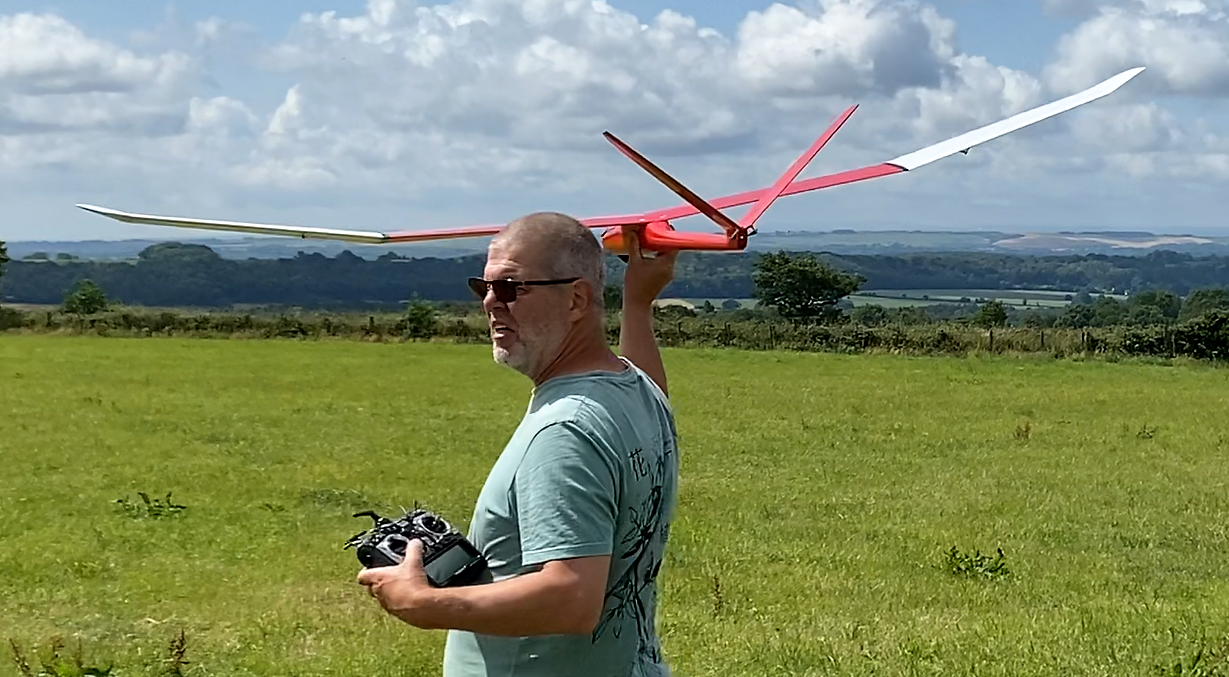 Thanks for that 1066. I must say that the model looks very smart and in the video it looks to be flying well but the video doesn’t show the struggles for control that 1066 was having on the transmitter! STOP PRESS: 1066 has just reported that having corrected all the things he found wrong he’s flown it again and now the Fiesta V flies really well with lots of potential for some great thermal soaring. So all that effort has proved to be completely worthwhile now that it’s up and soaring like an eagle, just don’t break it!
Peter F treated himself to a new model in June, an Edge 540 by FMS. The all foam model is just 750mm wingspan and is ‘Plug n Play’ as it comes ready fitted with the motor, esc, four 5g servos and a gyro. The Edge requires 1300mAh 2 cell batteries of at least 20C.
Thanks for that 1066. I must say that the model looks very smart and in the video it looks to be flying well but the video doesn’t show the struggles for control that 1066 was having on the transmitter! STOP PRESS: 1066 has just reported that having corrected all the things he found wrong he’s flown it again and now the Fiesta V flies really well with lots of potential for some great thermal soaring. So all that effort has proved to be completely worthwhile now that it’s up and soaring like an eagle, just don’t break it!
Peter F treated himself to a new model in June, an Edge 540 by FMS. The all foam model is just 750mm wingspan and is ‘Plug n Play’ as it comes ready fitted with the motor, esc, four 5g servos and a gyro. The Edge requires 1300mAh 2 cell batteries of at least 20C.
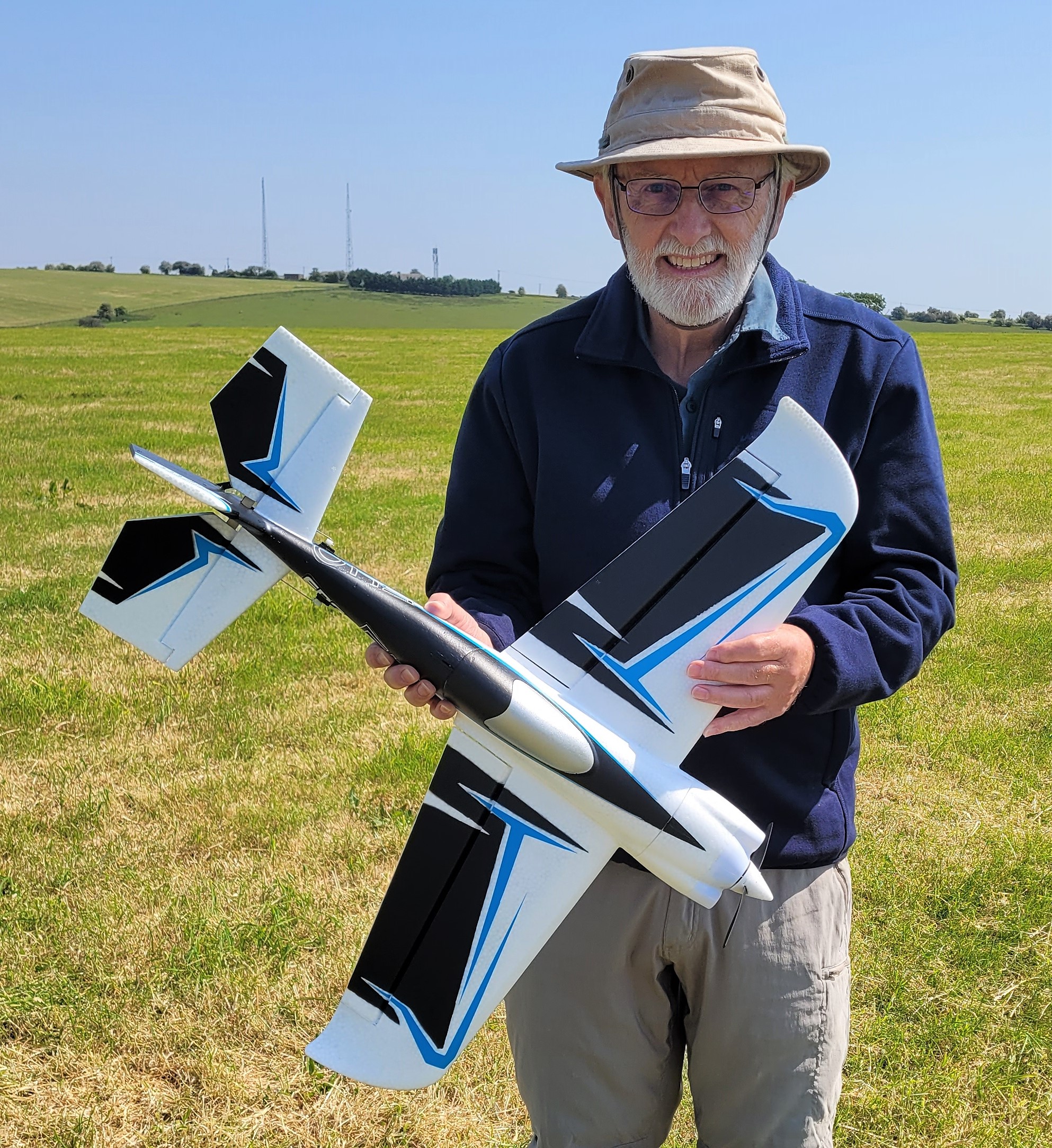 This is from the website: FMS has miniaturized the ultra popular 1300mm Edge 540!
This is from the website: FMS has miniaturized the ultra popular 1300mm Edge 540!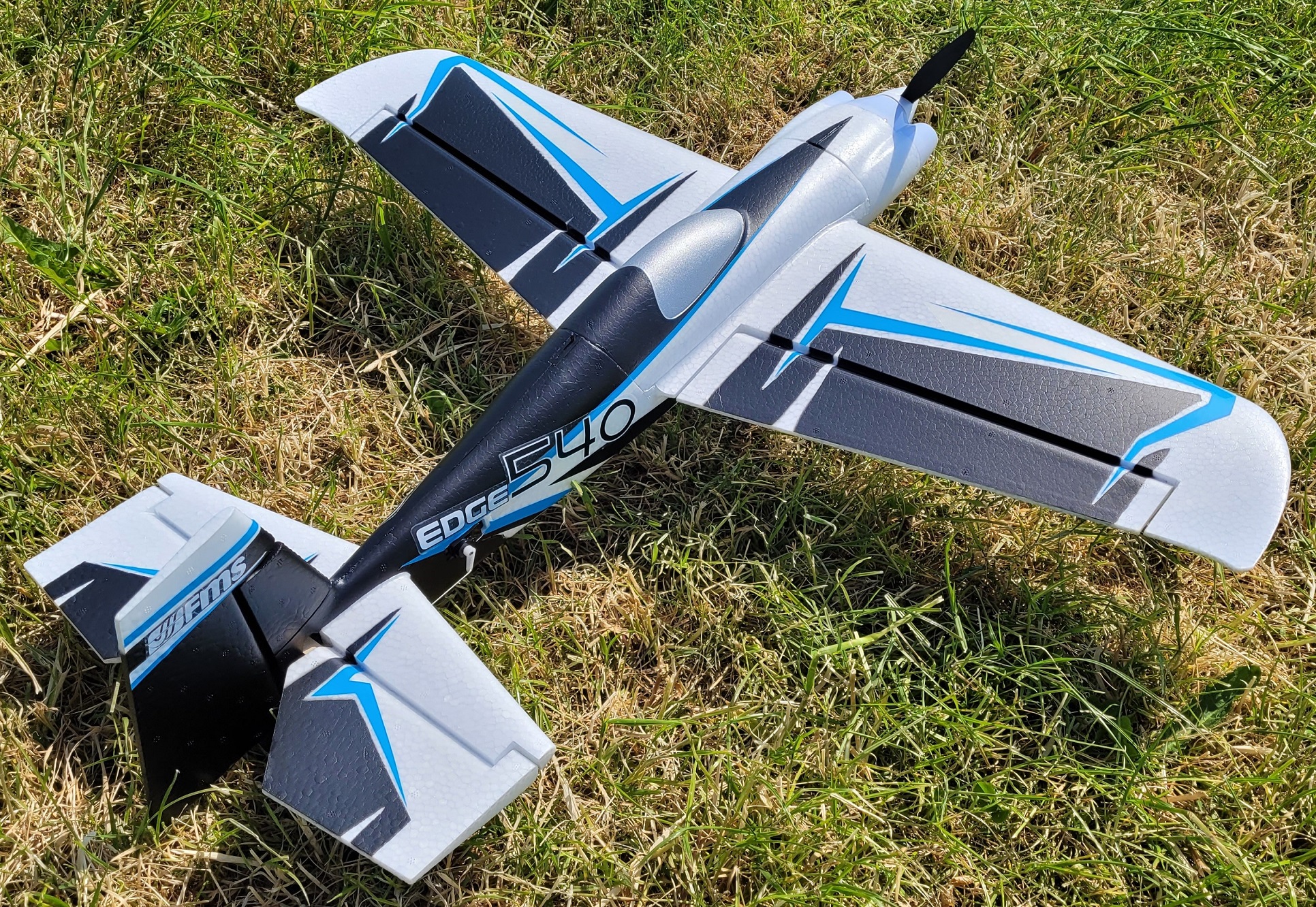 Don’t let the small wingspan mislead you, the FMS 750mm Edge 540 is as much a beast as its older brother! Courtesy of the large control surfaces and high power-to-weight ratio, even the most advanced aerobatic manoeuvres can be performed with pinpoint precision. Thanks to the small wingspan and a take-off weight of only 390g, the 750mm Edge 540 will fly just about anywhere! No detail was overlooked in the design of this aircraft- a latch-type canopy will easily put up with even the most violent manoeuvres; while an oversized battery compartment makes installing batteries a breeze.
Don’t let the small wingspan mislead you, the FMS 750mm Edge 540 is as much a beast as its older brother! Courtesy of the large control surfaces and high power-to-weight ratio, even the most advanced aerobatic manoeuvres can be performed with pinpoint precision. Thanks to the small wingspan and a take-off weight of only 390g, the 750mm Edge 540 will fly just about anywhere! No detail was overlooked in the design of this aircraft- a latch-type canopy will easily put up with even the most violent manoeuvres; while an oversized battery compartment makes installing batteries a breeze.
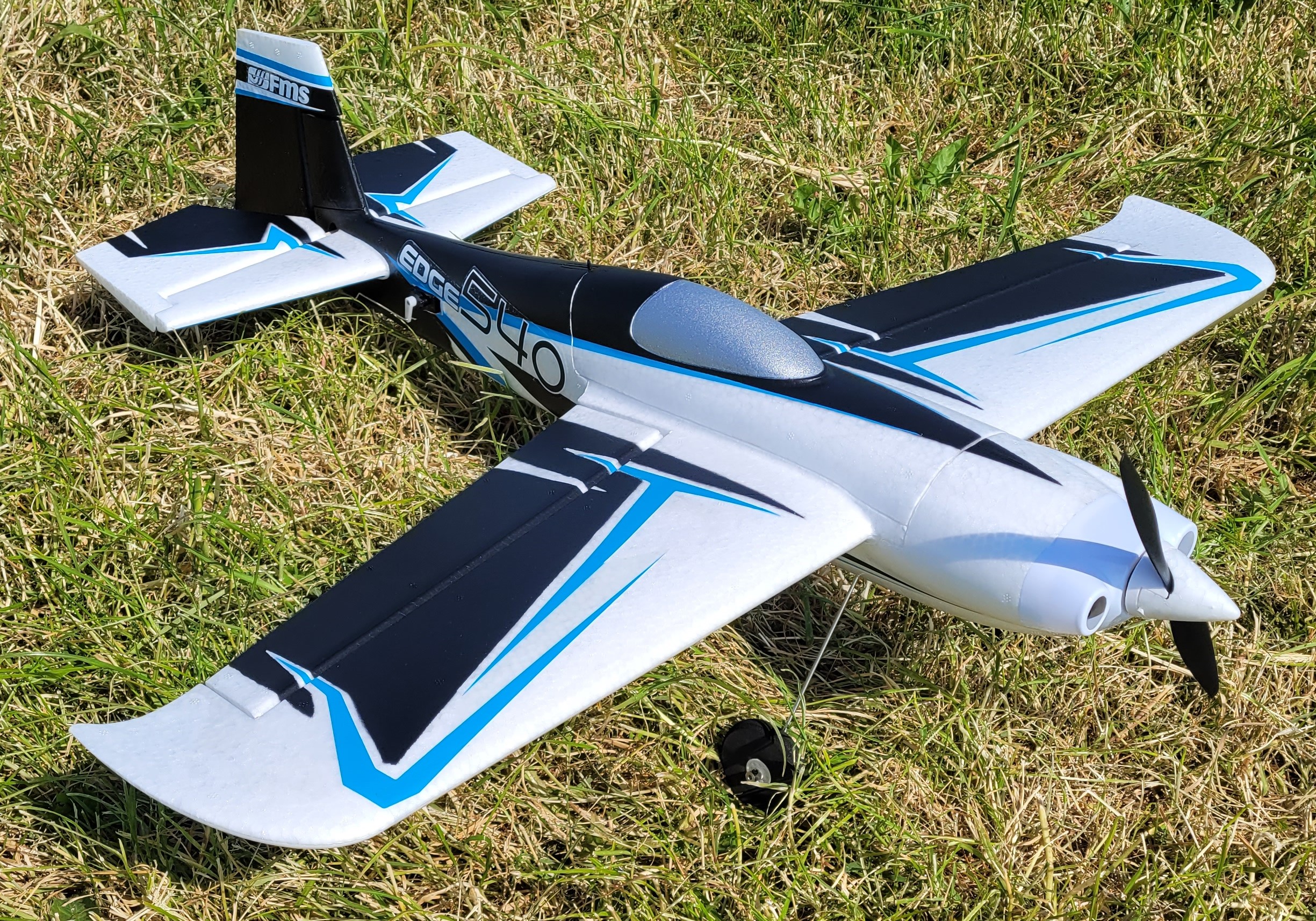 Adorned with an attractive blue-black trim scheme, the Edge 540 looks fantastic in the air! Power comes from a 2212 2250KV brushless motor with a Predator 20A ESC, giving the Edge 540 all the power you’ll ever need. Want a fly-anywhere aerobatic machine? Look no further than the FMS 750mm Edge 540! Peter asked me to do the test flight during which I played with the gyro settings. It’s an FMS Reflex V2 Flight Controller and has three settings, Stabilised, Optimised, and Off. In Stabilised mode it limits the angle of bank and pitch and recovers to straight and level flight when the sticks are released. Optimised allows for full 3D flight but counteracts wind gusts and smooths out the flight. With it Off you’re on your own! It seemed to work very well and in Stabilised mode it wouldn’t to do anything other than fly around gently, no aerobatics were possible.
Adorned with an attractive blue-black trim scheme, the Edge 540 looks fantastic in the air! Power comes from a 2212 2250KV brushless motor with a Predator 20A ESC, giving the Edge 540 all the power you’ll ever need. Want a fly-anywhere aerobatic machine? Look no further than the FMS 750mm Edge 540! Peter asked me to do the test flight during which I played with the gyro settings. It’s an FMS Reflex V2 Flight Controller and has three settings, Stabilised, Optimised, and Off. In Stabilised mode it limits the angle of bank and pitch and recovers to straight and level flight when the sticks are released. Optimised allows for full 3D flight but counteracts wind gusts and smooths out the flight. With it Off you’re on your own! It seemed to work very well and in Stabilised mode it wouldn’t to do anything other than fly around gently, no aerobatics were possible.
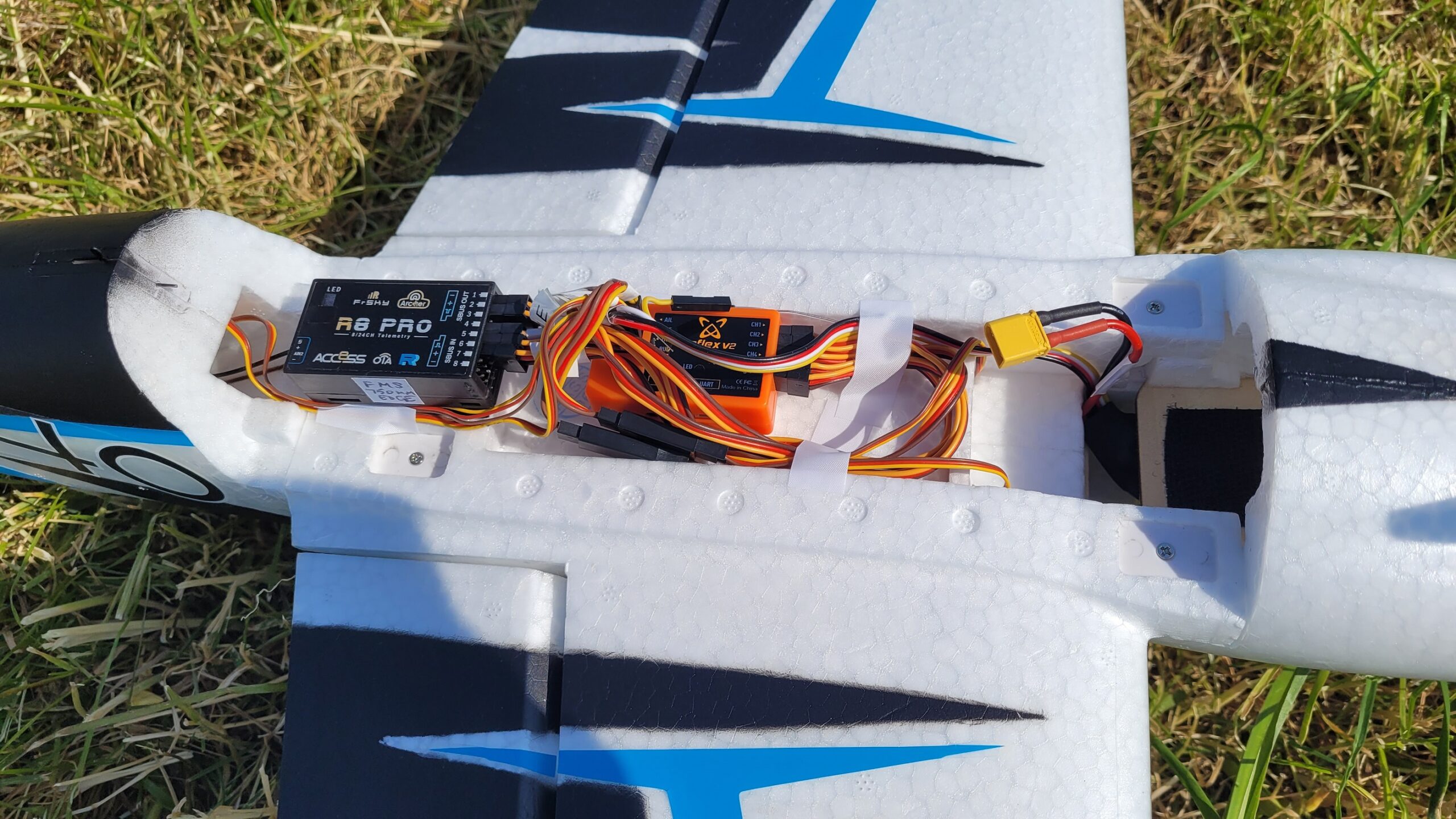 I found Optimised the perfect setting as with it Off the plane was a real handful and I quickly switched back to Optimised. Peter soon took over control and managed the rest of the flight but it was definitely twitchier than the models he’s used to flying. At another session later in the month Peter found it was too windy for him to control the Edge and it crashed, breaking the propeller and cracking the starboard wing root. But repairs have now been completed and Peter has flown again on a less windy day although he’s still finding it very twitchy. Turns the rates down a bit Peter until you get more used to it.
Dwayne Pipe had an unusual and interesting problem at the field one day this month while attempting to fly his Splot XL and he’s kindly written a report about what he found: Dwayne Pipe’s very short analysis of an aircraft failure.
There is no such thing as an accident, or at least that was what my previous employer claimed in his safety lectures. Aircraft incidents are 95% are due to pilot error. 5% are due to poor maintenance and faulty equipment installed by the plane’s owner.
This example illustrates my point:
My Splot XL developed a strange behaviour. Ground checks were fine but on take-off the rudder pulled sharply to the right and the plane ground looped and crashed.
I found Optimised the perfect setting as with it Off the plane was a real handful and I quickly switched back to Optimised. Peter soon took over control and managed the rest of the flight but it was definitely twitchier than the models he’s used to flying. At another session later in the month Peter found it was too windy for him to control the Edge and it crashed, breaking the propeller and cracking the starboard wing root. But repairs have now been completed and Peter has flown again on a less windy day although he’s still finding it very twitchy. Turns the rates down a bit Peter until you get more used to it.
Dwayne Pipe had an unusual and interesting problem at the field one day this month while attempting to fly his Splot XL and he’s kindly written a report about what he found: Dwayne Pipe’s very short analysis of an aircraft failure.
There is no such thing as an accident, or at least that was what my previous employer claimed in his safety lectures. Aircraft incidents are 95% are due to pilot error. 5% are due to poor maintenance and faulty equipment installed by the plane’s owner.
This example illustrates my point:
My Splot XL developed a strange behaviour. Ground checks were fine but on take-off the rudder pulled sharply to the right and the plane ground looped and crashed.
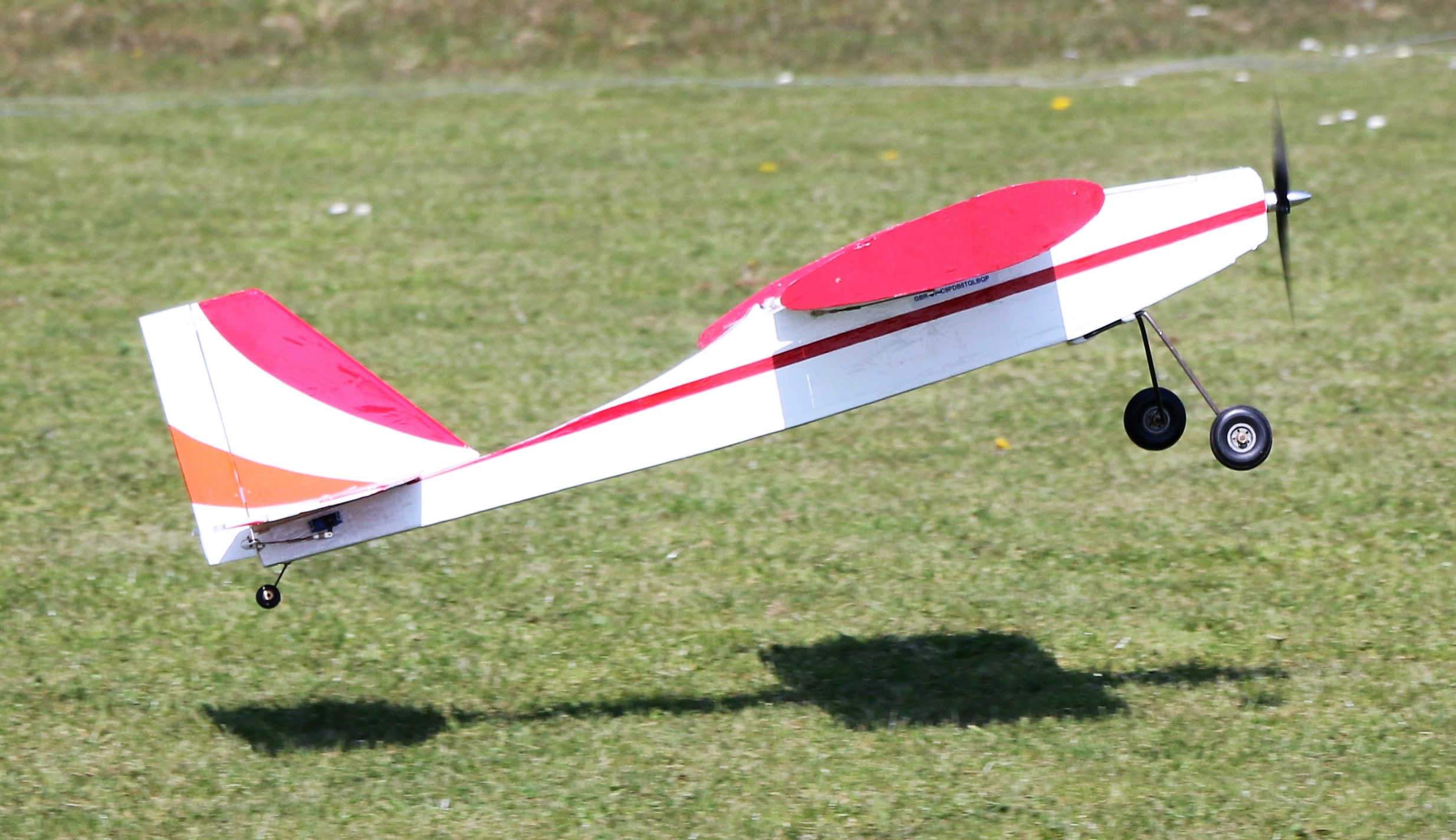 After detailed field investigation including the extensive combined wisdom of most of the committee, we hadn’t a clue. They thought it might be a mix error in the transmitter.
I reprogrammed the transmitter, exchanged the receiver, no better.
Like many a tricky problem the reason was a combination of my mistakes.
After the last major plane disassembly (We call that a crash Dwayne!) the motor had to be dug out of the field. It was full of prime Hampshire mud and even after stripping down and hosing through it ran noisy and rough, but it ran, so I reinstalled it.
I had to replace the prop and a well-known model shop were selling the right size, cheap. When it arrived the centre hole was 1mm out of true. I complained but was ignored.
I managed to balance the prop eventually, but the combined motor and prop ran like a bag of nails in a spin dryer.
The third item in the equation was one of HobbyKings’ finest £4 servos which had been in the plane for about 7 years and over 250 flights. Due to the abuse that the plane had experienced at the hands of its pilot, it took it into its head to come out in sympathy and lose contact with its feedback pot whenever the vibration of the replaced motor and prop went beyond about 50%. The servo with no feedback went full in one direction until the vibration stopped when it operated as normal.
Solution: Replace the servo, motor and prop and don’t be such a cheapskate in the future.
Haha, I love the ‘don’t be such a cheapskate’ Dwayne, I’ll try to remember that!
Gordon Bennett bought a new foamboard F-22 Raptor in June, I’ll let him explain:
The Raptor was a ‘Woody Special’. Somehow he got delivered three of them so he flogged the extra aircraft to Mr Palmer and myself for 30 quid. (Not me Gordon, I bought mine from AliExpress, I think Woody kept the other one for himself as a back-up).
Not bad considering that’s everything you need to complete the model (except talent).
After detailed field investigation including the extensive combined wisdom of most of the committee, we hadn’t a clue. They thought it might be a mix error in the transmitter.
I reprogrammed the transmitter, exchanged the receiver, no better.
Like many a tricky problem the reason was a combination of my mistakes.
After the last major plane disassembly (We call that a crash Dwayne!) the motor had to be dug out of the field. It was full of prime Hampshire mud and even after stripping down and hosing through it ran noisy and rough, but it ran, so I reinstalled it.
I had to replace the prop and a well-known model shop were selling the right size, cheap. When it arrived the centre hole was 1mm out of true. I complained but was ignored.
I managed to balance the prop eventually, but the combined motor and prop ran like a bag of nails in a spin dryer.
The third item in the equation was one of HobbyKings’ finest £4 servos which had been in the plane for about 7 years and over 250 flights. Due to the abuse that the plane had experienced at the hands of its pilot, it took it into its head to come out in sympathy and lose contact with its feedback pot whenever the vibration of the replaced motor and prop went beyond about 50%. The servo with no feedback went full in one direction until the vibration stopped when it operated as normal.
Solution: Replace the servo, motor and prop and don’t be such a cheapskate in the future.
Haha, I love the ‘don’t be such a cheapskate’ Dwayne, I’ll try to remember that!
Gordon Bennett bought a new foamboard F-22 Raptor in June, I’ll let him explain:
The Raptor was a ‘Woody Special’. Somehow he got delivered three of them so he flogged the extra aircraft to Mr Palmer and myself for 30 quid. (Not me Gordon, I bought mine from AliExpress, I think Woody kept the other one for himself as a back-up).
Not bad considering that’s everything you need to complete the model (except talent).
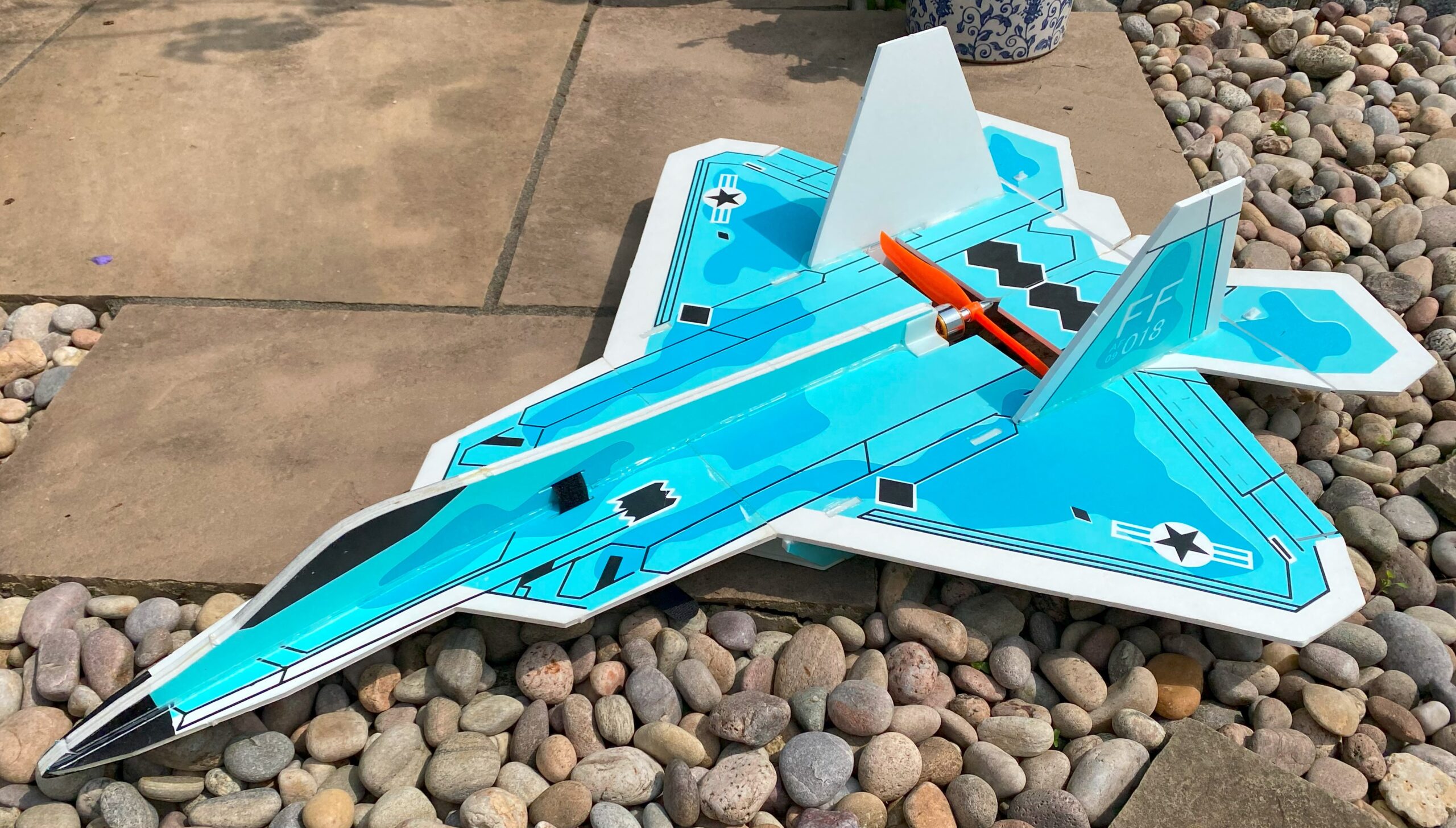 It didn’t come with any instructions but I had a good look at Woody’s completed model and went from there. The fuselage is just two pieces of foamboard doubled up for strength, the wing has a carbon fibre spar. It’s odd though as Woody’s model has two spars, one mid-wing and one more rearward, maybe I’ll add a length of dowel if the wing needs more stiffness but it seems ok at the moment. The included motor is a 1400KV powered by a 30A ESC. I’m using a 3S 1600 battery which gives about a 5-minute flight.
It didn’t come with any instructions but I had a good look at Woody’s completed model and went from there. The fuselage is just two pieces of foamboard doubled up for strength, the wing has a carbon fibre spar. It’s odd though as Woody’s model has two spars, one mid-wing and one more rearward, maybe I’ll add a length of dowel if the wing needs more stiffness but it seems ok at the moment. The included motor is a 1400KV powered by a 30A ESC. I’m using a 3S 1600 battery which gives about a 5-minute flight. 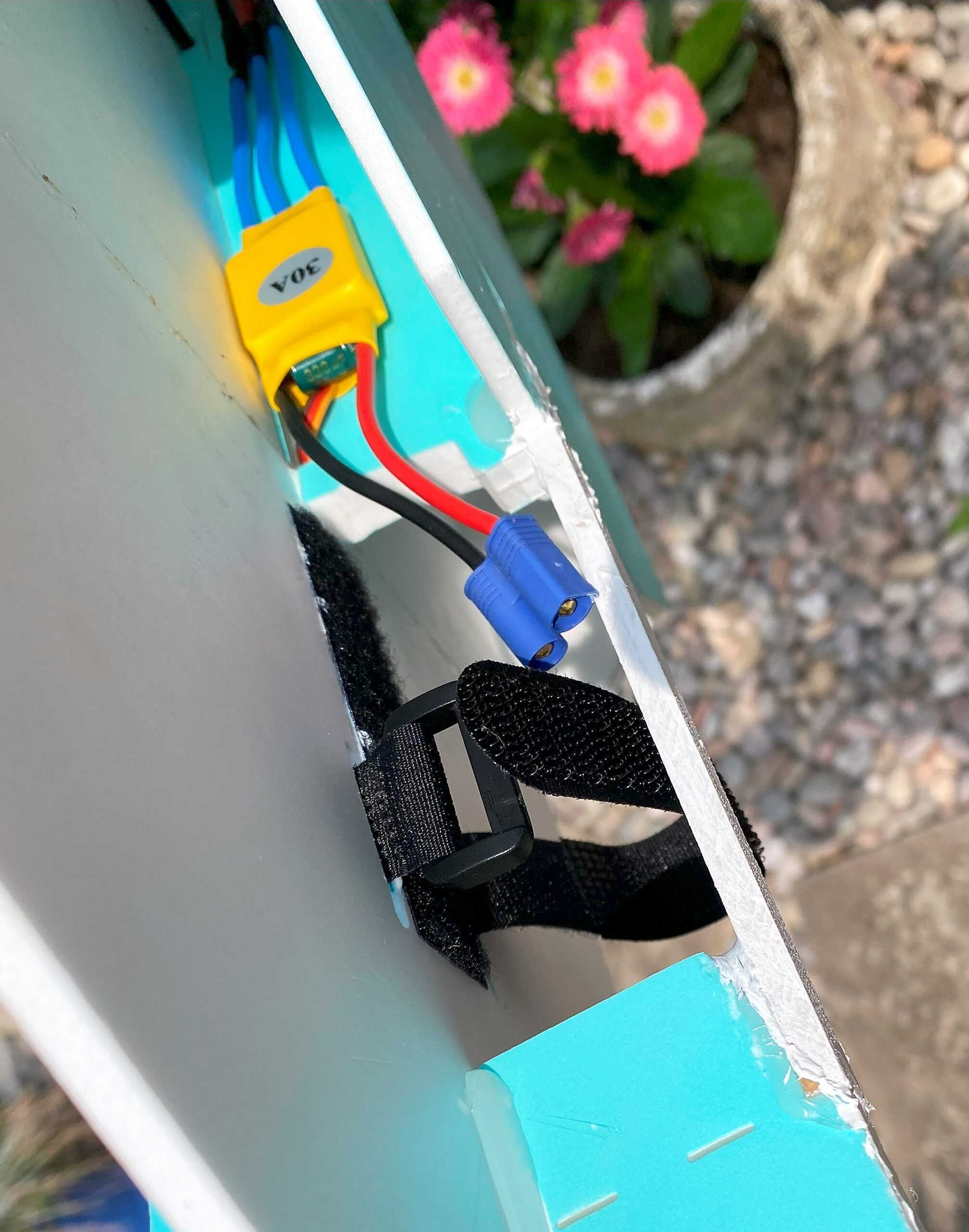 The battery fits in a slot cut out of the underside of the fuselage, I thought this might lead to a weakness so I grafted in a short length of balsa to act as a stiffening keel. Two 9g servos operate the elevons but the pushrods are too light. They’re fine when they’re in tension, pulling down elevator but when pushing they just bow out. It doesn’t take much airflow over the control surface to do this so I’m going to have to sort this at a later date.
The battery fits in a slot cut out of the underside of the fuselage, I thought this might lead to a weakness so I grafted in a short length of balsa to act as a stiffening keel. Two 9g servos operate the elevons but the pushrods are too light. They’re fine when they’re in tension, pulling down elevator but when pushing they just bow out. It doesn’t take much airflow over the control surface to do this so I’m going to have to sort this at a later date.
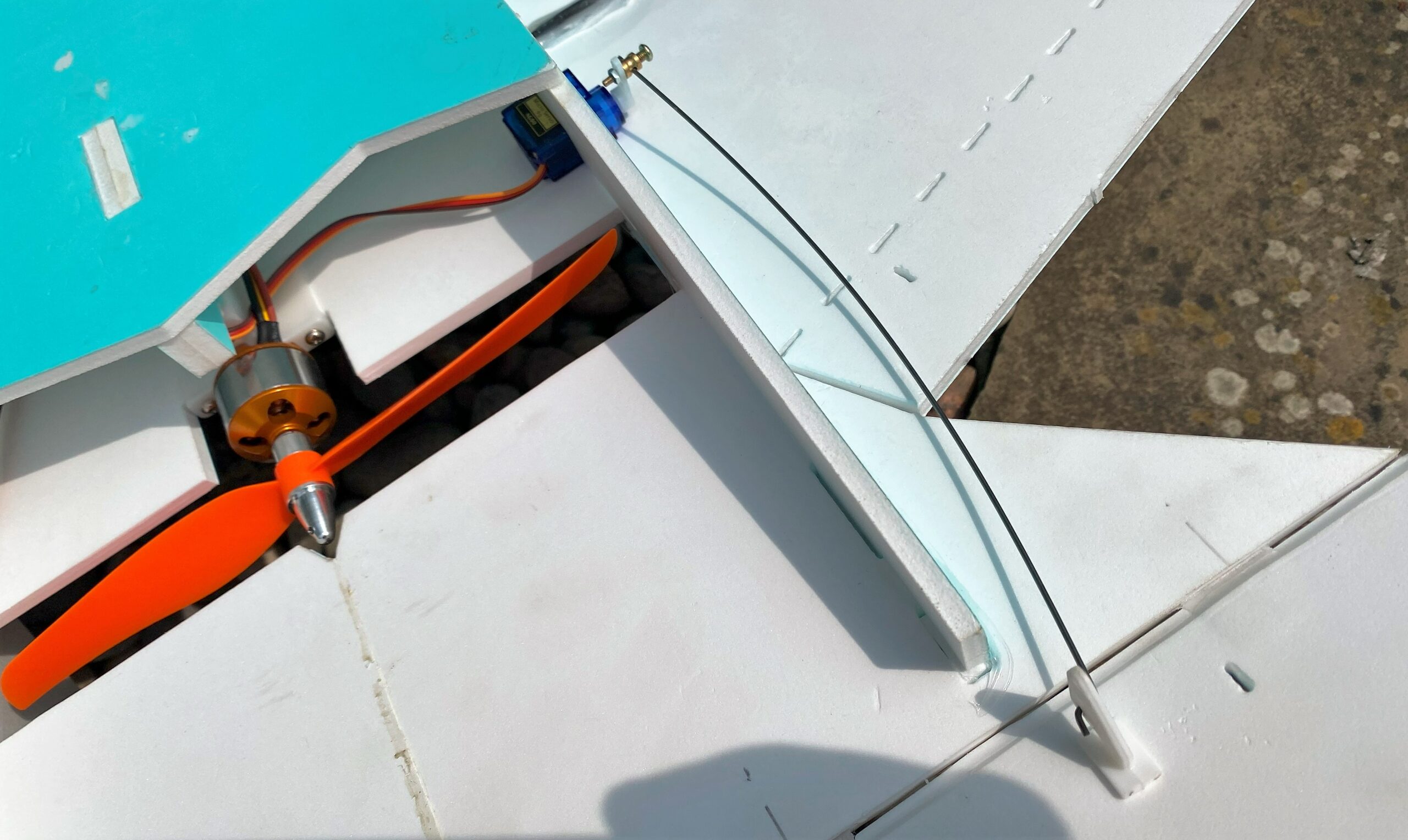 Woody has linked in the ailerons on his model to operate in tandem with the elevons and this would shorten the linkage length. It was a bit blustery on the first flight and lots of trim was required but all in all she seemed ‘about right’. C of G was a complete guess but nothing drastic happened so we’ll call it ok. It’s not exactly fast but what do you expect for 30 quid! It won’t take long for it to get into combat mode with Mr Palmer so I’m not going to spend lots of time perfecting it as Palmer will just ram it at the first opportunity.
Woody has linked in the ailerons on his model to operate in tandem with the elevons and this would shorten the linkage length. It was a bit blustery on the first flight and lots of trim was required but all in all she seemed ‘about right’. C of G was a complete guess but nothing drastic happened so we’ll call it ok. It’s not exactly fast but what do you expect for 30 quid! It won’t take long for it to get into combat mode with Mr Palmer so I’m not going to spend lots of time perfecting it as Palmer will just ram it at the first opportunity. 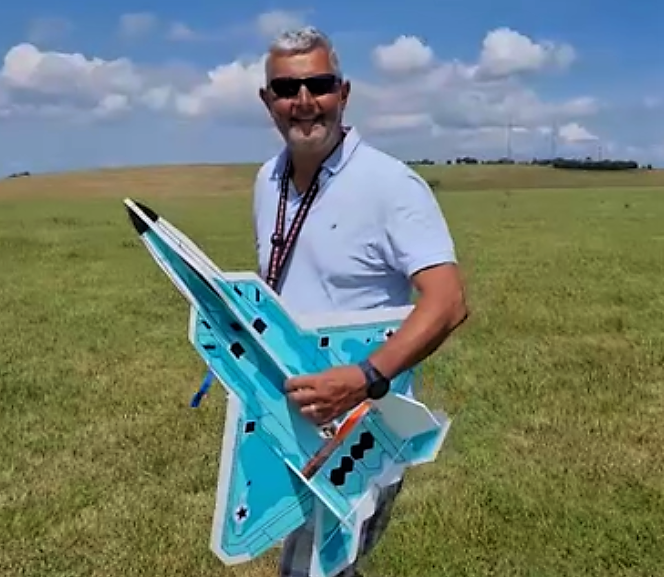 He took out Woody’s Raptor on Wednesday with his Yak, maybe I’ll try and fit a small cannon or other weaponry. No I didn’t! There was a minor collision on a downwind turn which neatly removed one of the fins from Woody’s Raptor. I landed my undamaged Yak and then grabbed Woody’s transmitter as he was struggling and landed his Raptor. The wayward fin was retrieved and re-attached and the Raptor is now flying beautifully again.
Towards the end of June Mini-Mike took himself off to the Wings & Wheels Model Show at North Weald and while browsing the trade stands was tempted by a Max Thrust Riot.
He took out Woody’s Raptor on Wednesday with his Yak, maybe I’ll try and fit a small cannon or other weaponry. No I didn’t! There was a minor collision on a downwind turn which neatly removed one of the fins from Woody’s Raptor. I landed my undamaged Yak and then grabbed Woody’s transmitter as he was struggling and landed his Raptor. The wayward fin was retrieved and re-attached and the Raptor is now flying beautifully again.
Towards the end of June Mini-Mike took himself off to the Wings & Wheels Model Show at North Weald and while browsing the trade stands was tempted by a Max Thrust Riot.
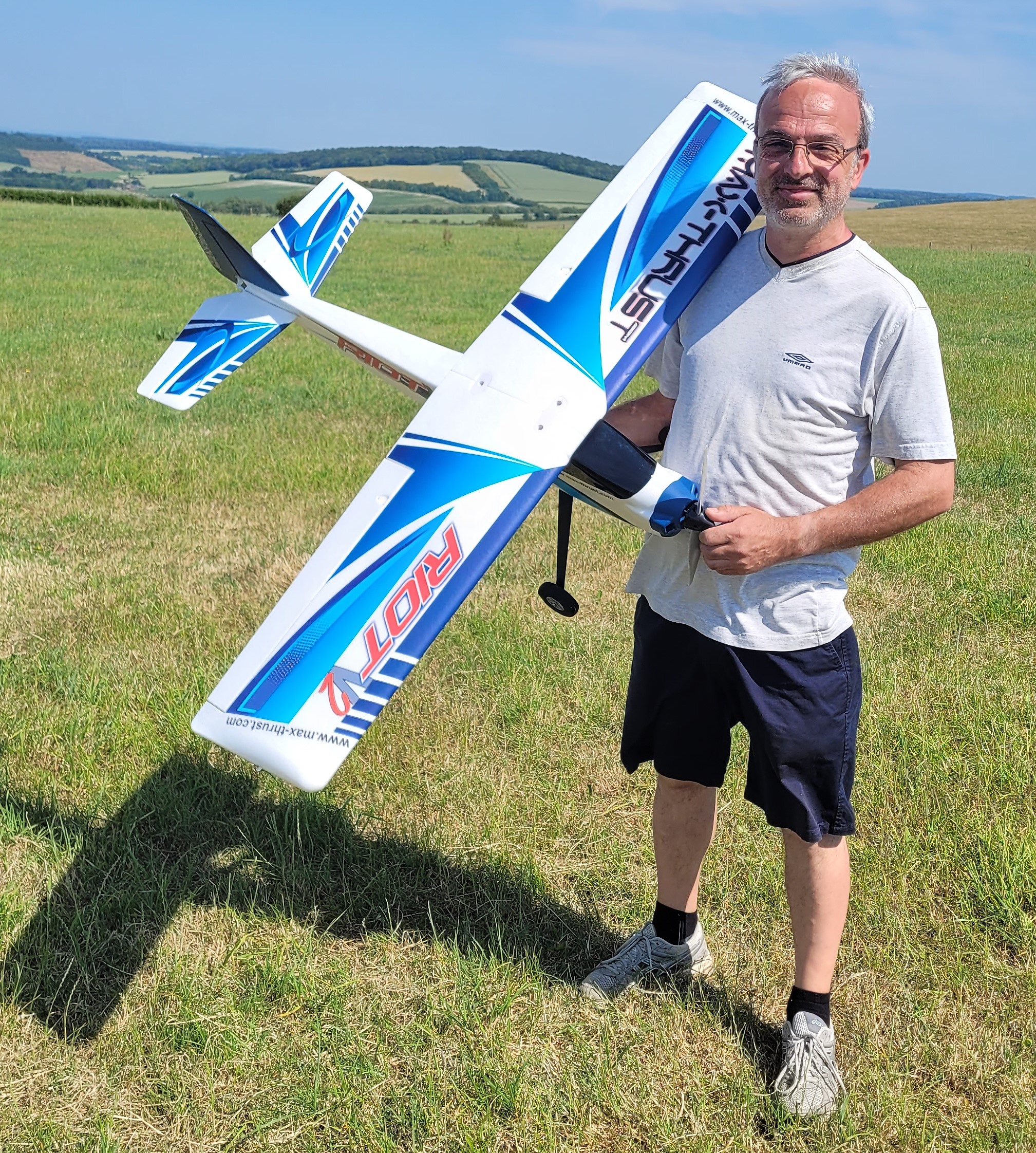
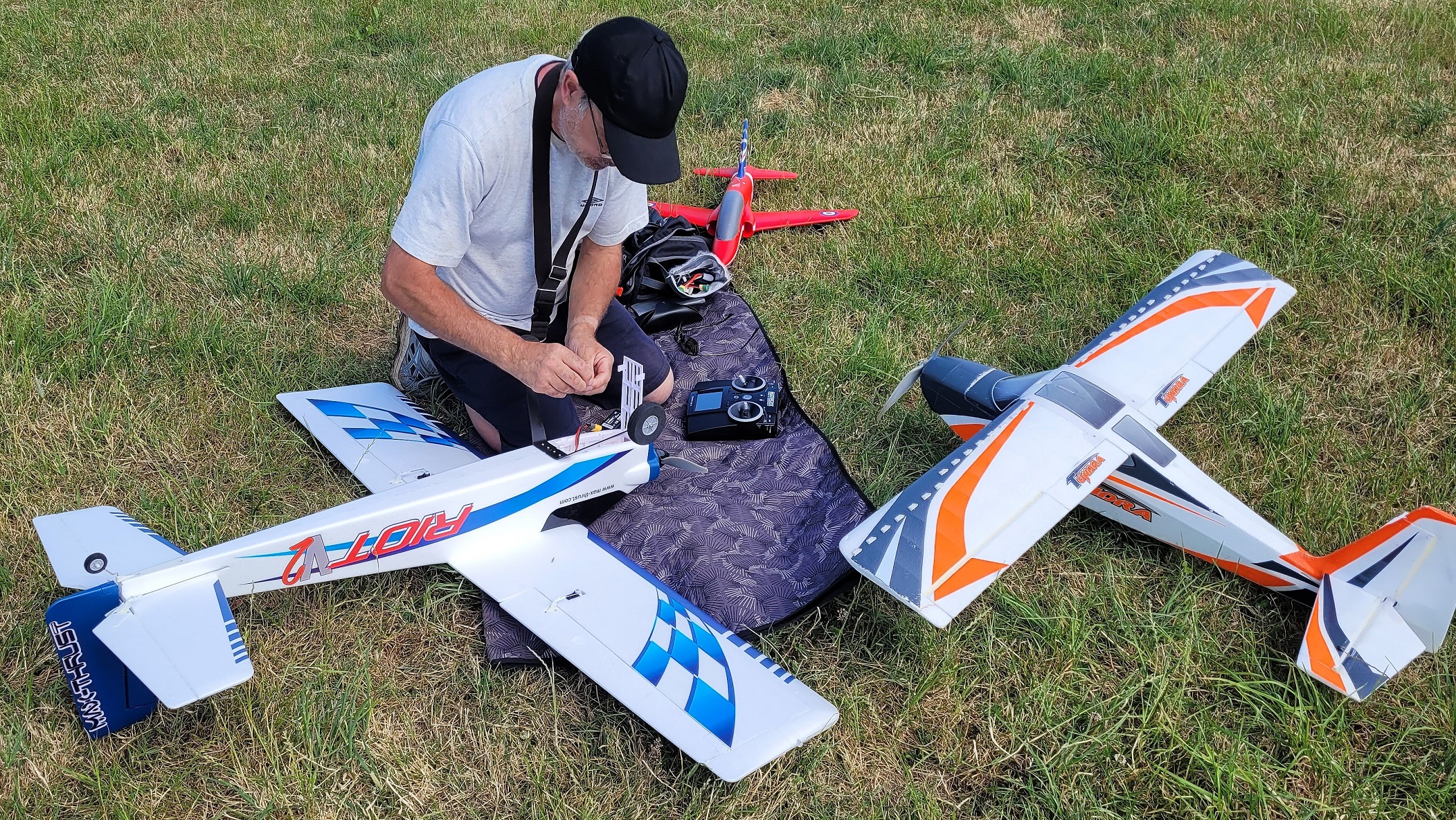 There are several Riots in the club and they perform well, a good alternative to a Wot4. Mike flew his the following Sunday but was rather disappointed by the lack of power.
There are several Riots in the club and they perform well, a good alternative to a Wot4. Mike flew his the following Sunday but was rather disappointed by the lack of power.
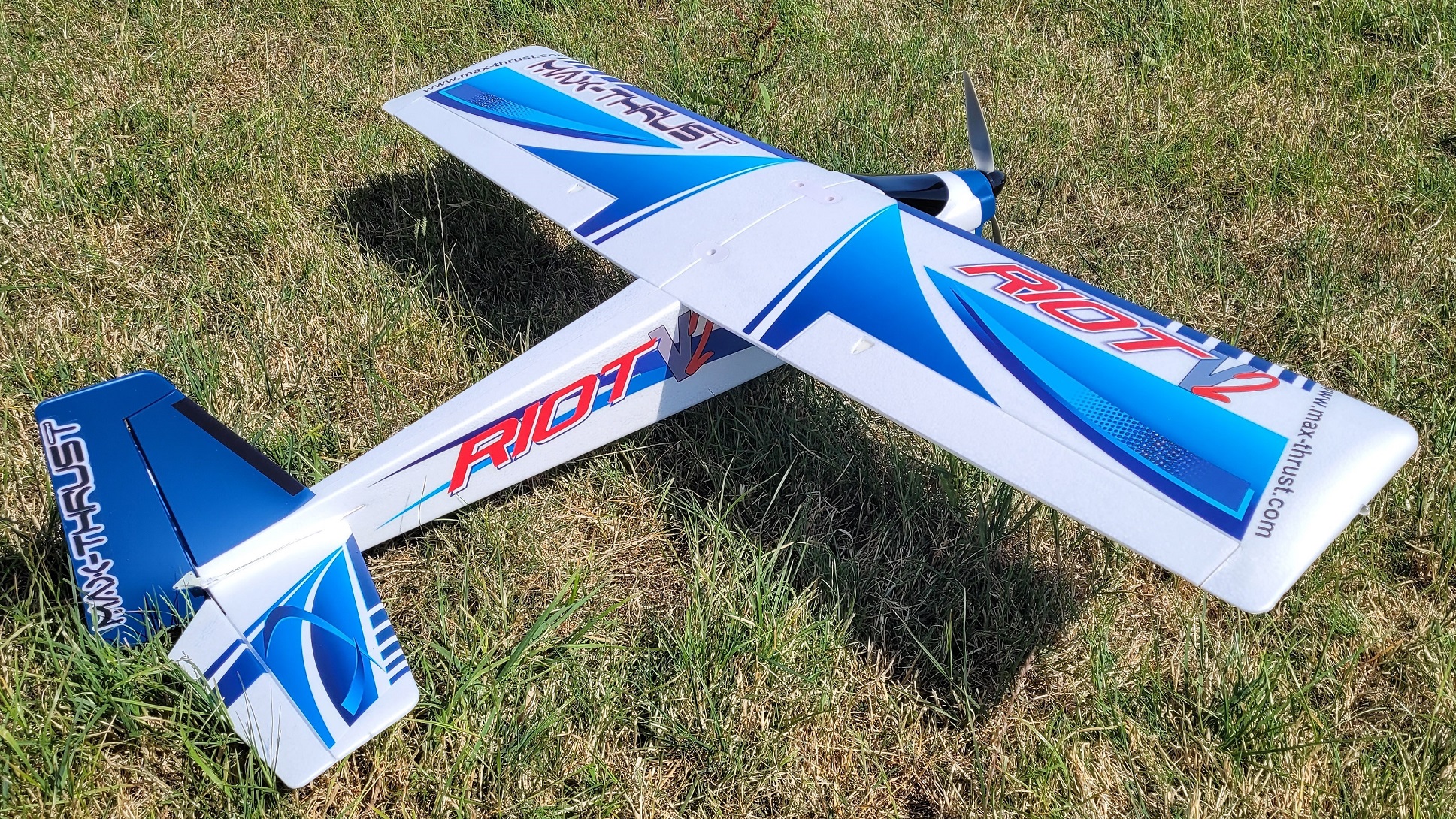 It seems odd as mine has always been fine, certainly not overpowered but adequate, it won’t prop-hang but it’s not far off. Mike says that apparently Max Thrust have recently reduced the prop size and now say that it can be flown on 4 cells as well as the original 3 so maybe that’s it. Although Max Thrust say it can take 4 cells they haven’t altered the size of the battery box, the depth of which was already very tight for some 3 cell packs. So there you go Mike, you’ll have to either fit a larger prop or hack the battery box around a bit!
My wife and I were on holiday in Shropshire for part of the month and while we were there Woody kindly pointed out that the Weston Park Air Show International was on nearby. Well it would be rude not to go wouldn’t it? We went along on Friday 16th to avoid the major queues and crowds and spent the day watching lots of excellent flying and browsing the trade stands. The weather was hot and sunny with light winds so perfect for flying.
It seems odd as mine has always been fine, certainly not overpowered but adequate, it won’t prop-hang but it’s not far off. Mike says that apparently Max Thrust have recently reduced the prop size and now say that it can be flown on 4 cells as well as the original 3 so maybe that’s it. Although Max Thrust say it can take 4 cells they haven’t altered the size of the battery box, the depth of which was already very tight for some 3 cell packs. So there you go Mike, you’ll have to either fit a larger prop or hack the battery box around a bit!
My wife and I were on holiday in Shropshire for part of the month and while we were there Woody kindly pointed out that the Weston Park Air Show International was on nearby. Well it would be rude not to go wouldn’t it? We went along on Friday 16th to avoid the major queues and crowds and spent the day watching lots of excellent flying and browsing the trade stands. The weather was hot and sunny with light winds so perfect for flying.
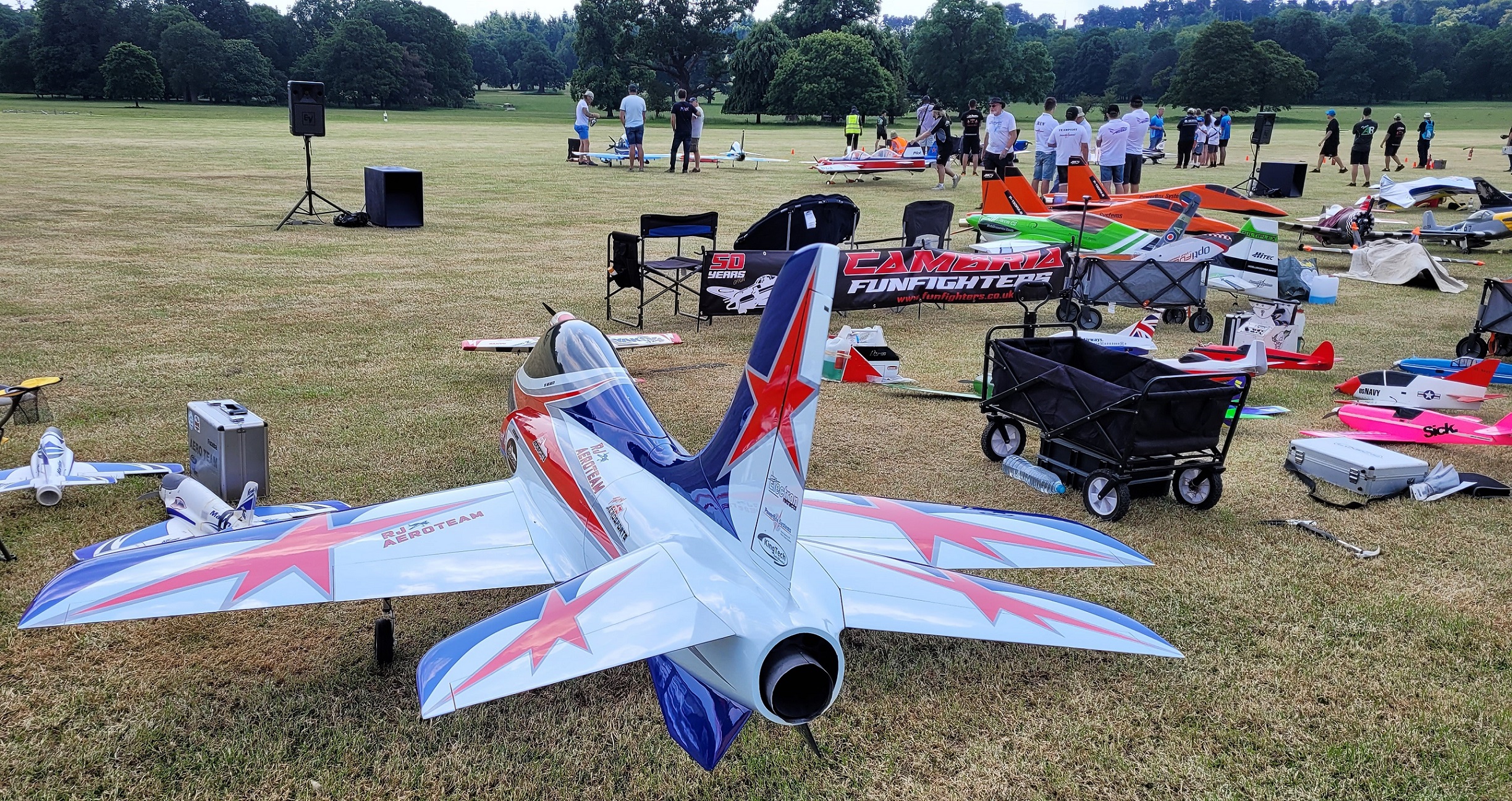 Several international individuals and teams were present but I expect more arrived to fly on the Saturday and Sunday. The event includes some full-size aircraft displays but we didn’t see any on the Friday although we left around 3.30pm so we may have missed them.
Several international individuals and teams were present but I expect more arrived to fly on the Saturday and Sunday. The event includes some full-size aircraft displays but we didn’t see any on the Friday although we left around 3.30pm so we may have missed them. 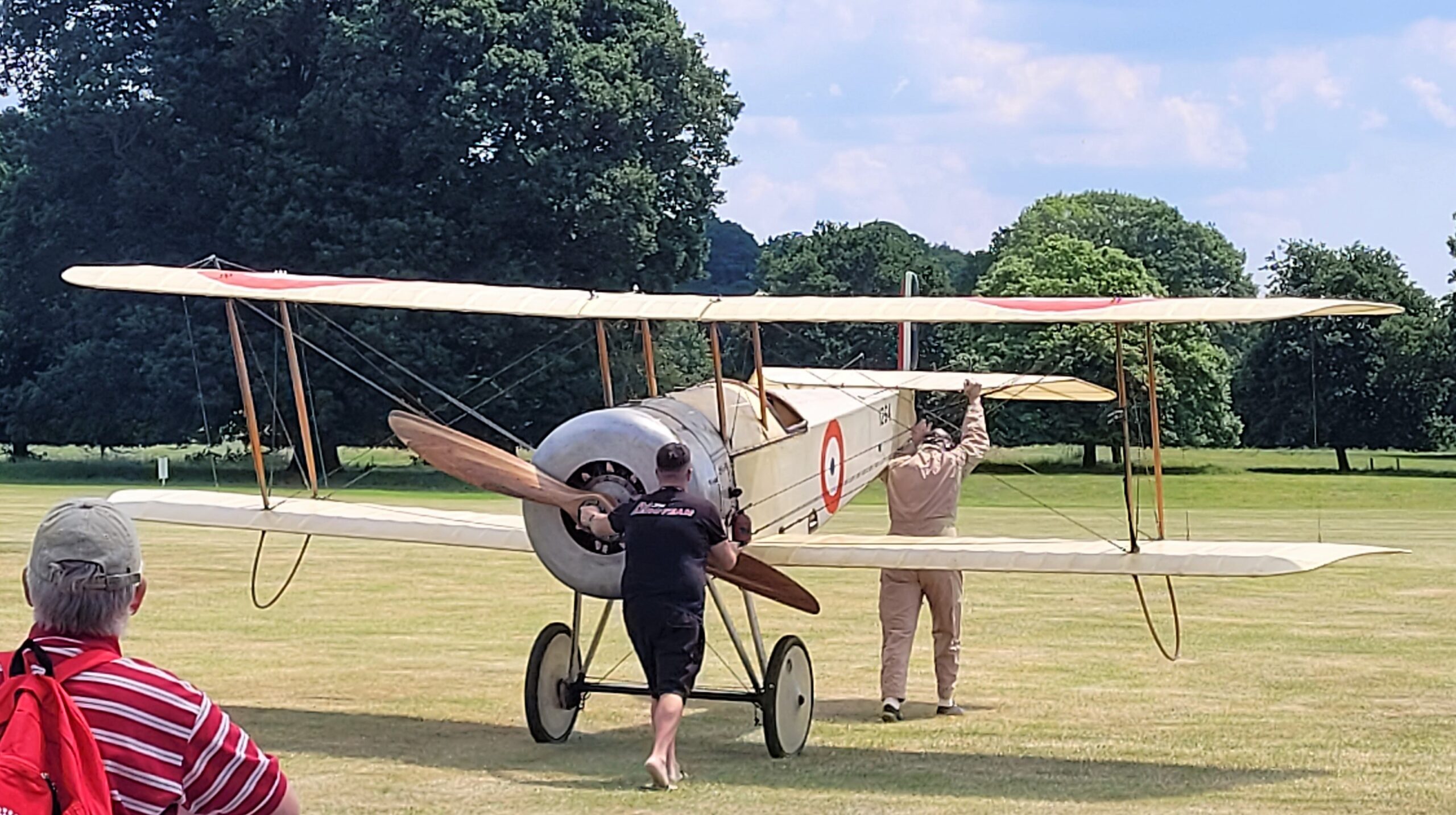 There was a Bristol Scout from Shuttleworth on the flight-line but it didn’t fly for some reason, it only did a taxi run. It was nice to see it and to hear the rotary engine but a flight would have been better. The light wind was across the strip so maybe that was the reason.
I spotted this van parked up amongst the traders, I wonder which dealer owned it?!
There was a Bristol Scout from Shuttleworth on the flight-line but it didn’t fly for some reason, it only did a taxi run. It was nice to see it and to hear the rotary engine but a flight would have been better. The light wind was across the strip so maybe that was the reason.
I spotted this van parked up amongst the traders, I wonder which dealer owned it?!
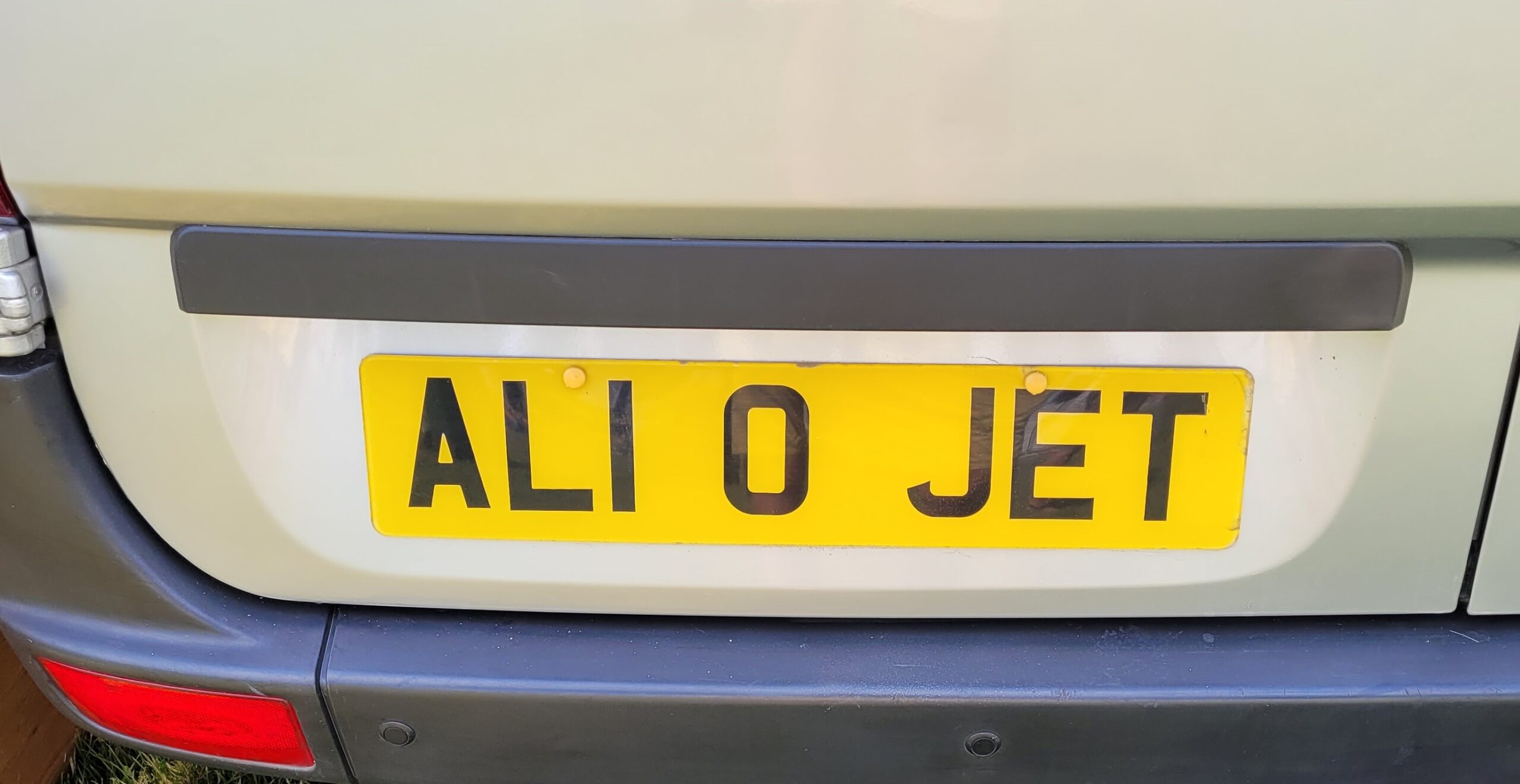 I took quite a lot of photos at the show so here’s a general selection for you:
I took quite a lot of photos at the show so here’s a general selection for you:

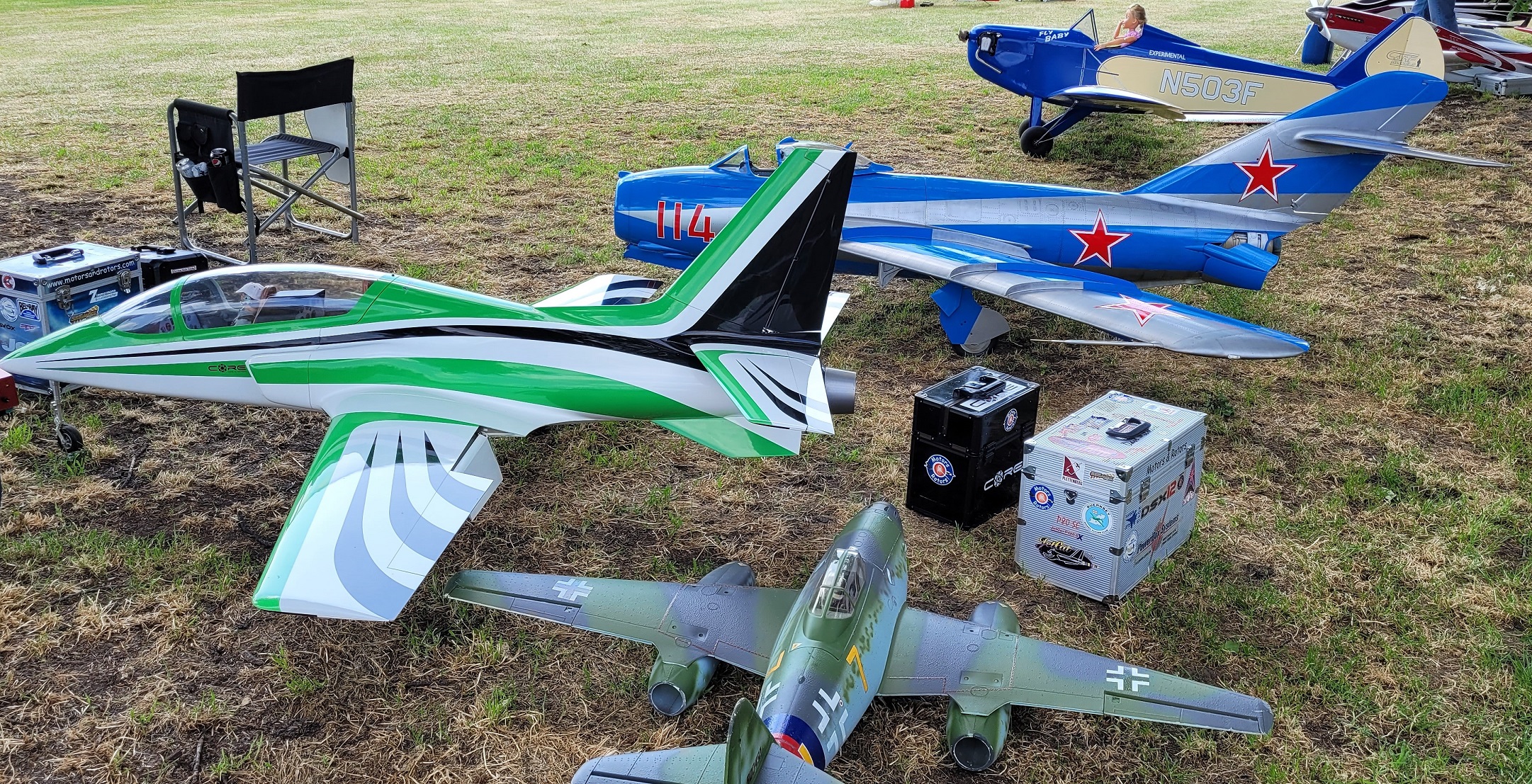
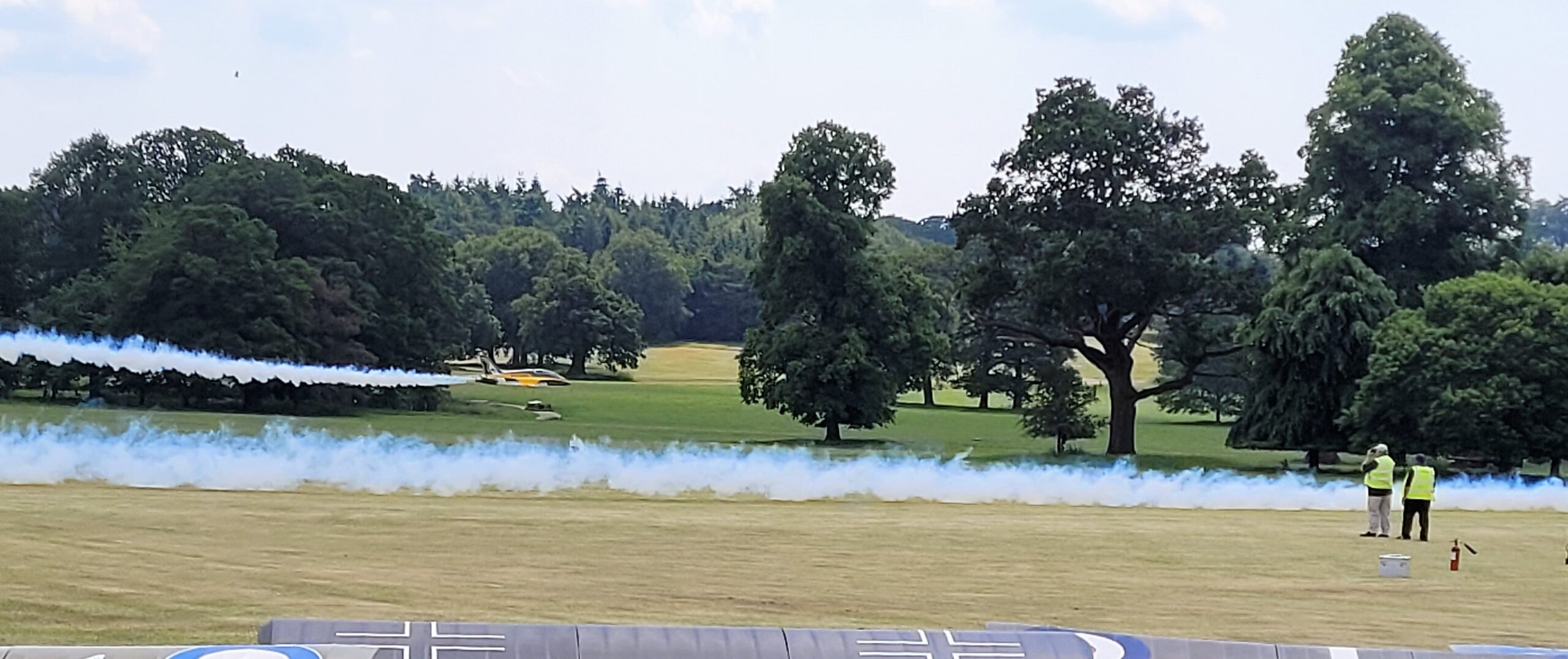

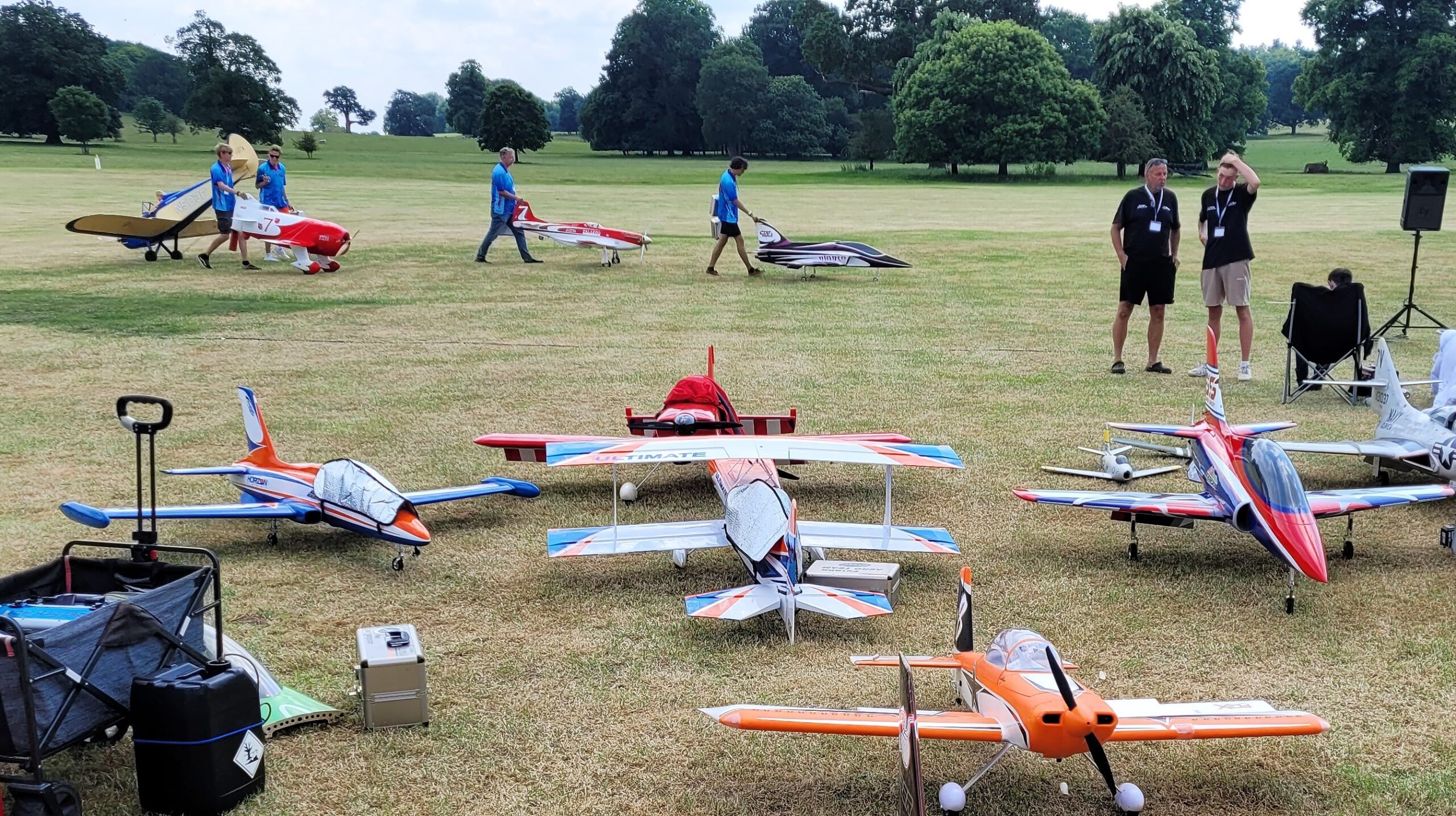
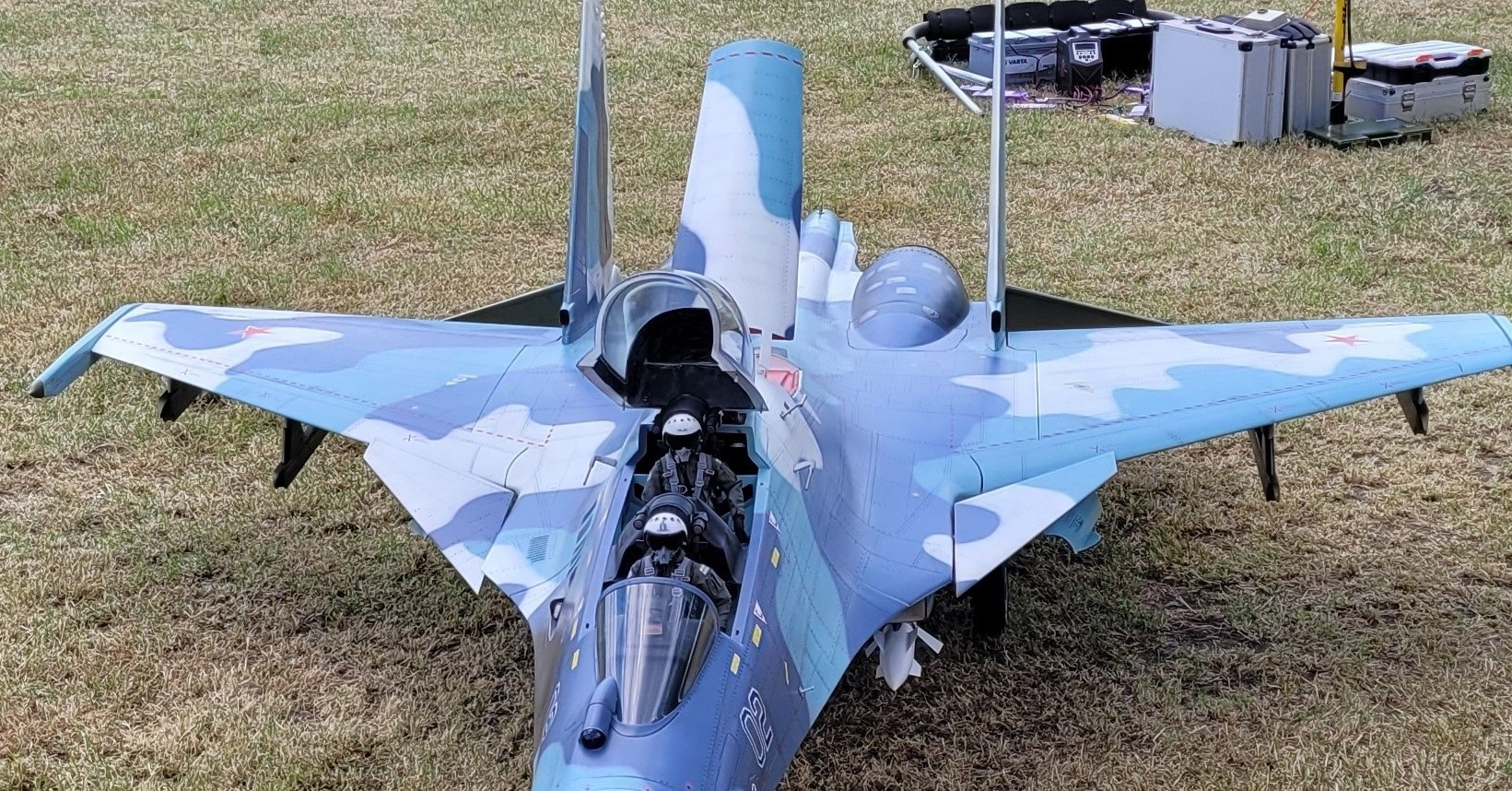
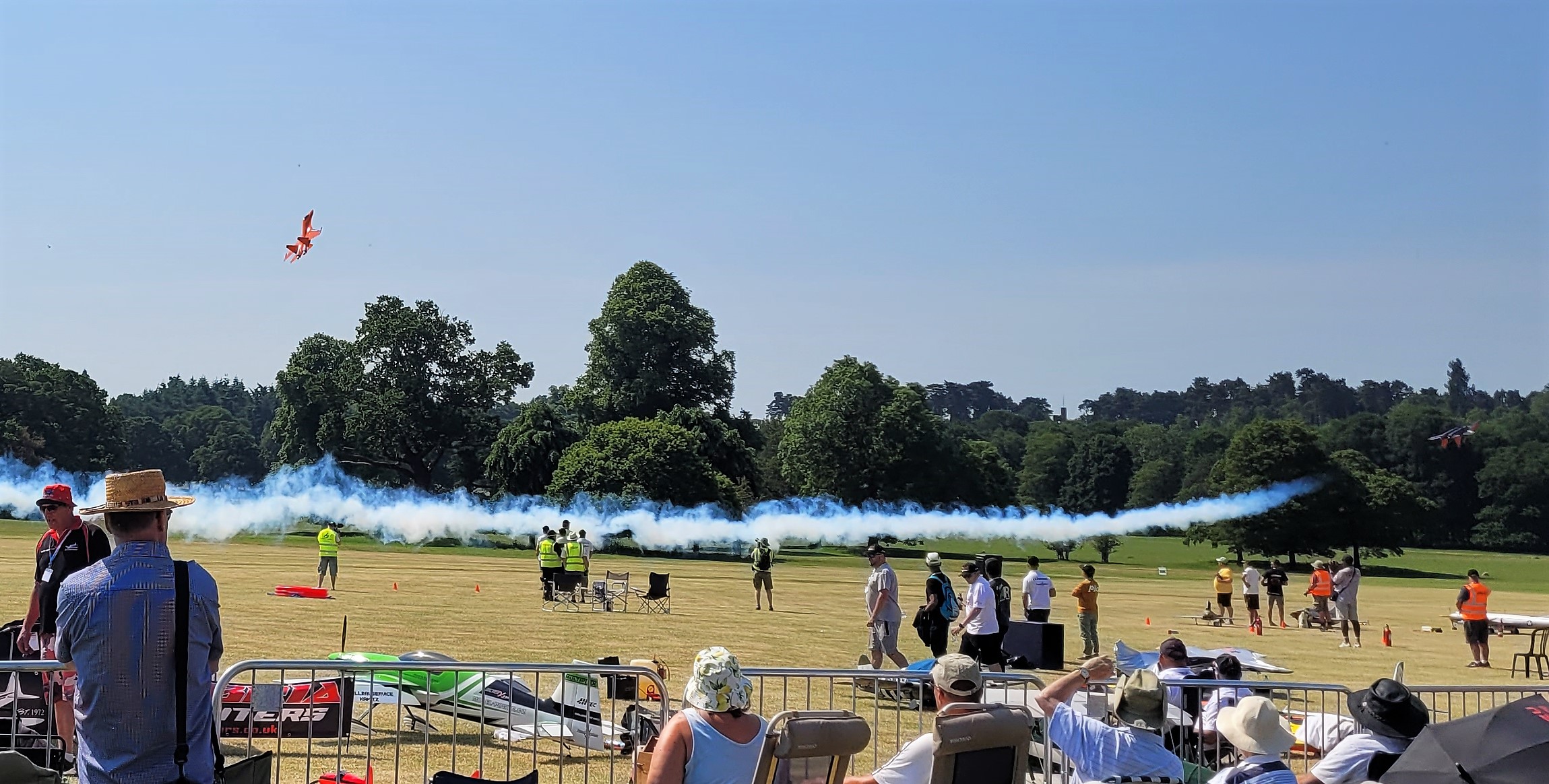
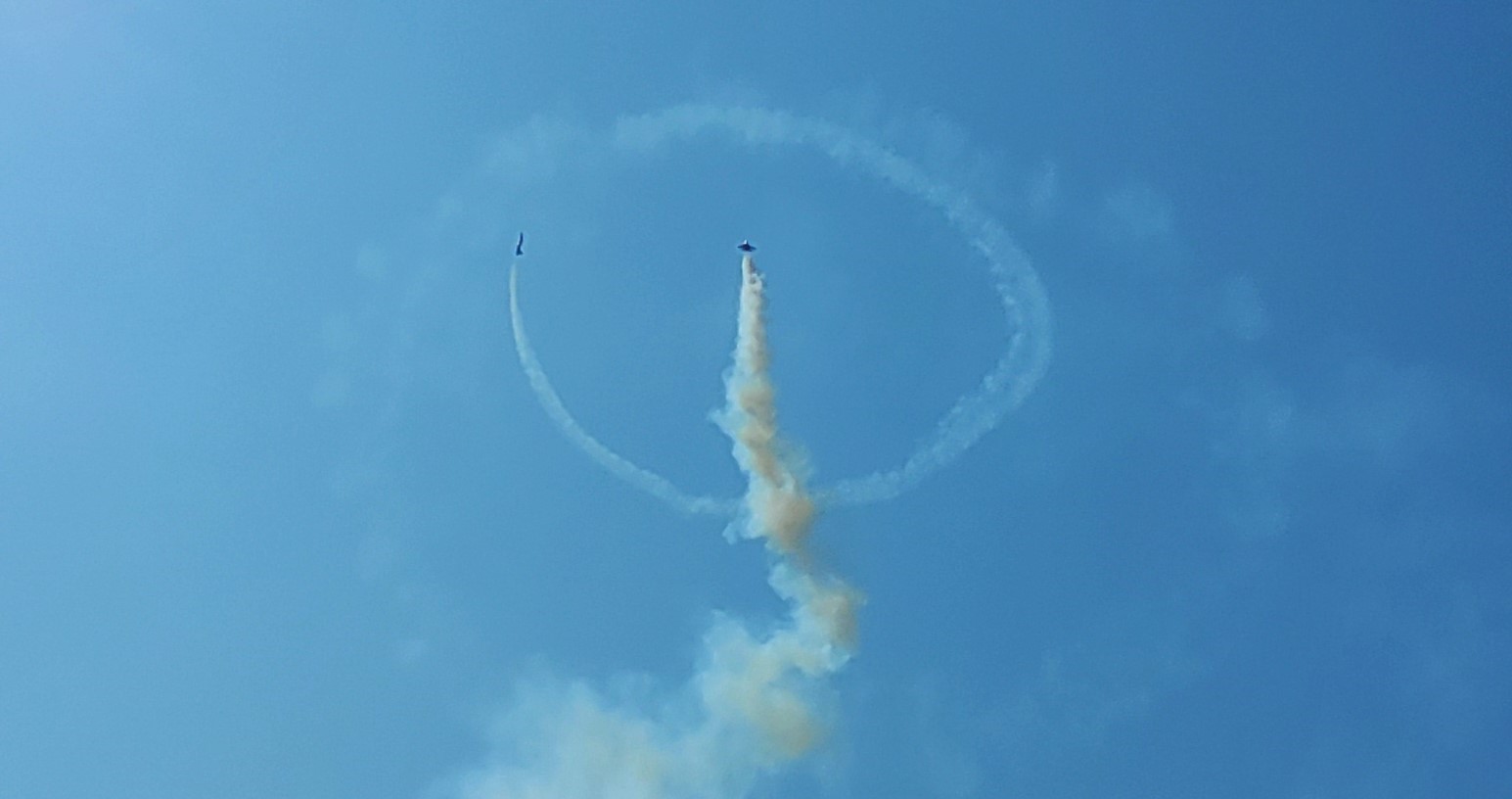 I also shot some video, it’s not the best quality but should give you an idea of the sort of displays we saw. Unfortunately for you I was too busy enjoying the jets to film many:
Patch News video time now this month with footage by me, Dougal, Gordon, and Peter. Please watch the video full-screen, it’s so much better with small models flying about.
If the video won’t play for you please click HERE
It was the young pilot’s first day and he was struggling in his light aircraft.
Control tower: “Can you give me your position?”
Pilot: “I am next to a cloud that looks like a lion.”
Control tower: “Can you be more specific?”
Pilot: “Simba…”
Colin Cowplain
I also shot some video, it’s not the best quality but should give you an idea of the sort of displays we saw. Unfortunately for you I was too busy enjoying the jets to film many:
Patch News video time now this month with footage by me, Dougal, Gordon, and Peter. Please watch the video full-screen, it’s so much better with small models flying about.
If the video won’t play for you please click HERE
It was the young pilot’s first day and he was struggling in his light aircraft.
Control tower: “Can you give me your position?”
Pilot: “I am next to a cloud that looks like a lion.”
Control tower: “Can you be more specific?”
Pilot: “Simba…”
Colin Cowplain Patch News – May 2023
Although there were a few not so nice days in May we mostly had great flying weather and many PAM members made the most of it. Of course the mix of warm sunshine and just very occasional showers meant the grass grew quickly and the patch needed quite a lot of attention so the big guns were brought out, both the club mowers instead of just the one!
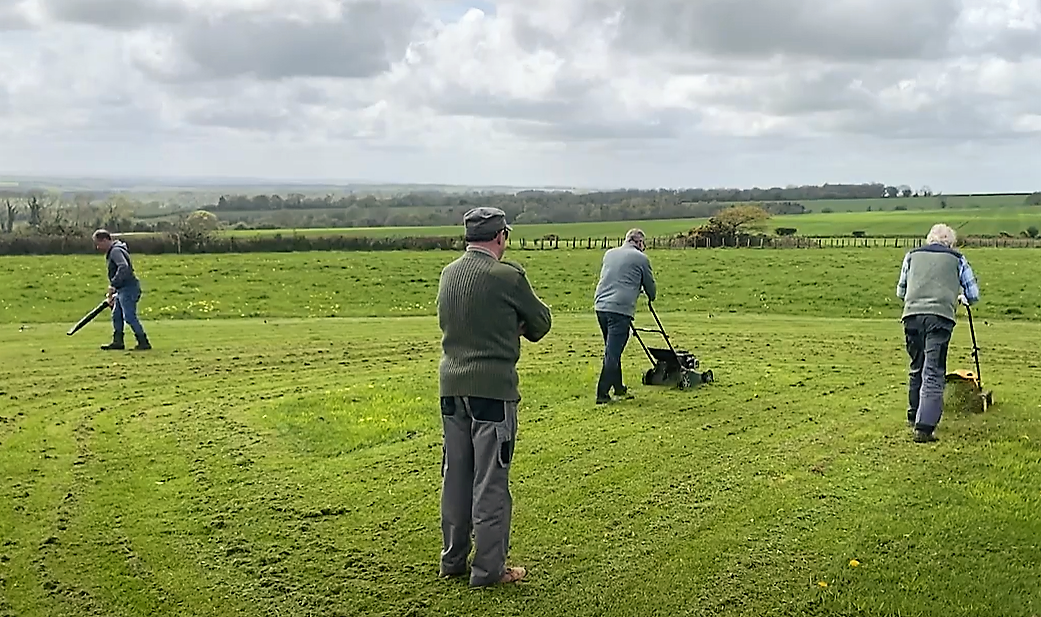 Also Woody brought along his leaf blower to help shift the grass cuttings and after being suitably supervised by Captain Slow the patch was soon back in near perfect condition.
Also Woody brought along his leaf blower to help shift the grass cuttings and after being suitably supervised by Captain Slow the patch was soon back in near perfect condition.
 The field was used for car parking for the Sustainability Centre Green Fayre on 7th May so no flying was allowed and the electric fence was suitably adorned with red and white tape so none of the Chelsea tractors would drive right through it having failed to see it. Farmer George had previously said the bullocks would return soon after the Green Fayre but the grass (not the patch) had got very long so George decided to cut it for a crop.
The field was used for car parking for the Sustainability Centre Green Fayre on 7th May so no flying was allowed and the electric fence was suitably adorned with red and white tape so none of the Chelsea tractors would drive right through it having failed to see it. Farmer George had previously said the bullocks would return soon after the Green Fayre but the grass (not the patch) had got very long so George decided to cut it for a crop.
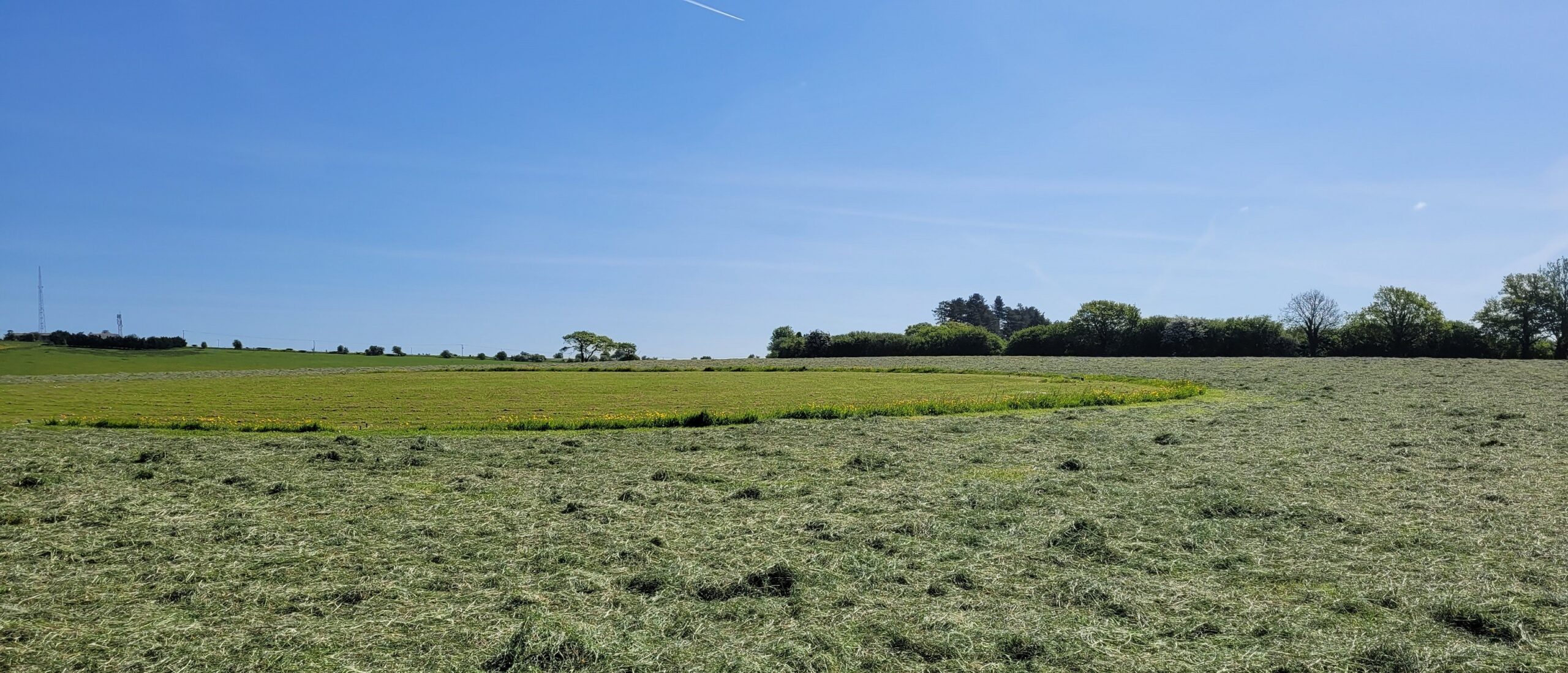 At the time of writing the cut grass is drying out in the glorious sunshine but will no doubt be baled and removed to the barn shortly, all good news for us as it means the whole field now has short grass and the bullocks won’t return for several weeks.
At the time of writing the cut grass is drying out in the glorious sunshine but will no doubt be baled and removed to the barn shortly, all good news for us as it means the whole field now has short grass and the bullocks won’t return for several weeks.
The main event of the month was the follow on from the 2022 BMFA Centenary Event during which 3109 models were flown at once at 263 flying sites across the UK in an attempt to set a world record for the number of models airborne at the same time.
It proved very popular so the BMFA decided to do it all again on 14th May this year. Unfortunately last year there was heavy rain at our field so the only plane that was able to qualify was Captain Slow’s RC Paper Plane which managed a brief flight in the barn!
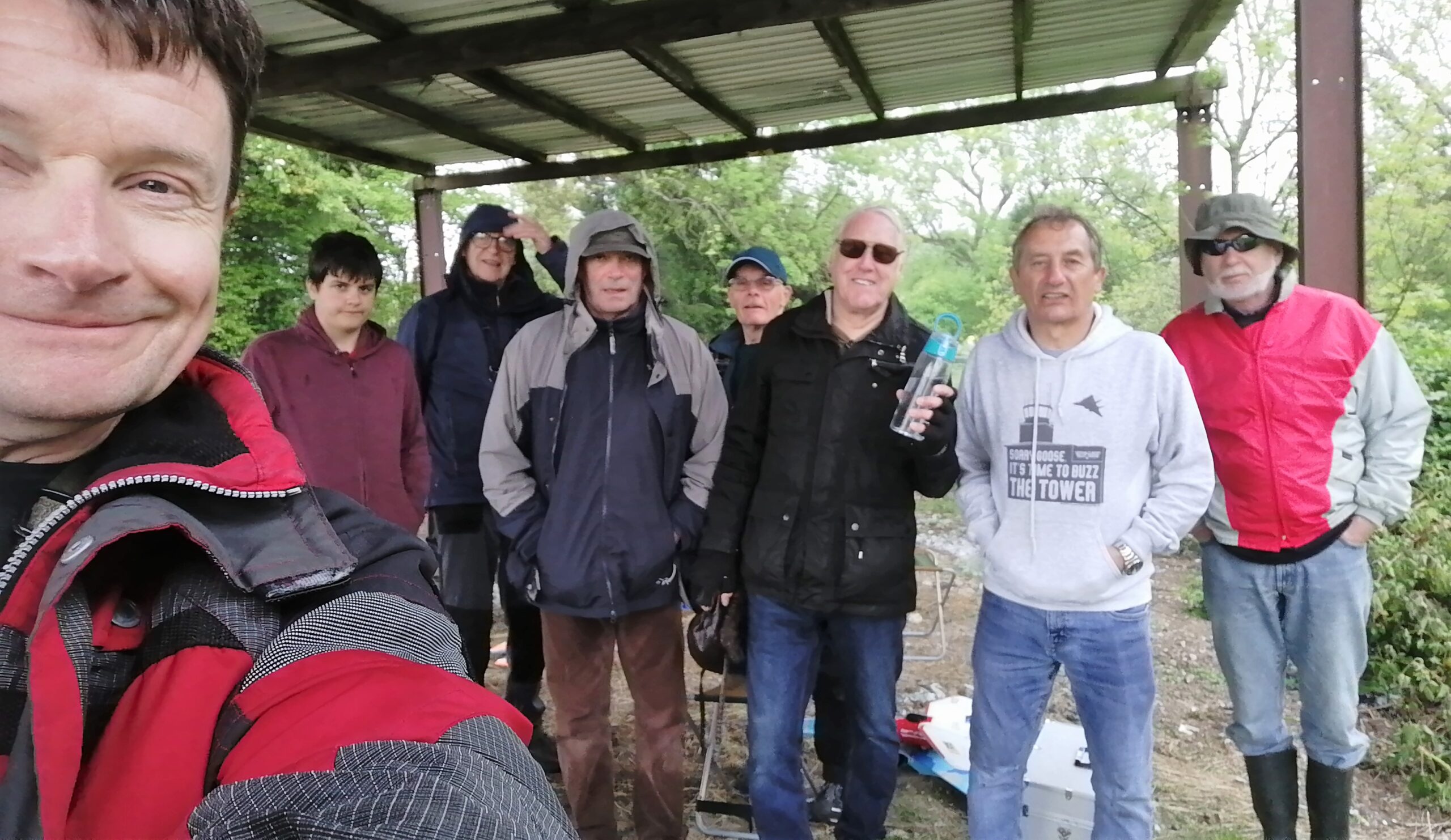 This year the weather was ideal and, as before, the idea was to have as many models in the air as possible at 12 noon. Chairman Gordon Bennett completed all the necessary paperwork for the BMFA and also wrote this report of the day for them:
This year the weather was ideal and, as before, the idea was to have as many models in the air as possible at 12 noon. Chairman Gordon Bennett completed all the necessary paperwork for the BMFA and also wrote this report of the day for them:
Sunday started cold and misty up at our site but we kept warm by virtue of the fact we needed to mow the grass! We have a 30m circular patch and with a couple of mowers cutting in ever-decreasing circles we had the job done very quickly, the members taking turns of a couple of circuits each. By this time the sun had broken through, the mist burnt off and the temperature rose rapidly. Conditions were perfect with light and variable winds, a complete change from last year when heavy rain scuppered our day.
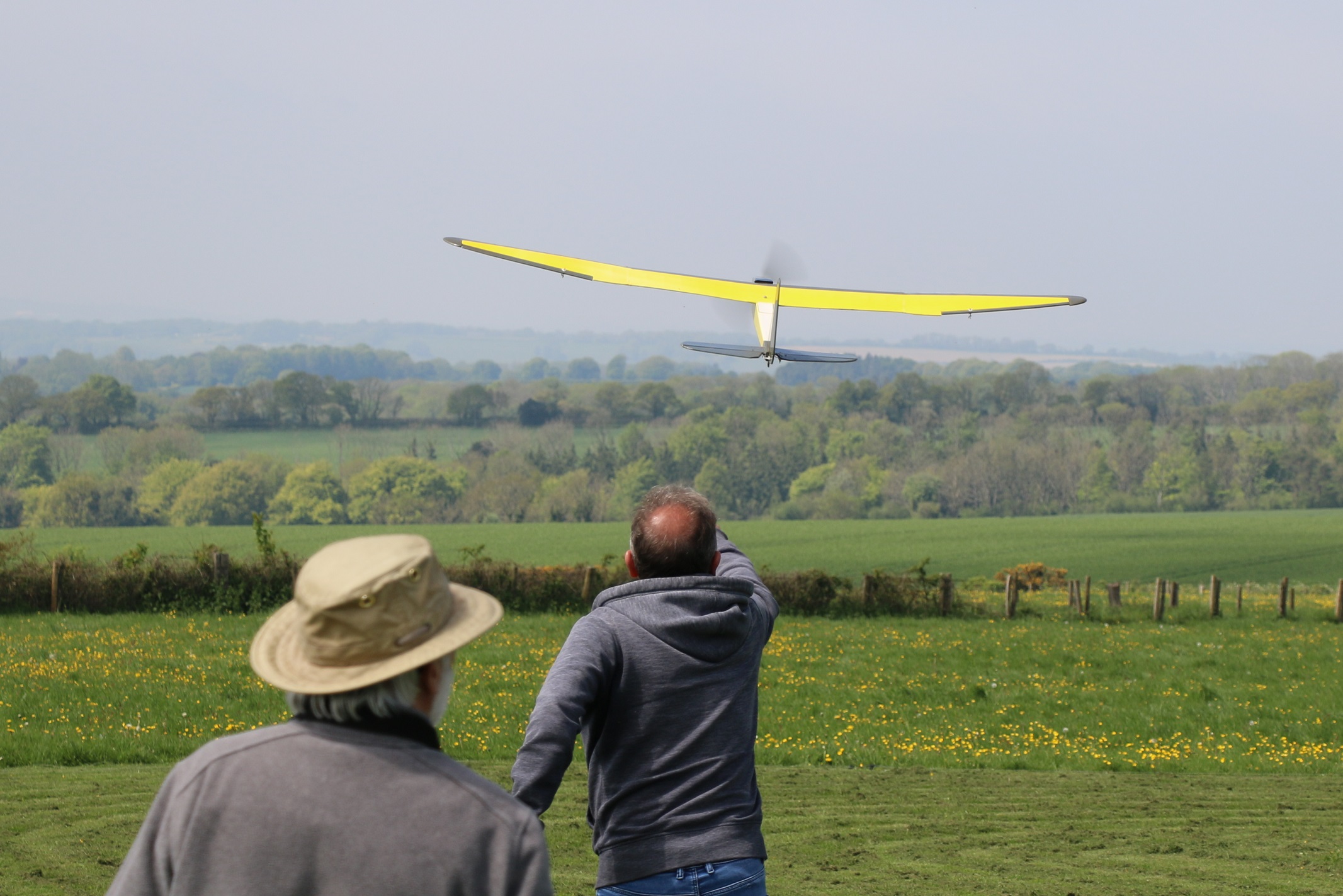 We had a great morning’s general flying, all models were electric-powered and one pilot flying FPV (with a trusted spotter). Around 11.45 general flying ceased as aircraft were prepared for the midday attempt. 12 pilots had come up for the attempt but one unluckily had a radio problem so we had a total of 11 aircraft in the air just before midday.
We had a great morning’s general flying, all models were electric-powered and one pilot flying FPV (with a trusted spotter). Around 11.45 general flying ceased as aircraft were prepared for the midday attempt. 12 pilots had come up for the attempt but one unluckily had a radio problem so we had a total of 11 aircraft in the air just before midday.
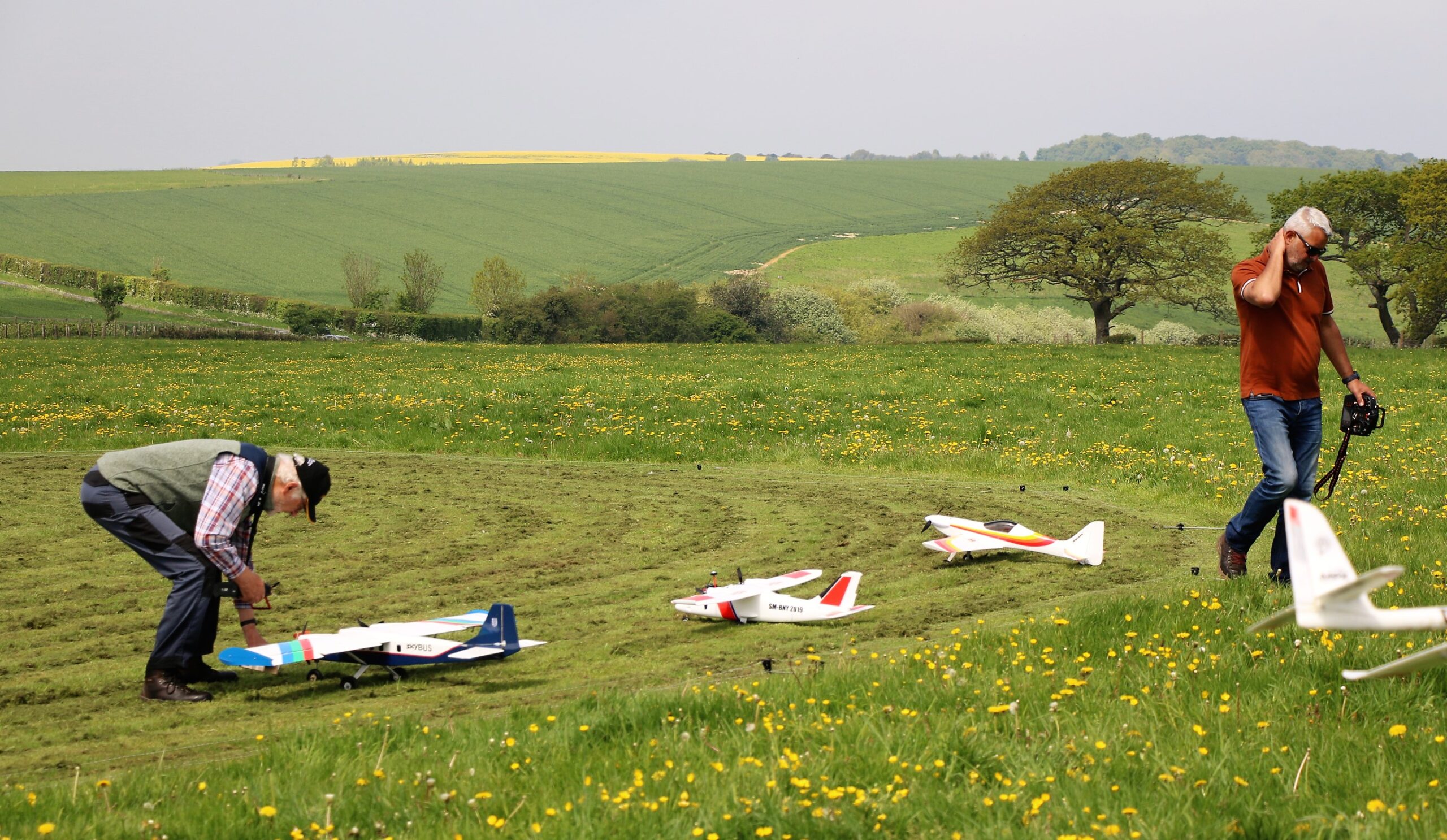
 The fleet included motor gliders, foam boards, foamies, a couple of twins (both carrying video cameras) and two miniatures. Our site is in a beautiful rural location on the crown of a hill with views down to the Solent and Isle of Wight. We often have Red Kites joining us in the air as they take a bit of interest in what we’re up to. It would appear they were in on the deal as two Kites joined the circuit at the stroke of 12 and stayed for a couple of minutes, sadly I didn’t get the opportunity to get their BMFA membership details!
The fleet included motor gliders, foam boards, foamies, a couple of twins (both carrying video cameras) and two miniatures. Our site is in a beautiful rural location on the crown of a hill with views down to the Solent and Isle of Wight. We often have Red Kites joining us in the air as they take a bit of interest in what we’re up to. It would appear they were in on the deal as two Kites joined the circuit at the stroke of 12 and stayed for a couple of minutes, sadly I didn’t get the opportunity to get their BMFA membership details!
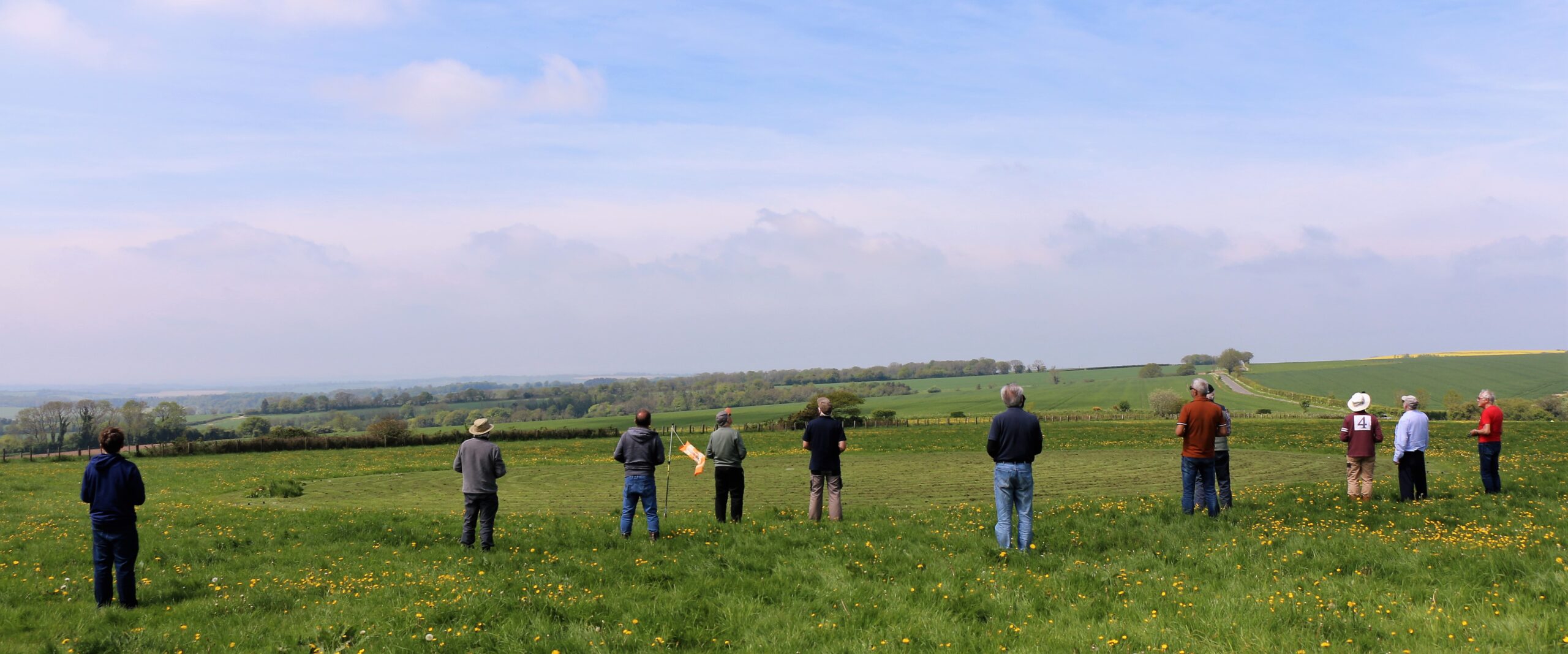 All aircraft got back safe and sound but the pilot of one of the motor gliders was off thermalling so had to be gently requested to land so that we could get the group photo.
All aircraft got back safe and sound but the pilot of one of the motor gliders was off thermalling so had to be gently requested to land so that we could get the group photo. 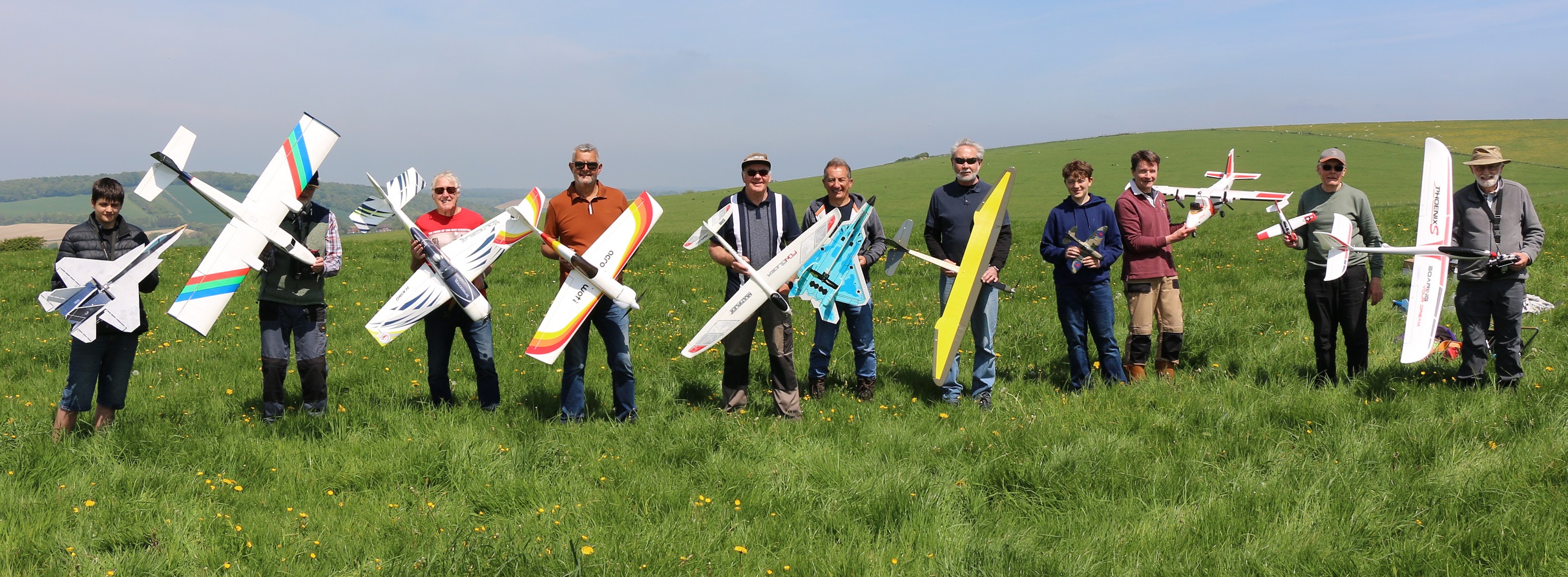 The FPV aircraft captured a video showing 7 aircraft in the frame, we’ve uploaded a still from the camera. A great day had by all, I’m sure we’ll be up for it again next year.
The FPV aircraft captured a video showing 7 aircraft in the frame, we’ve uploaded a still from the camera. A great day had by all, I’m sure we’ll be up for it again next year.
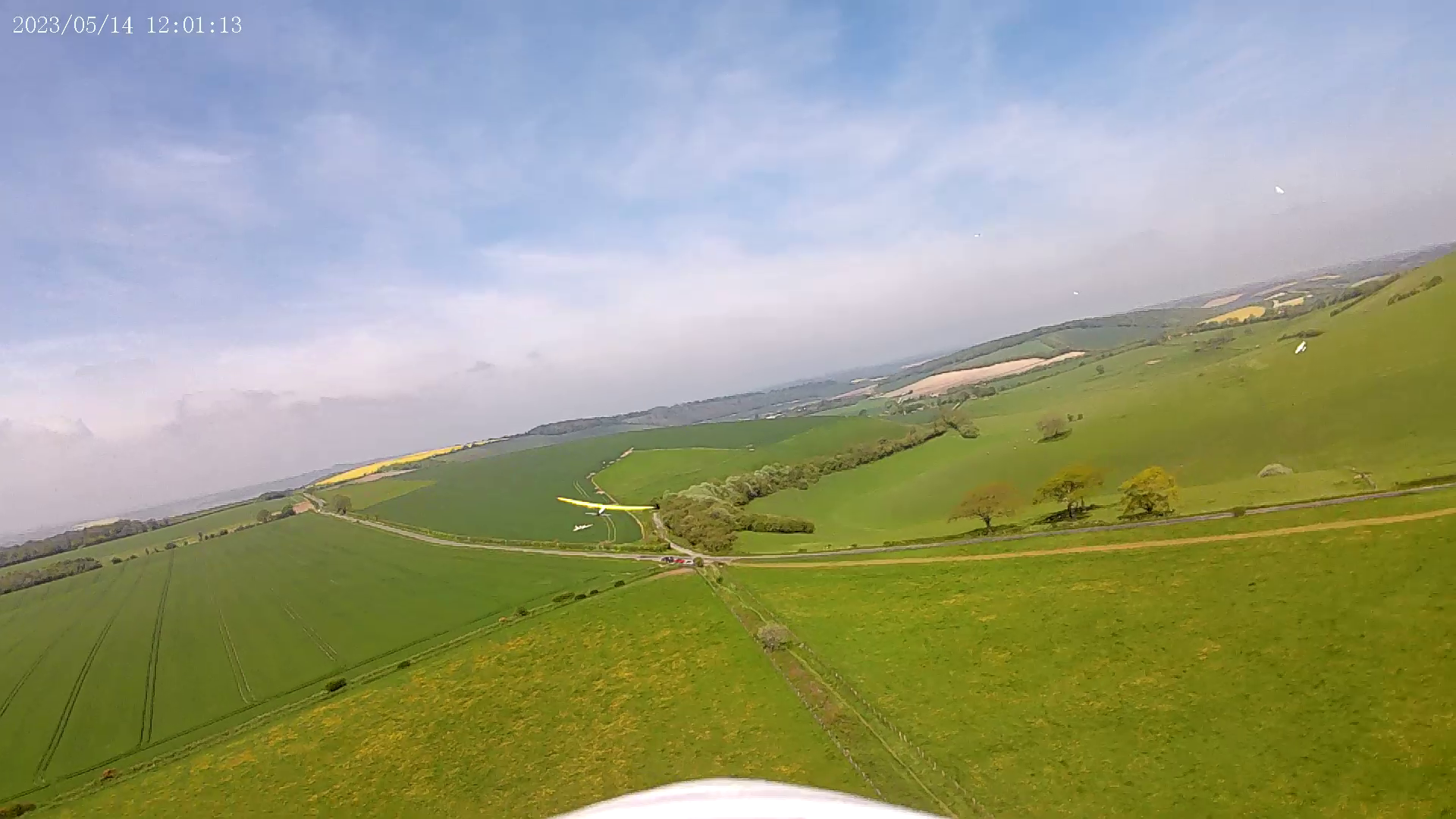 It was the unfortunate Kryten who had last minute radio problems and was unable to fly. Kryten insists the problem turned out to be a dodgy switch and nothing to do with his superior Spektrum radio…! Dougal Entendre flew his FPV model so he was able to film some of the action and it was his screenshot taken from the video in which he has circled 6 of the models so, including his plane that’s 7 of the 11 in the air, not a bad achievement.
It was the unfortunate Kryten who had last minute radio problems and was unable to fly. Kryten insists the problem turned out to be a dodgy switch and nothing to do with his superior Spektrum radio…! Dougal Entendre flew his FPV model so he was able to film some of the action and it was his screenshot taken from the video in which he has circled 6 of the models so, including his plane that’s 7 of the 11 in the air, not a bad achievement. 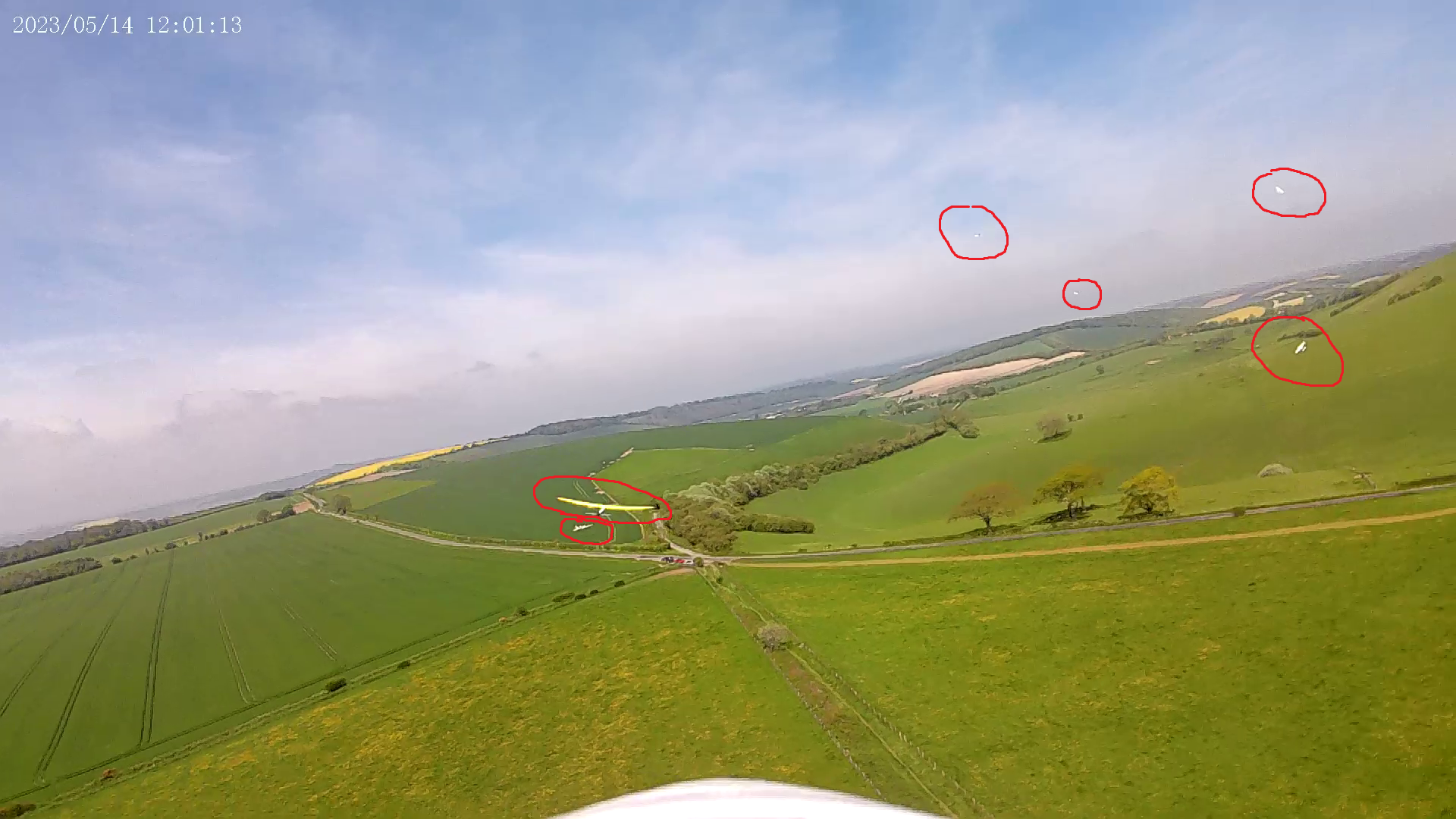 Dougal certainly had plenty of targets of targets to follow and in this month’s video you’ll see footage taken from Dougal’s plane and also some video shot from the ground.
Dougal certainly had plenty of targets of targets to follow and in this month’s video you’ll see footage taken from Dougal’s plane and also some video shot from the ground.
The last time Mini-Mike flew his large Partenavia Victor he incurred a bit of damage to the fibreglass fuselage with a dodgy landing. He managed to complete the necessary and tricky repairs without too much trouble and at the beginning of May he brought it out for a few more flights. However, just a couple of minutes into the first flight of the day one of the motors didn’t appear to be running correctly and he seemed to be getting asymmetric thrust. Mike wisely decided to throttle right back and land immediately rather than risk losing one motor completely and fortunately he was able to land with no damage.
 Typically, once back of the ground both motors appeared to run perfectly with no signs of any problems but Mike decided not to risk another flight and took the model off to his workshop to try and figure out what the problem could be.
Typically, once back of the ground both motors appeared to run perfectly with no signs of any problems but Mike decided not to risk another flight and took the model off to his workshop to try and figure out what the problem could be.
Leo is becoming well known in the club for his ability to repair just about any model however badly damaged, and also build new ones in record breaking time. He is always on the lookout for something to repair so if you have any broken planes that you won’t get round to fixing Leo would love to take them off your hands and get them back in the air. In May he built a Phoebe foam model that had been featured in the May edition of RCM&E.
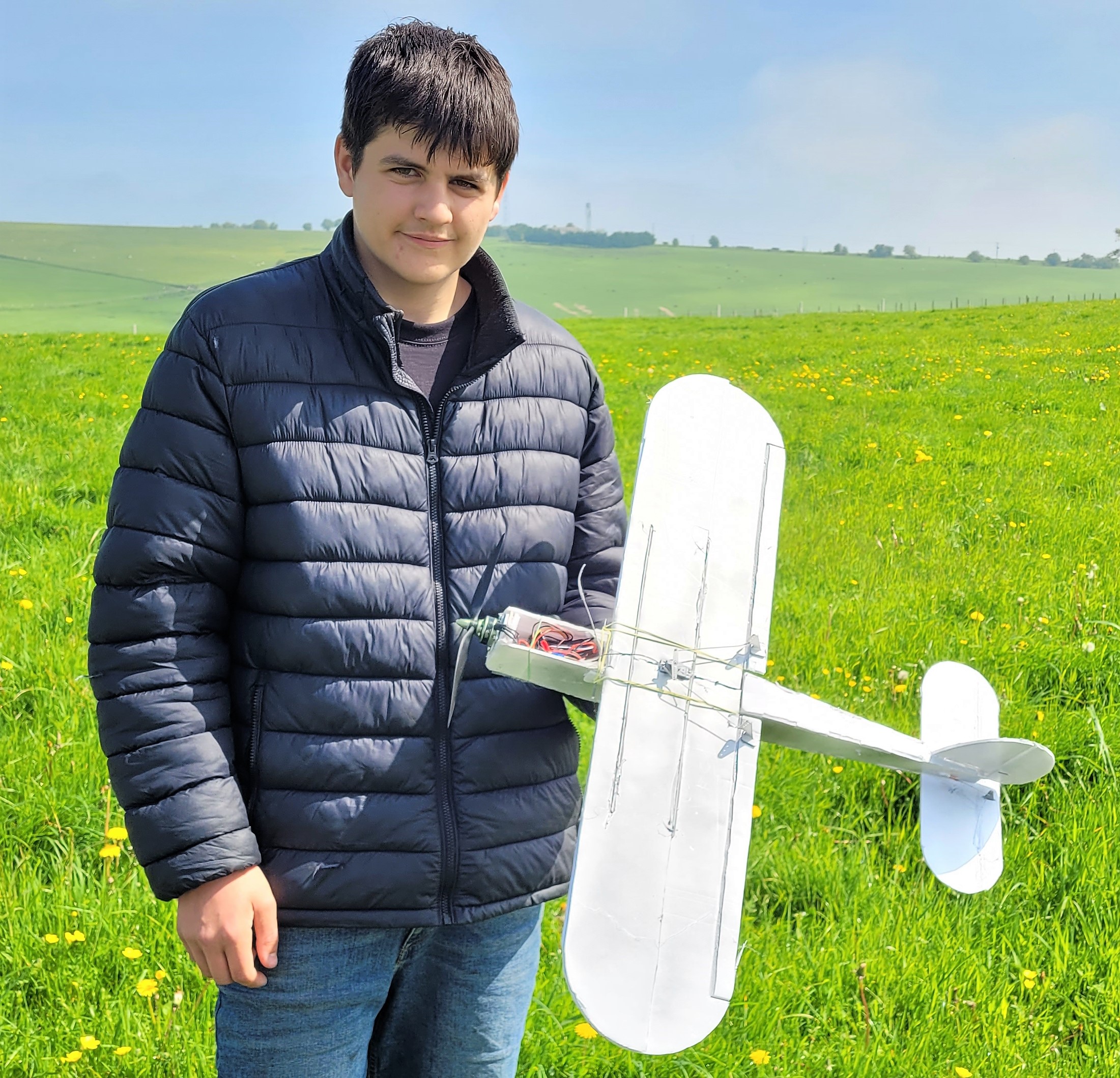 The Phoebe was designed by Bill Bowne and is a simple 29” span high wing trainer type.
The Phoebe was designed by Bill Bowne and is a simple 29” span high wing trainer type.
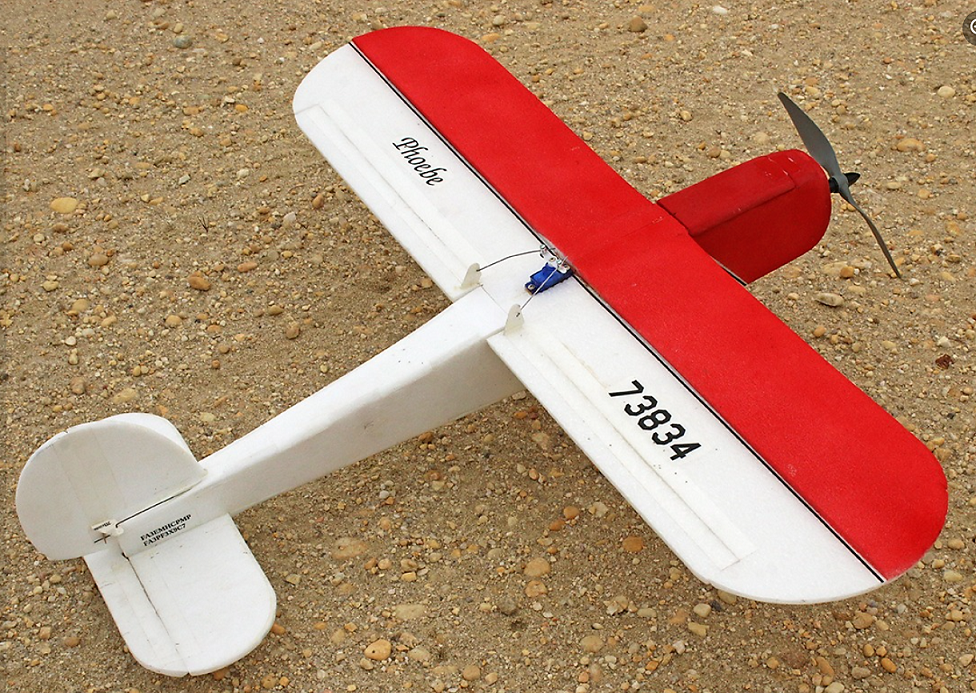 Leo says he thought about building it at 1pm, bought the bits he needed for it at 1.30pm, had it built by 3pm, and flew it at 6pm! Leo fitted his Phoebe with a MultiStar Elite 2204 2300kv motor which seems to provide more than enough go.
Leo says he thought about building it at 1pm, bought the bits he needed for it at 1.30pm, had it built by 3pm, and flew it at 6pm! Leo fitted his Phoebe with a MultiStar Elite 2204 2300kv motor which seems to provide more than enough go.
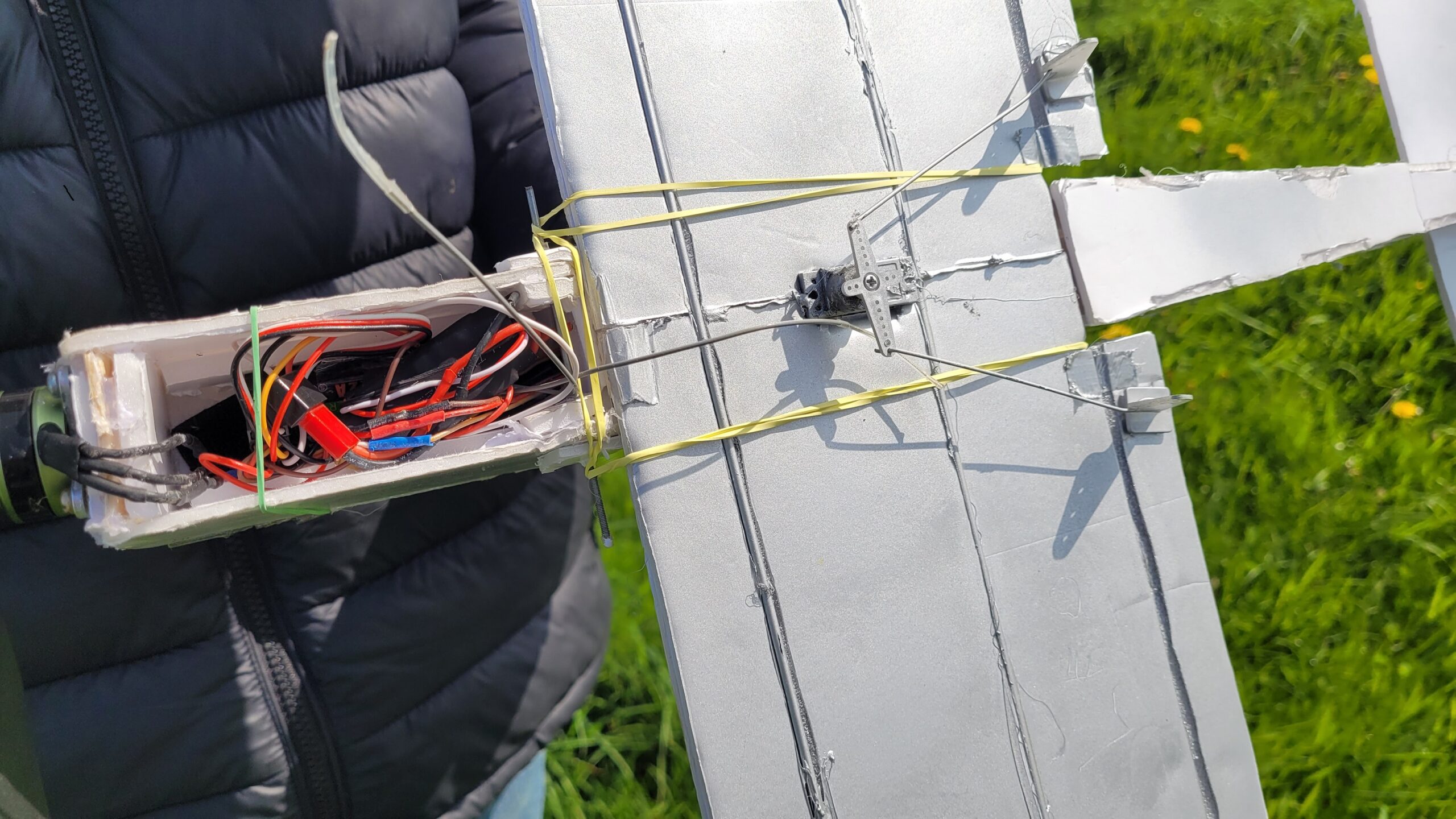 I have to say that despite looking rather rushed it seemed to fly very well so if anyone is looking for a cheap and quick to build small model a Phoebe might just be the one to pick.
I have to say that despite looking rather rushed it seemed to fly very well so if anyone is looking for a cheap and quick to build small model a Phoebe might just be the one to pick.
Quiz time now: Your planes probably use 3 or 4 cells, possibly 6 cells but it’s unlikely to be more, and they can fly at full throttle for around 5 minutes. So what electric plane uses 6480 cells and can fly for around 8 minutes at full throttle? The Spirit of Innovation!
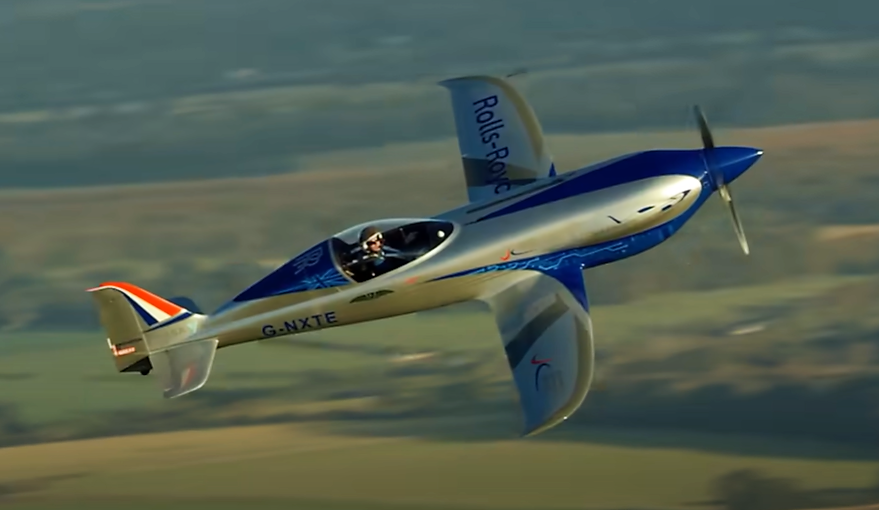 The cells are 18650 (18mm dia x 65mm long) and are made into 3 packs of 756V 24kWh.
The cells are 18650 (18mm dia x 65mm long) and are made into 3 packs of 756V 24kWh. 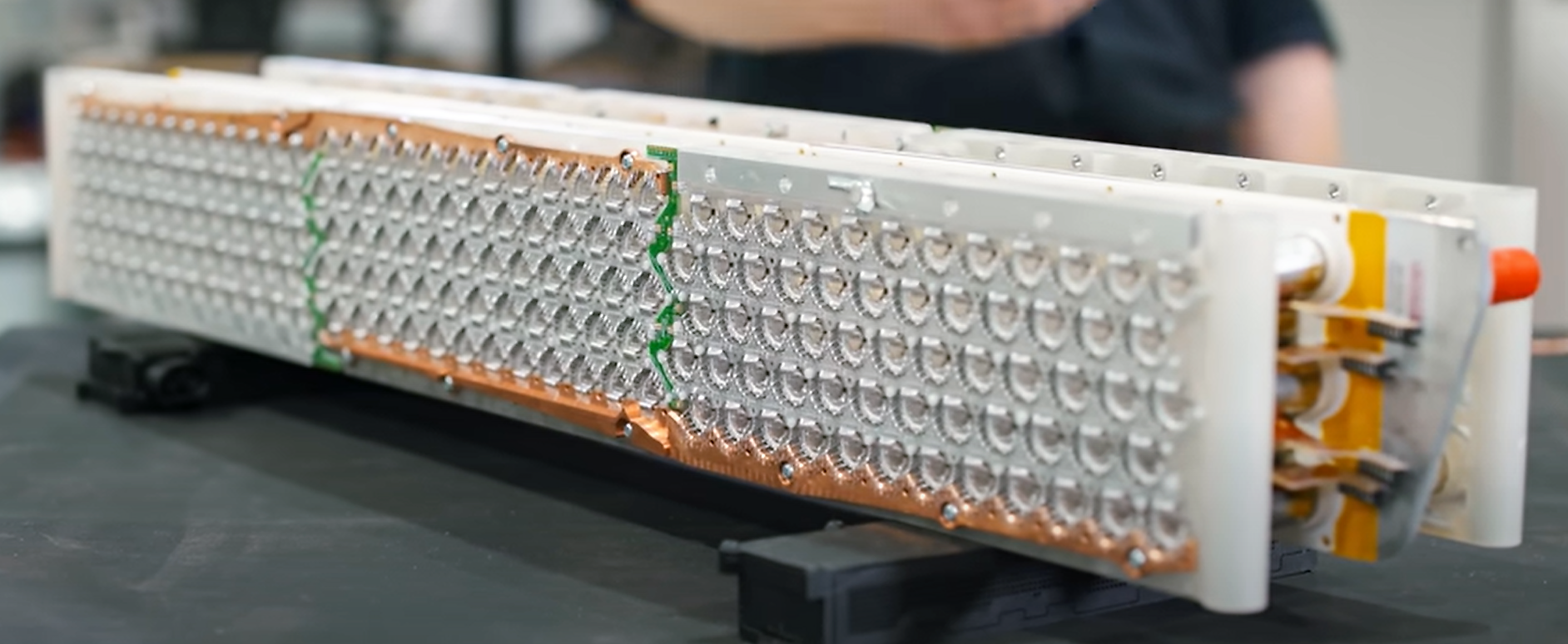 For comparison a 2200mAh 3 cell lipo is 0.02442kWh. The plane was designed and built to break the electric powered air speed record which it now holds at 345mph. Take a look at this fourteen minute video for more information about the plane and how it’s powered.
For comparison a 2200mAh 3 cell lipo is 0.02442kWh. The plane was designed and built to break the electric powered air speed record which it now holds at 345mph. Take a look at this fourteen minute video for more information about the plane and how it’s powered.
Chairman Gordon Bennett finished building and flew a Flair Cub in May so I asked him to write a report on how his first balsa build went, over to Gordon: I’ve always liked the Jet Provost. On my 40th birthday I was lucky enough to get a trip in one, but that story is for another time, perhaps over a pint, do we dare have another club meeting?!
 So, for my 60th birthday I asked my friends if they would buy various bits on the Tony Nijhuis 70mm EDF Provost as I was determined to build one. Unfortunately, I got three port wings a tailplane and no fuselage so it’s going to look a bit odd…only kidding.
So, for my 60th birthday I asked my friends if they would buy various bits on the Tony Nijhuis 70mm EDF Provost as I was determined to build one. Unfortunately, I got three port wings a tailplane and no fuselage so it’s going to look a bit odd…only kidding.
This being my first kit I decided to take advice from the worthy PAM ‘builders’ and Dwayne Pipe’s initial reaction was ‘take your time and perhaps start with something a little simpler to learn basic building skills’. I followed his advice to the letter and did absolutely nothing for the next six months.
By chance the club was then contacted by a gent from Liss who said he had a Flair Cub kit that he had given up with and was up for grabs. He had everything for the airframe and had started work on the fuselage but then, for whatever reason, decided not to progress further. On collecting it I was immediately surprised on how big the box was, it’s hardly a large-scale model but bigger than what I’d anticipated.
Thinking again about Dwayne’s advice I did nothing for another three months.
Finally, I got fed up moving the box around my garage and decided with spring now upon us I should get stuck in.
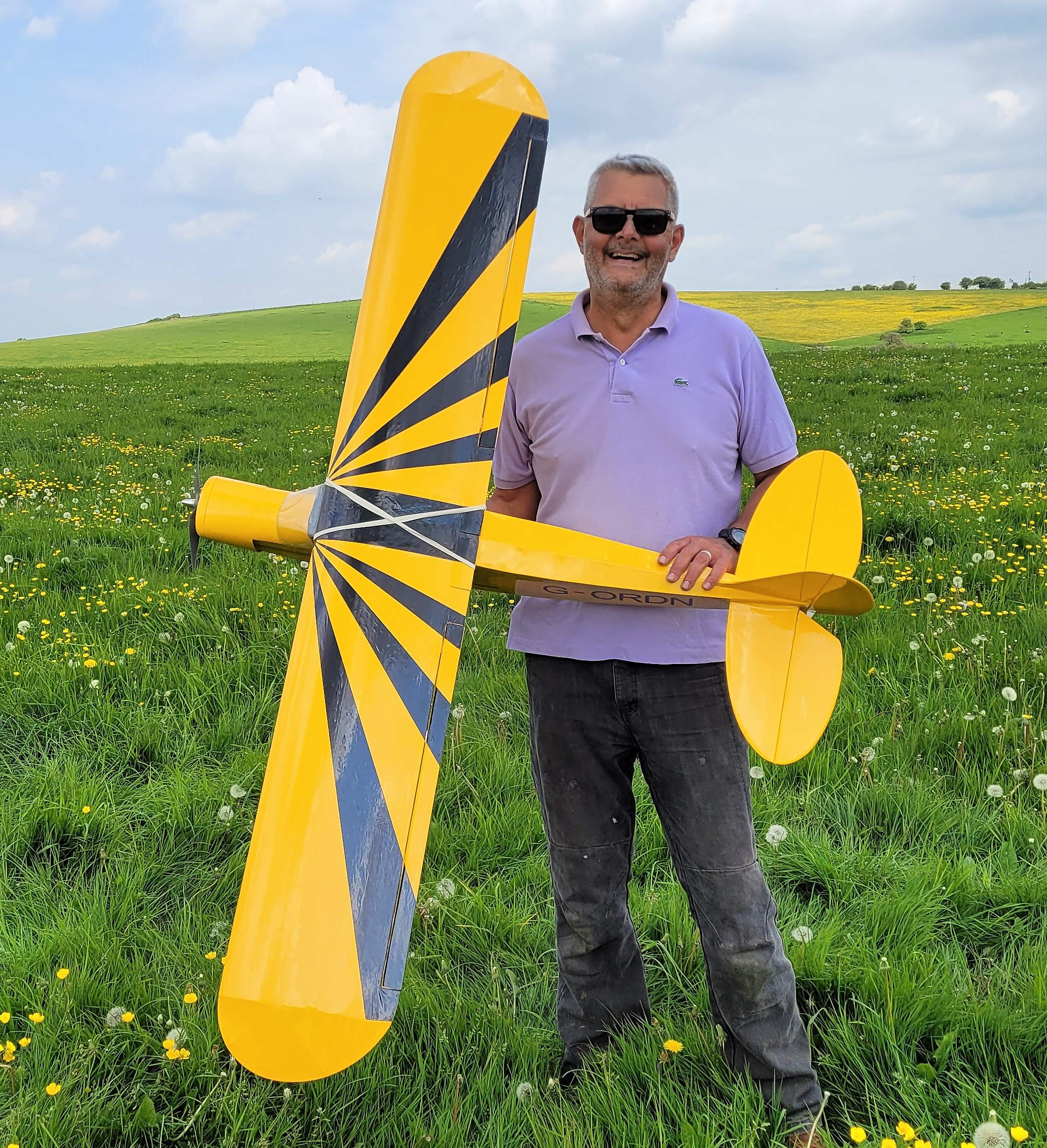 First up finish the fuselage. The kit is really old. I mean really old, perhaps around 10 BC, or more properly 10 BCC (before Colin Cowplain). See what I mean, really old.
First up finish the fuselage. The kit is really old. I mean really old, perhaps around 10 BC, or more properly 10 BCC (before Colin Cowplain). See what I mean, really old.
(Oi, I have a long memory you know, really long! – CC). All of the balsa had a strange powdery coating and the glue wouldn’t adhere so a clean-up of all parts was required.
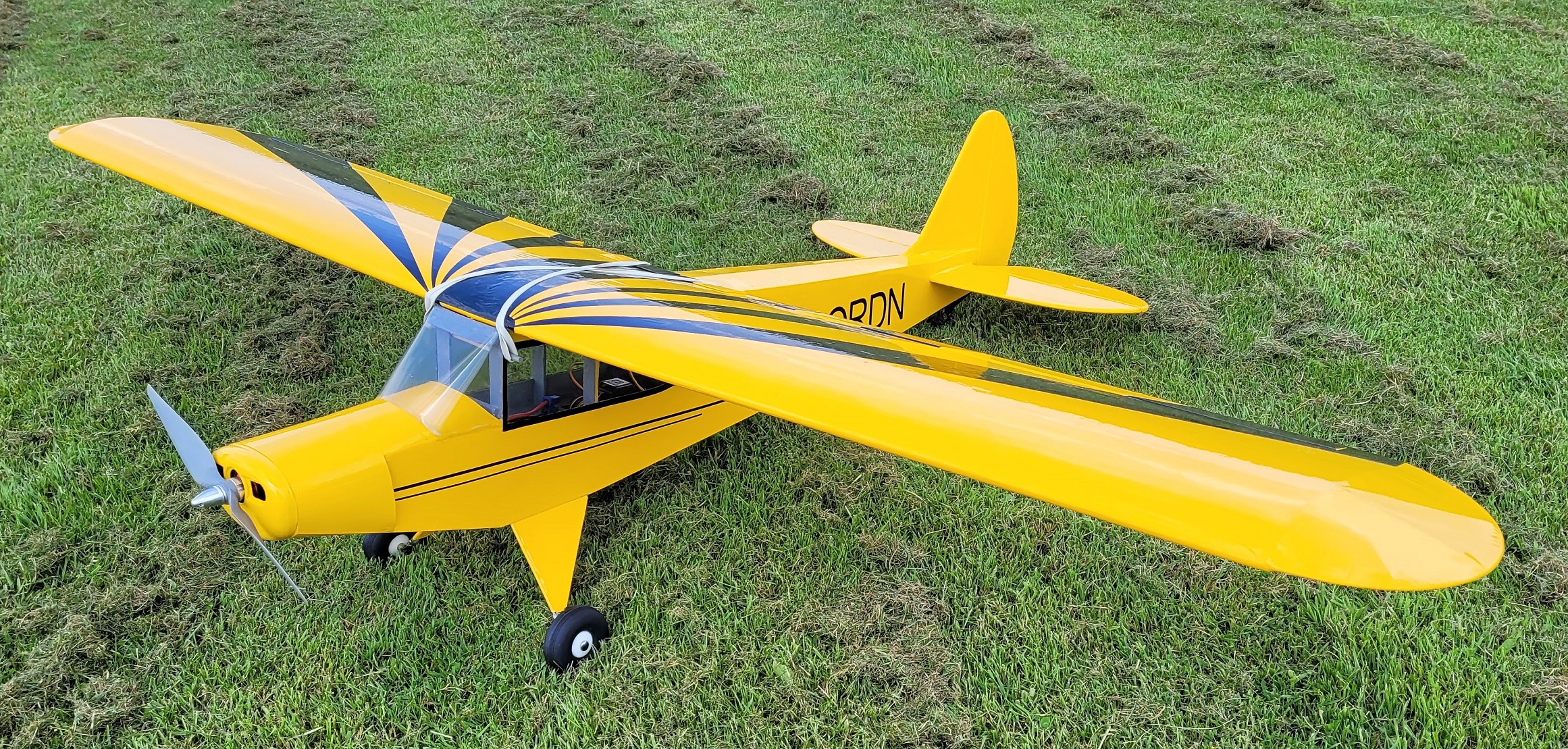 Next to the wings. Super simple as they’re a foam core with balsa skin, the tips are just made up from ribs. The wing jointing kit is glass cloth and epoxy but as it was so old the epoxy had gone off. Being an important structural part, I bought new epoxy and then realised the 6 foot wingspan meant I couldn’t fit the assembled wings on my workbench.
Next to the wings. Super simple as they’re a foam core with balsa skin, the tips are just made up from ribs. The wing jointing kit is glass cloth and epoxy but as it was so old the epoxy had gone off. Being an important structural part, I bought new epoxy and then realised the 6 foot wingspan meant I couldn’t fit the assembled wings on my workbench.
Tailplane, rudder and elevators are built up from solid balsa, so again, quick and simple.
The main problem was powertrain. Being an old design, before electricity was invented, the plans suggested a .30 Irvine. I went for a Ripmax Quantum II 36 brushless with a 60 amp ESC and 10×8 prop. The original engine bearers were lateral so I had to chop the front of the model off and install a new bulkhead to take the electric engine. The bulkhead is 3mm lite-ply and, at this, Dougal raised an eyebrow suggesting 6mm might be better. Having already installed it I slapped a bit more epoxy around to strengthen things.
Electronics are all Spektrum, only the best will do. (Now we know you’re joking! – CC)
 The original purchaser had also given me two rolls of Solartex (red and white) so I set about my first attempt at covering. First, the bottle of Balsa-Loc was solid so a new one was purchased, and then, still when nothing would stick, I realised the glue on the Solartex had gone off too!
The original purchaser had also given me two rolls of Solartex (red and white) so I set about my first attempt at covering. First, the bottle of Balsa-Loc was solid so a new one was purchased, and then, still when nothing would stick, I realised the glue on the Solartex had gone off too!
I bought a couple of rolls of Oracover film instead and decided to go ‘Cub Yellow’. The end result certainly isn’t perfect but it was my first attempt and was amazed what a great material it is to work with. Some limited detailing went on and I decided to fit the registration G-ORDN. (I can’t get that song “Gordon is a moron” out of my head! – CC)
 Cutting and fitting the windscreen from acetate sheet was a nightmare but I’m over it now. All the last touches and fiddly servo bits took a while but eventually she was ready.
Cutting and fitting the windscreen from acetate sheet was a nightmare but I’m over it now. All the last touches and fiddly servo bits took a while but eventually she was ready.
Except she wasn’t. Even with the battery virtually on top of the engine, the C of G was about an inch too rearward. I took the model up to the patch to seek the advice of Colin Cowplain. He wasn’t happy about the C of G situation so I strapped and old 3S 2200 Lipo underneath the engine cowling and this sorted things out.
 Cowplain took her up for the first flight and all seemed reasonable. Colin thinks she’s a bit overpowered and could do with a larger diameter prop. The engine could do with a bit of ‘up’ and ‘right’ thrust but this will be easy as I used stand-off bolts on the bulkhead. I also want to cut a hatch for the battery as at the moment you can only access it by taking the wings off.
Cowplain took her up for the first flight and all seemed reasonable. Colin thinks she’s a bit overpowered and could do with a larger diameter prop. The engine could do with a bit of ‘up’ and ‘right’ thrust but this will be easy as I used stand-off bolts on the bulkhead. I also want to cut a hatch for the battery as at the moment you can only access it by taking the wings off.
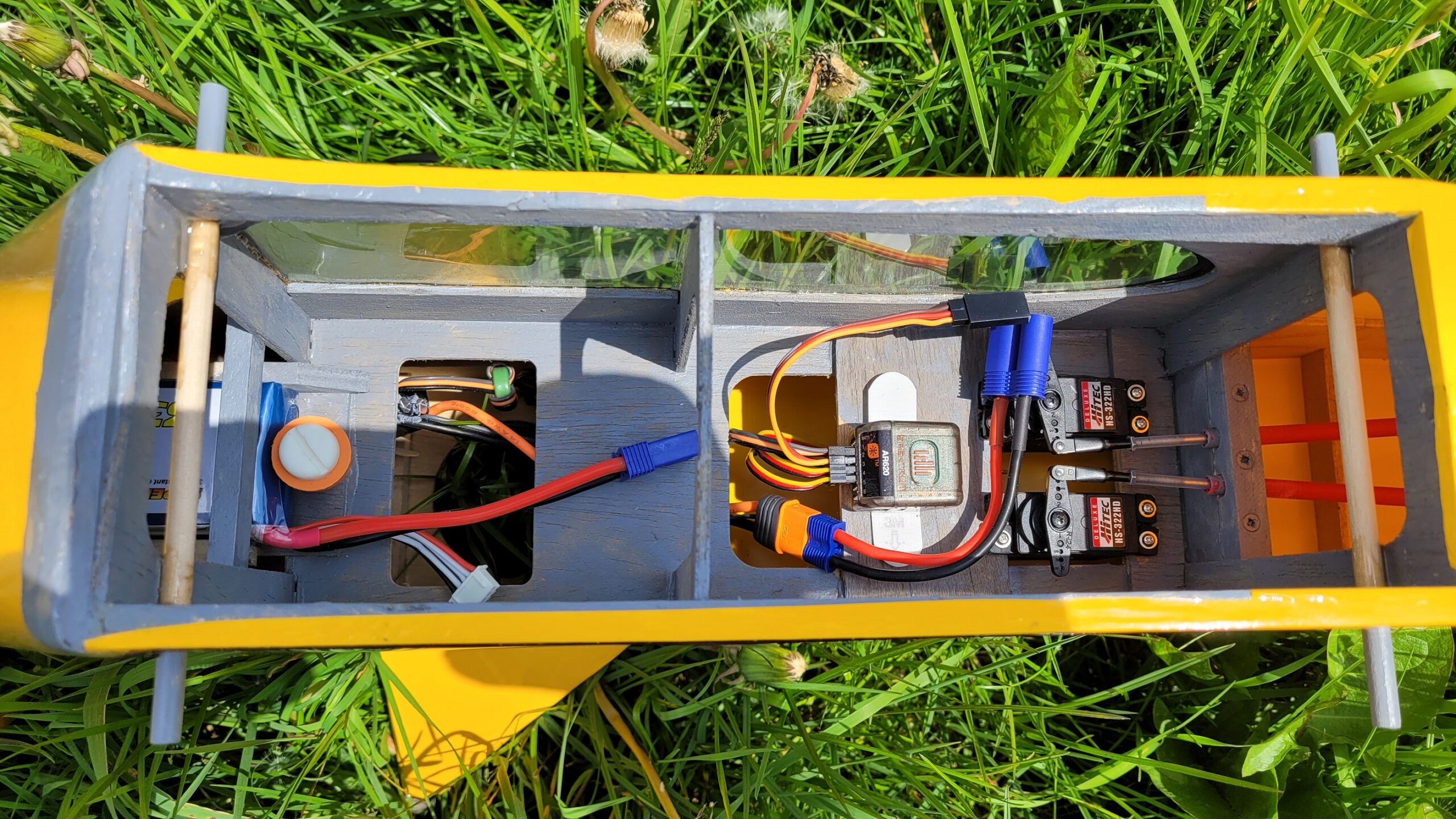 To sort the C of G I’ll need to put about 160 grams of lead in the nose (the whole model weighs about 2.5 Kg). Mini Mike suggested using ‘car wheel balancing’ lead and said he could get me a couple. Failing that there’s always the church roof.
To sort the C of G I’ll need to put about 160 grams of lead in the nose (the whole model weighs about 2.5 Kg). Mini Mike suggested using ‘car wheel balancing’ lead and said he could get me a couple. Failing that there’s always the church roof.
The test flight should feature on Patch News this month. You’ll see Cowplain had handed the controls back to me and I decided to test the ‘Bush’ credentials of the Cub by landing so late on the patch that I was into the long grass. (It’s OK Gordon, I’ve cut that bit and used your second landing to spare your blushes – CC). Things did improve from there!
That’s my first ‘build’ completed, and I have to say I feel a small sense of achievement. It’s quite terrifying that all the hard work could be undone by a crash but I guess it’s all part of the fun. Now to crack on with the Provost, should be ready by the end of the decade.
With the return of Kryten to the field this month comes some of his superb action photos:
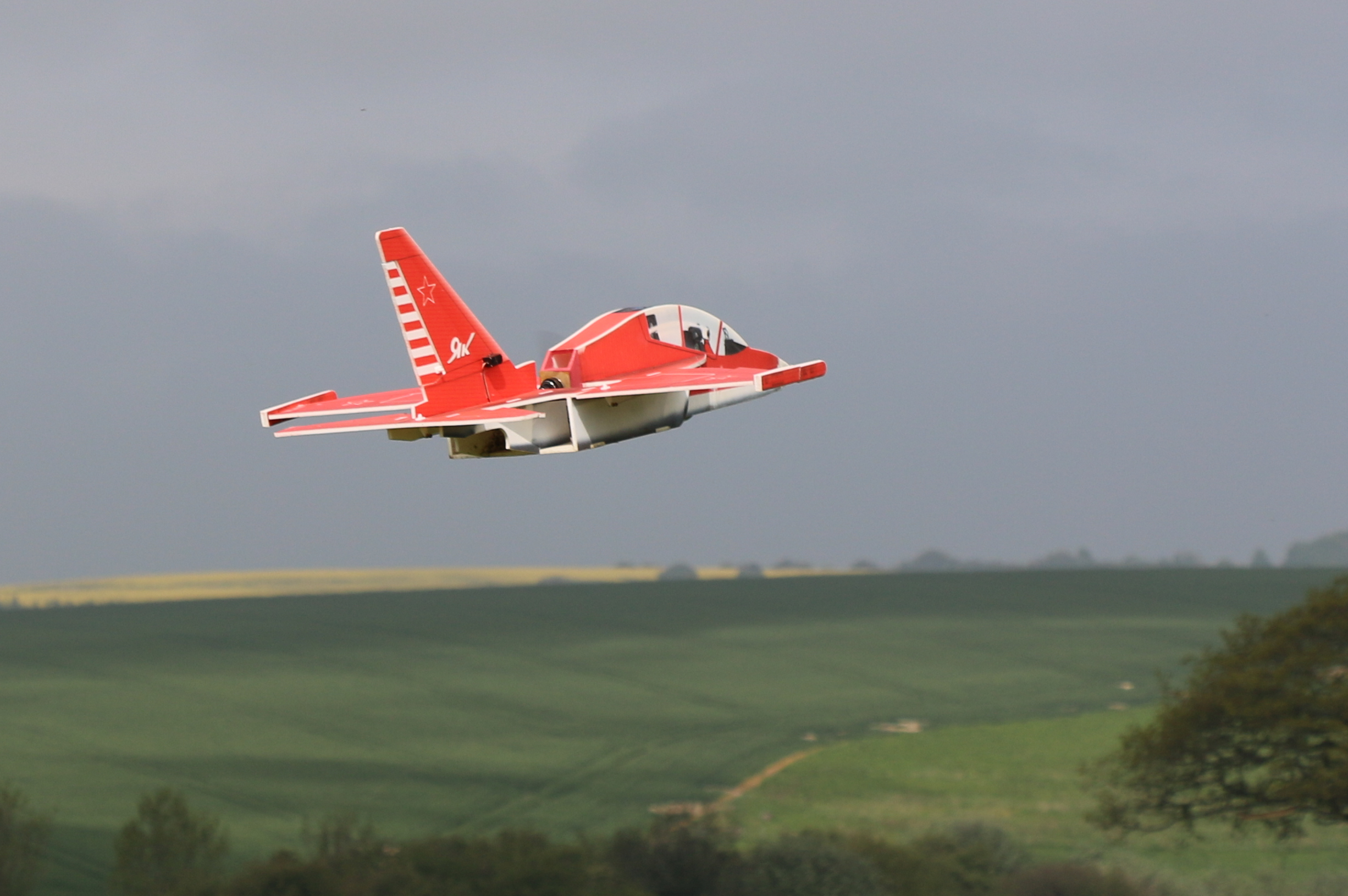
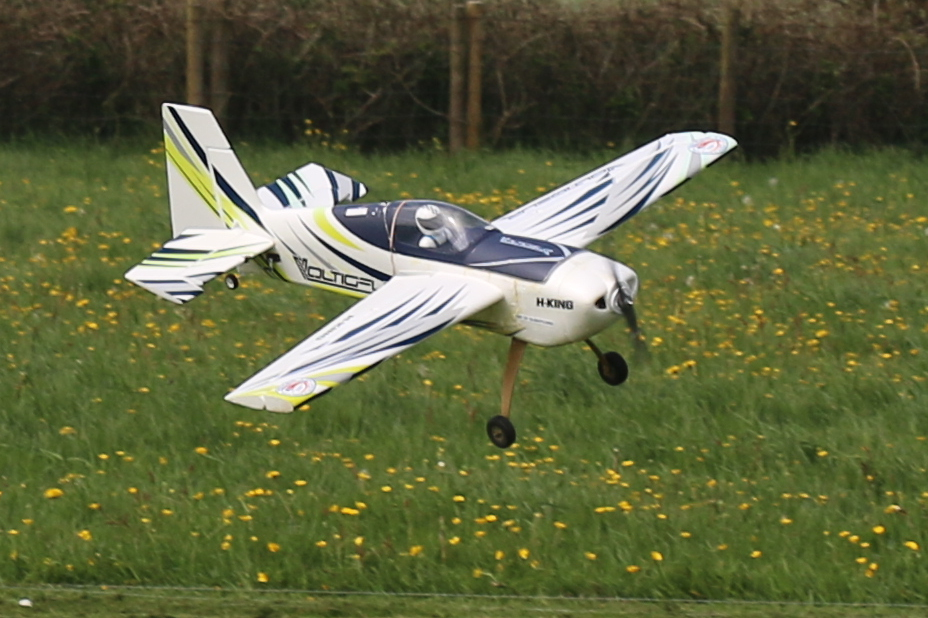
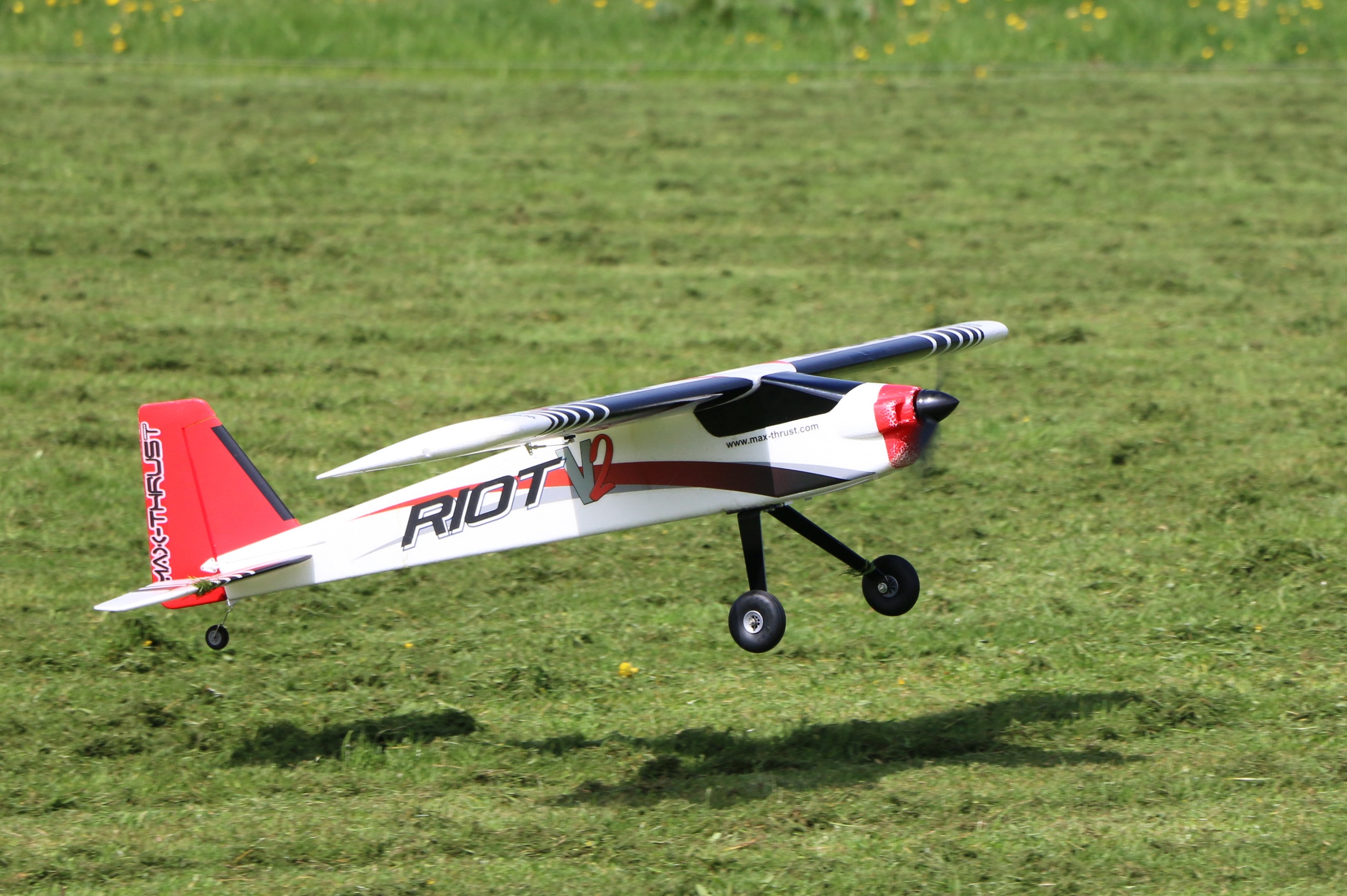

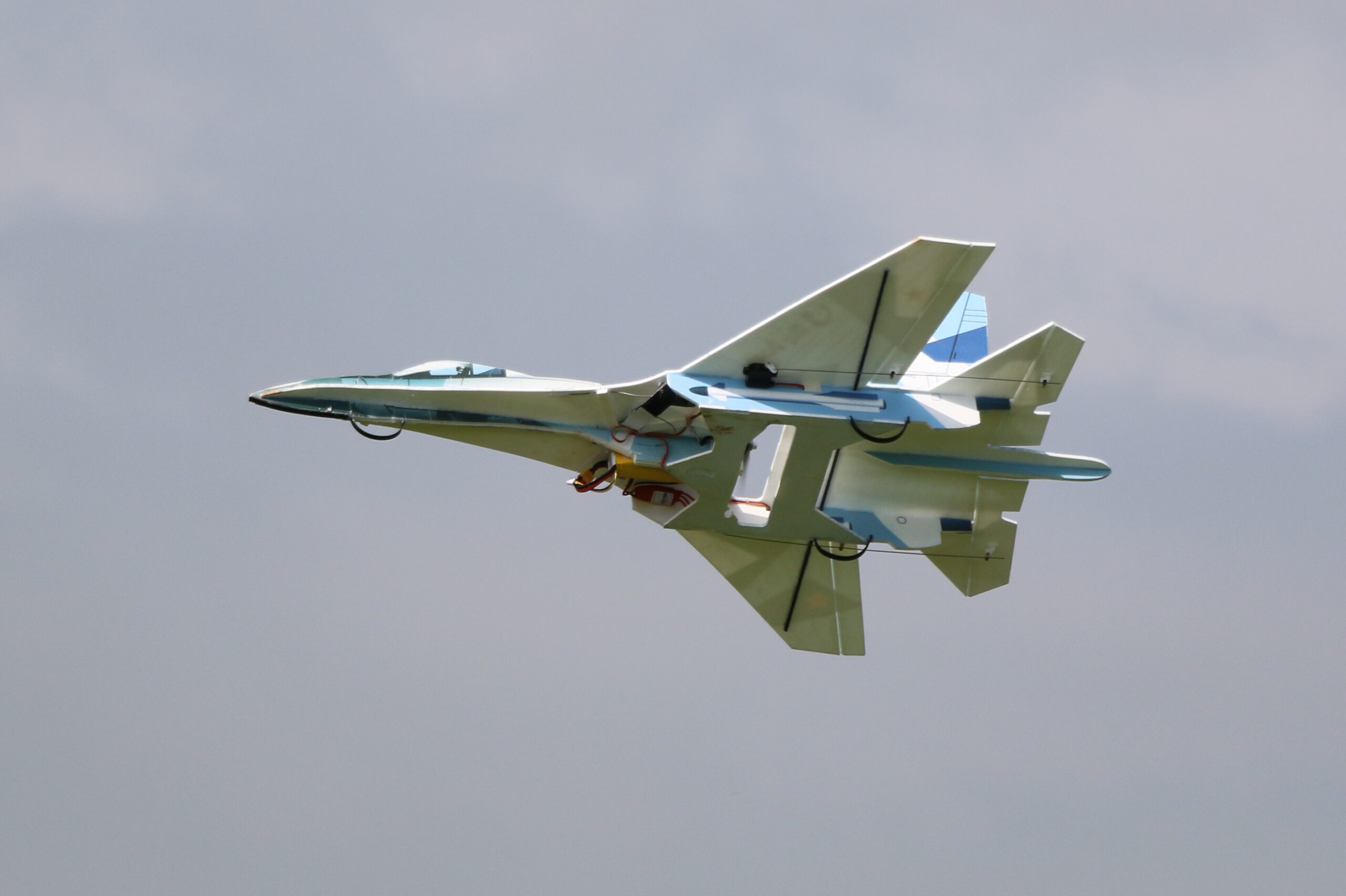 Video time now with footage by me, Dougal Entendre, Kryten, Nadine, and Peter F.
Video time now with footage by me, Dougal Entendre, Kryten, Nadine, and Peter F.
Please watch the video full-screen, it’s so much better with small models flying around.
If the video won’t play for you please click HERE
An airline stewardess was out golfing one day when she sliced her ball into the woods.
When she went into the woods to look for the ball she found a frog caught in a trap.
The frog said to her “If you release me from this trap, I will grant you three wishes”.
So she freed the frog who said, “Thanks, but I failed to mention that there was a condition, whatever you wish for your Captain will get ten times more or better!”
The stewardess said, “That’s ok, I can live with that” and she made her first wish which was that she wanted to be the most beautiful stewardess in the world.
The frog warned her, “You do realize that this wish will also make your Captain the most handsome pilot in the world, an Adonis that all the other stewardesses will flock to.”
She replied, “That’s ok, I will be the most beautiful one and he will only have eyes for me.”
So, KAZAM – she became the most beautiful stewardess in the world!
For her second wish she wanted to be the richest stewardess in the world.
The frog said, “That will make your Captain the richest pilot in the world and he will be ten times richer than you.” The stewardess said, “That’s ok because I’m such a devoted stewardess that what’s mine is also my Captain’s and what is my Captain’s is also mine.” So, KAZAM she’s the richest stewardess in the world!
The frog then inquired about her third wish. She thought about it for a minute, then said “I’d like to have a mild heart attack…”
Moral: Stewardesses are smart, don’t mess with them!
Colin Cowplain
Patch News – March 2023
March was an interesting month for PAM members, unfortunately mostly for the wrong reasons! Having decided at the December AGM to start holding quarterly meetings after three years with none we held a social meeting on 1st March at the Seven Stars in Stroud.
It went very well with about a dozen members attending for a general catch up and natter and it was good to see some faces that we’d hardly seen since the start of the pandemic. We’d waited much longer than the regulations required to hold a meeting because we didn’t want to risk anyone catching Covid but guess what happened…in the following few days almost half of the attendees went down with it! They then spread it on to their wives/girlfriends/boyfriends etc. but fortunately, as far as I know, nobody was seriously ill and all have now recovered. But looking on the bright side, it could have been very much worse, I could have got it! I’m not sure quite how I avoided it as the people on both sides of me went down with it but not me. Not that I’m complaining… Colin Complain? Never!
The sheep that had arrived in February were gone by the middle of March but with several members struck down with Covid the first half of the month was rather quiet although a few of the Covid free ones did manage to fly on a few occasions. Towards the end of the month everybody was back to good health and raring to go but the weather was rubbish on several of our usual flying days so overall was there was rather less flying than usual.
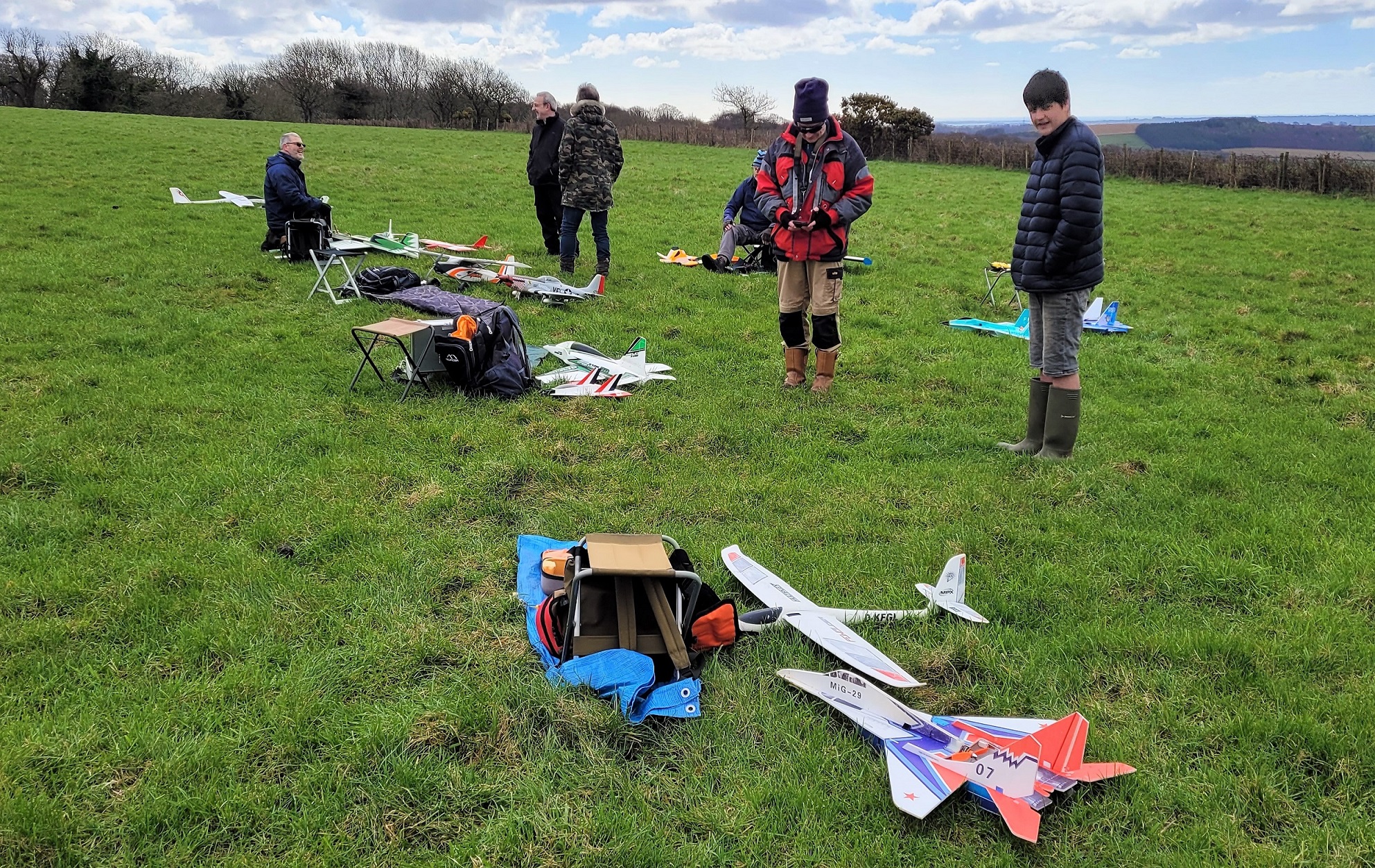 Some of the FARTS mowed the patch one Friday afternoon and Chairman Gordon Bennett kindly took the mower back over to the box when we’d finished. It wasn’t until we returned to fly the following Sunday morning that we realised he’d taken the mower back to the box but hadn’t actually put it away and it was sat next to the open box looking rather lonely.
Some of the FARTS mowed the patch one Friday afternoon and Chairman Gordon Bennett kindly took the mower back over to the box when we’d finished. It wasn’t until we returned to fly the following Sunday morning that we realised he’d taken the mower back to the box but hadn’t actually put it away and it was sat next to the open box looking rather lonely.  Fortunately the members of the public who had walked along the track in the meantime must have been either very honest or completely blind and all was well!
Fortunately the members of the public who had walked along the track in the meantime must have been either very honest or completely blind and all was well!
Gordon redeemed himself by going off to the States for a ‘business trip’ and managed to include a visit to the Florida Jets, a four day event which is billed as the world’s largest RC jet event with no less than six flight lines running each day. Following that he dragged himself over to Arizona where he inadvertently stumbled across the Arizona Warbirds & Classics fly-in, another four day event which is hosted by the Sun Valley Fliers. That’s the sort of ‘business trip’ we would all happily undertake and I’ve already volunteered to carry his bags if he goes again next year! Gordon took lots of photos and has written this for us:
Back in the depths of winter I was flicking through my copy of Model Aeroplane News (MAN) when I spotted an advert for ‘Florida Jets’. I like MAN as the articles are very ‘American’ compared to RCME and I enjoy the different perspective. The ad conjured up images of sunshine, palm trees and…. jets! Not only that, Arizona Warbirds and Classics was later in the same week. It had to be done.
Due to other commitments, I could only attend Florida Jets on the Wednesday, the show’s first day. I got to Lakeland a day early and got down to the Museum of Aviation (the base for Sun & Fun). It’s a great mid-size exhibition and had a couple of unusual outdoor exhibits in particular a FY2 Sea Dart and an XFV-1 Salmon.

 The Sea Dart was the only supersonic seaplane and XFV-1 is clearly something Dougal or 1066 should build a model of and get hanging.
The Sea Dart was the only supersonic seaplane and XFV-1 is clearly something Dougal or 1066 should build a model of and get hanging.
The next day I was up bright and early and found myself as virtually the only spectator on a windswept, cold, rainy day at Paradise Field. Between the rain showers I trudged past the models hiding in their tents and met a load of super friendly RC aviation nuts displaying their planes.
I’ve put together a short video so won’t go into too much detail here but watch out for the Raptor, a model with amazing scale detail (cockpit with active displays etc).
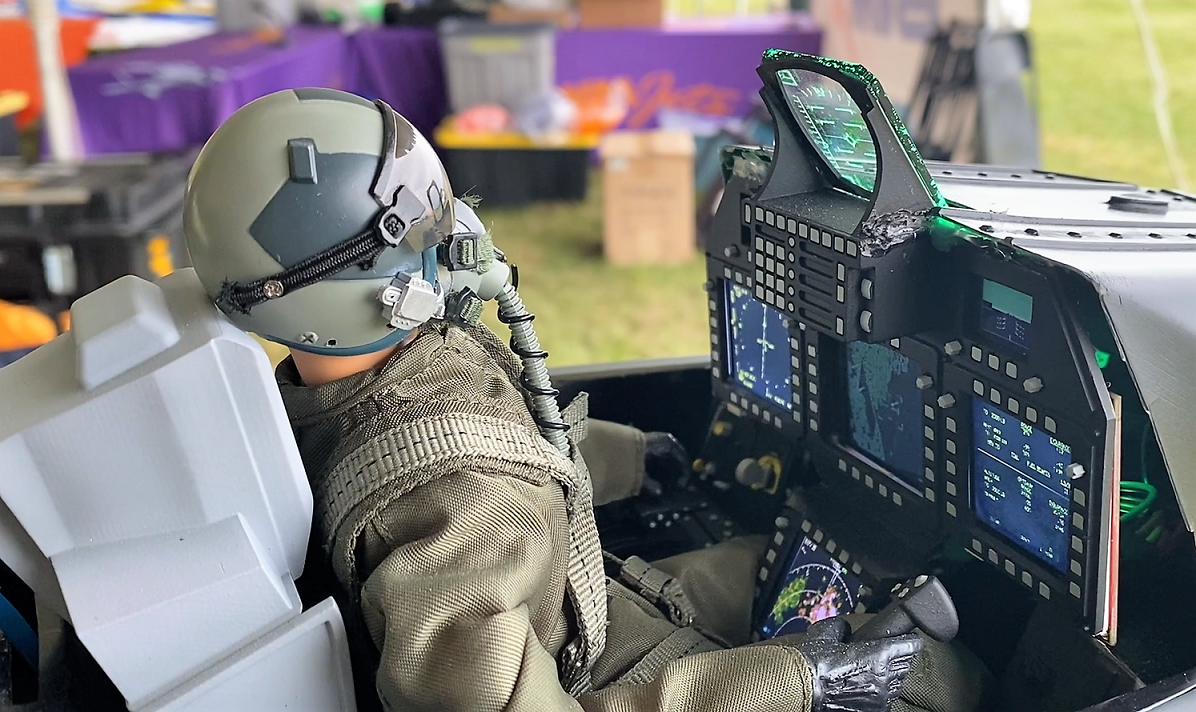 In the tent next door I heard English accents and met Ali Machinchy and his son. Being a relative newcomer to the sport I didn’t have a clue who he was but he was super kind and put up with my stupid questions. I was chuffed to bits that he was a big Spektrum fan (!) and only realised the full picture when I later googled him.
In the tent next door I heard English accents and met Ali Machinchy and his son. Being a relative newcomer to the sport I didn’t have a clue who he was but he was super kind and put up with my stupid questions. I was chuffed to bits that he was a big Spektrum fan (!) and only realised the full picture when I later googled him.
The sun broke through mid-morning and we were off. In fact, it was Al’s 18-year-old son who was the first airborne, totally unphased by a pretty stiff crosswind. It was an open event so a few professional displays and then everyone else just flying when they wanted, which turned out to be all the time. The standard of flying was spectacular as you’ll see.
 On Friday I made it to Phoenix, Arizona and from there a 30-minute drive to Sun Valley Flyers out in the desert. Now don’t get me wrong, I love our 30m patch and its beautiful views down to the IOW. But it’s hard not to be impressed by the sheer scale and quality of the facility they’ve built. The advantage of space means a peppercorn rent from the City Council, also the club has had a super strong 250-person membership for decades. Hence spending $80,000 to tarmac the runway was only part of the ongoing improvements.
On Friday I made it to Phoenix, Arizona and from there a 30-minute drive to Sun Valley Flyers out in the desert. Now don’t get me wrong, I love our 30m patch and its beautiful views down to the IOW. But it’s hard not to be impressed by the sheer scale and quality of the facility they’ve built. The advantage of space means a peppercorn rent from the City Council, also the club has had a super strong 250-person membership for decades. Hence spending $80,000 to tarmac the runway was only part of the ongoing improvements.
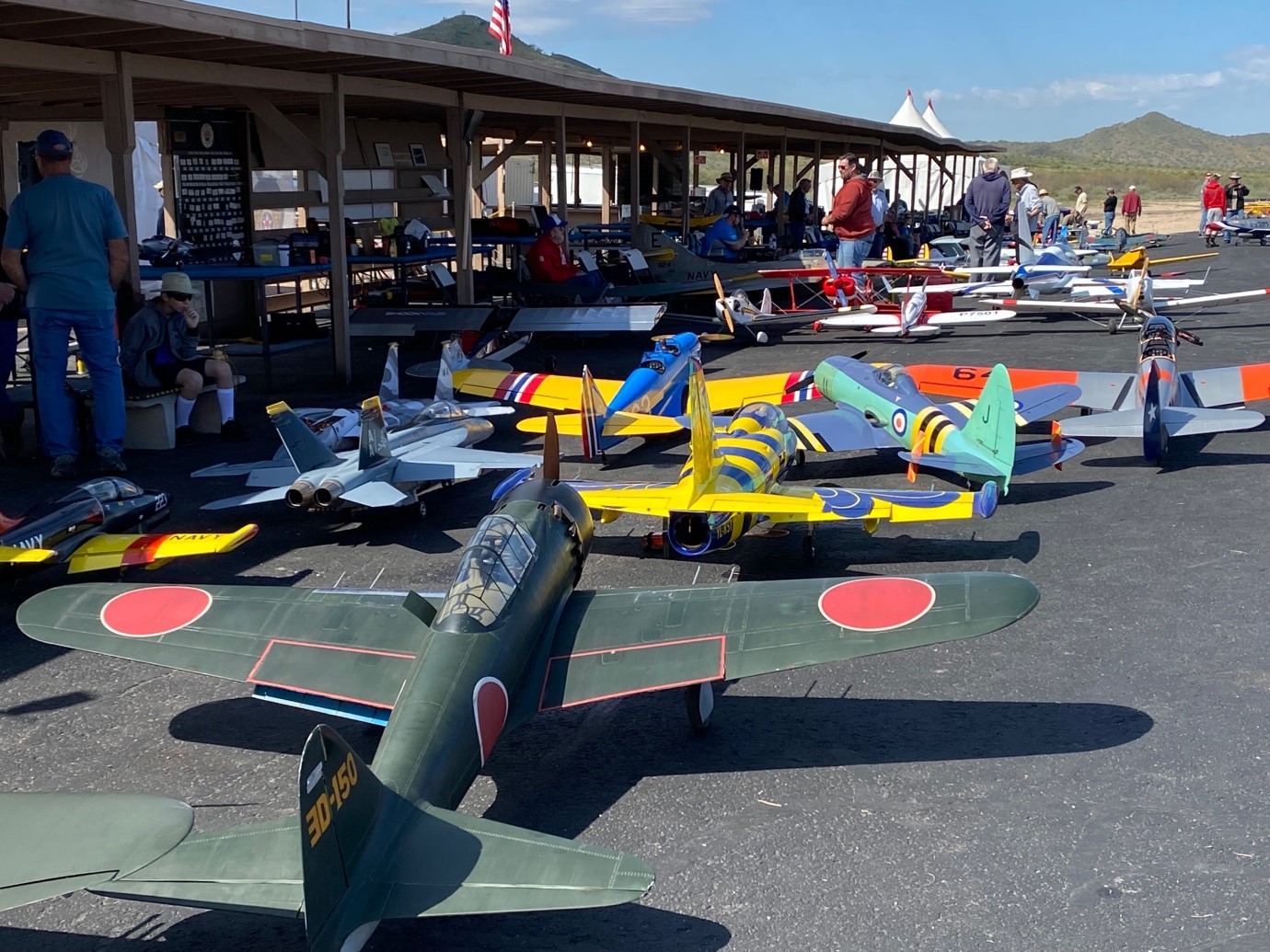 Arizona Warbirds and Classics was also an open event. There were a few organised spots like ‘let’s get as many WW1 aircraft as possible into the air at noon’ and a few stops for particular displays like the Sukhoi but other than that, endless fantastic aircraft being brilliantly flown.
Arizona Warbirds and Classics was also an open event. There were a few organised spots like ‘let’s get as many WW1 aircraft as possible into the air at noon’ and a few stops for particular displays like the Sukhoi but other than that, endless fantastic aircraft being brilliantly flown.
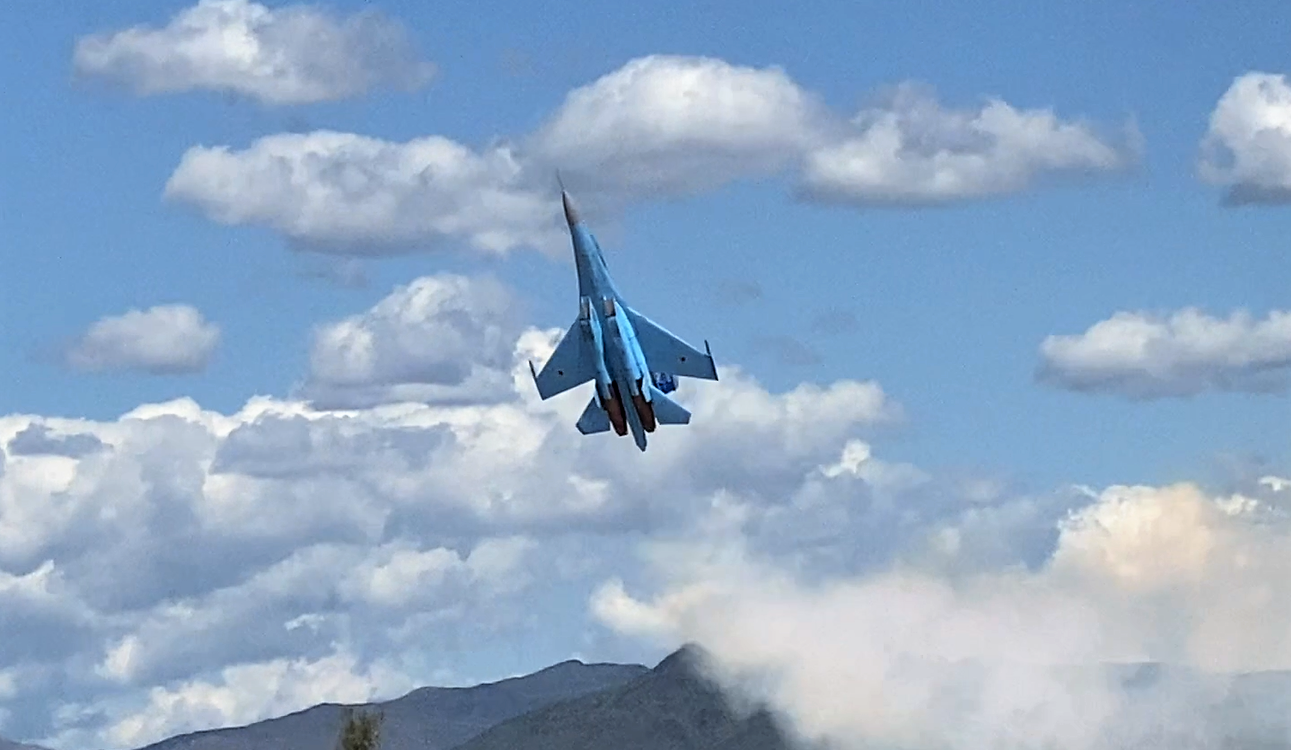 I used to be ambivalent about whether a model should have a pilot in the cockpit. Having seen the amazing scale models and flying techniques it was easy to think you were seeing full size. If a model didn’t have a pilot in situ, it suddenly didn’t feel right.
I used to be ambivalent about whether a model should have a pilot in the cockpit. Having seen the amazing scale models and flying techniques it was easy to think you were seeing full size. If a model didn’t have a pilot in situ, it suddenly didn’t feel right.
There were so many highlights, a scratch-built Dornier 335, an A10, a 12 year old superbly flying an L39 Albatross and the WW1 gaggle. But for me, the Sukhoi with its vectored thrust and the pair of massive Sabres in ‘Skyblazers’ livery were outstanding.
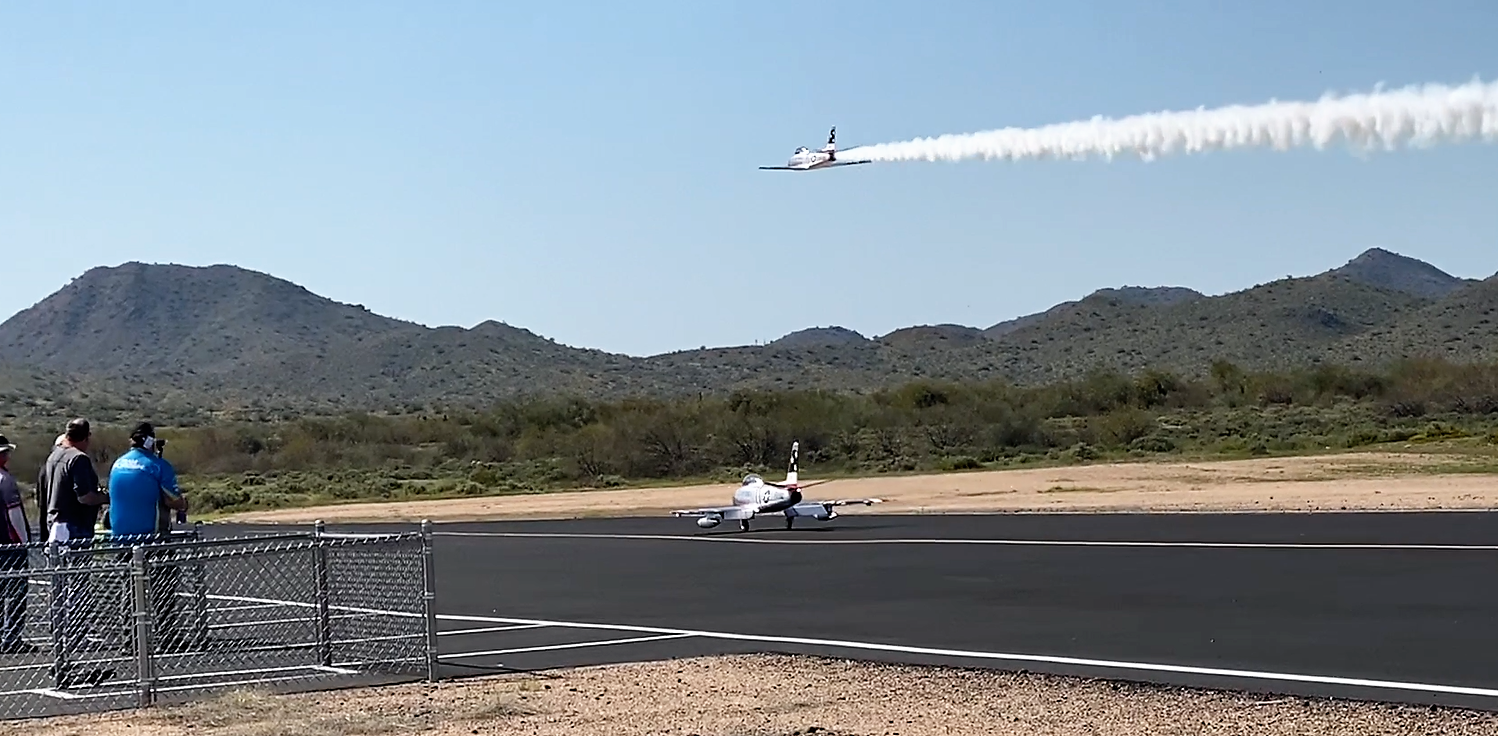 Thanks for that Gordon, we’re not at all jealous! With his very best Film Director’s hat on Gordon shot plenty of video and has produced a five minute extravaganza for us to enjoy:
Thanks for that Gordon, we’re not at all jealous! With his very best Film Director’s hat on Gordon shot plenty of video and has produced a five minute extravaganza for us to enjoy:
While Gordon was sunning himself in the States, back in the cold and damp of Hampshire Dwayne Pipe brought along a new own design F-22 Raptor to fly. Dwayne used the same basic principles of the foamboard jets that he’s designed and flown such as his Sea Vixen but this time he’s ditched the Hobbycraft foamboard and built it from a sheet of Correx.
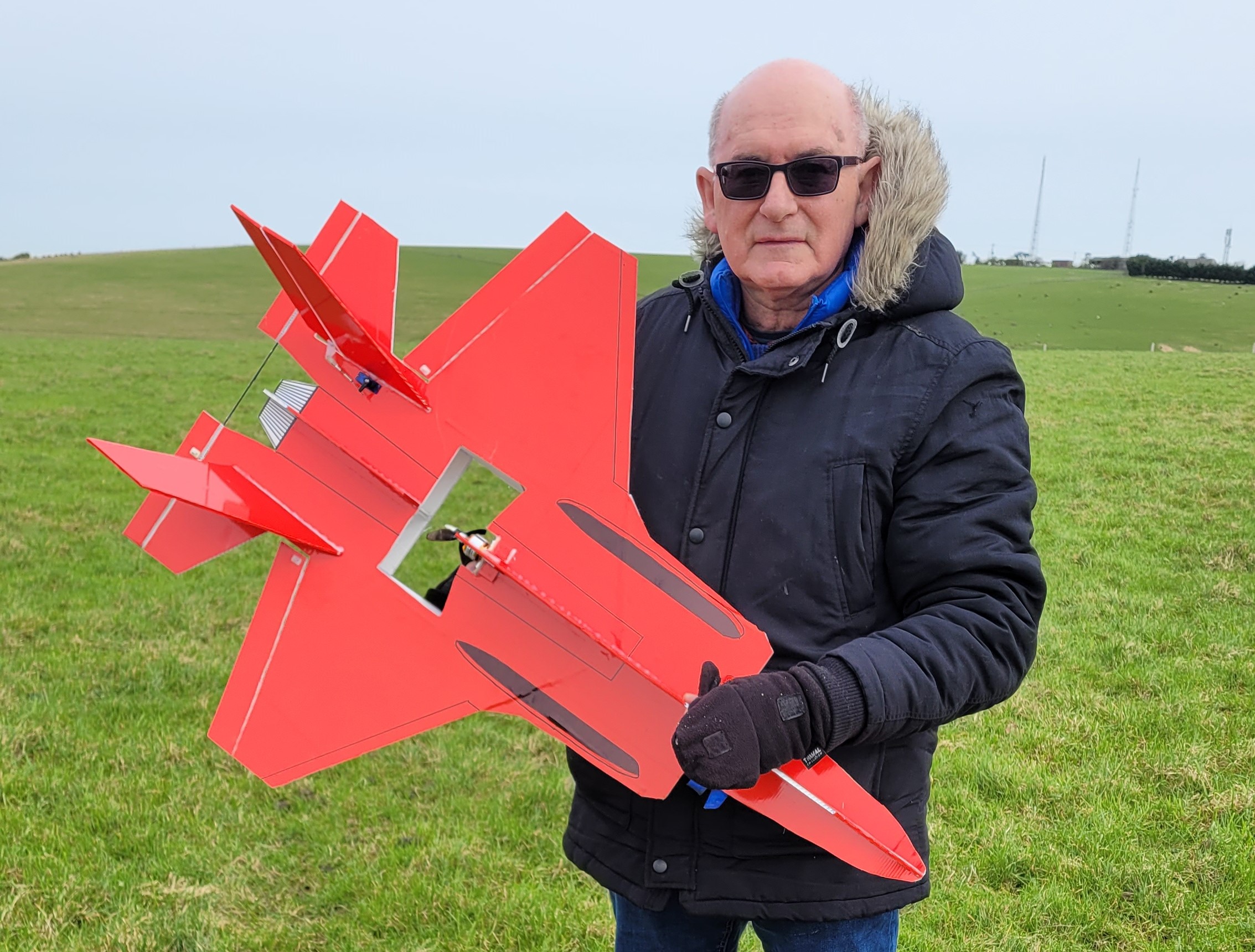 For those who don’t know Correx is the twin wall plastic board that many estate agents use for their signs and more importantly it’s the stuff lots of us used to make our planes for the Delta Challenge way back in 2015. Just look at all the young blokes in the photos below!
For those who don’t know Correx is the twin wall plastic board that many estate agents use for their signs and more importantly it’s the stuff lots of us used to make our planes for the Delta Challenge way back in 2015. Just look at all the young blokes in the photos below!


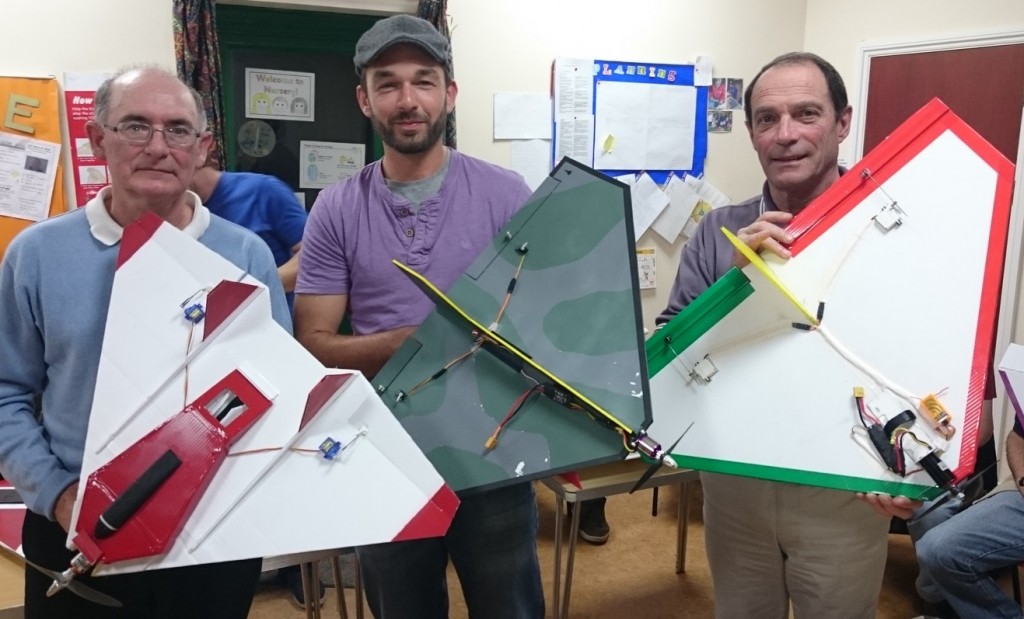
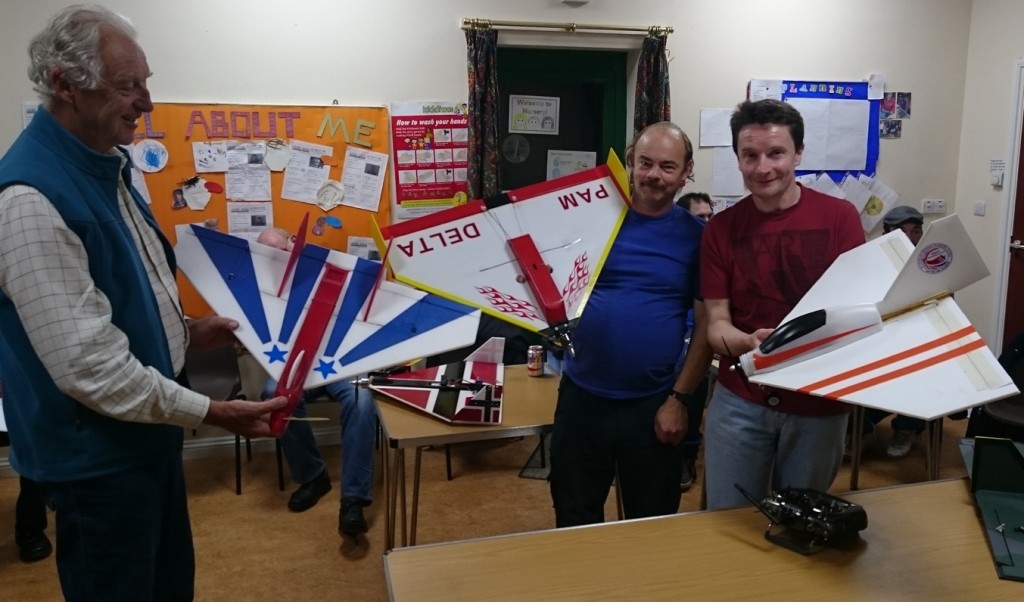 Anyway, back to Dwayne’s Raptor and you can see the Correx section pretty well in some of the photos, he chose the material because it’s extremely strong and easy to work with.
Anyway, back to Dwayne’s Raptor and you can see the Correx section pretty well in some of the photos, he chose the material because it’s extremely strong and easy to work with.  Although it is heavier than foamboard it’s completely waterproof, no problems with peeling paper on damp grass. Dwayne used hot melt glue for the construction, which works well on Correx, and he fitted a Turnigy Aerodrive D2826/6 2200kv motor, a 30A speed controller, and four 9g servos to move the waggly bits. There’s no mixing required on this one, it’s just straightforward ailerons, elevator and rudder controls. When I first saw the Raptor I thought Dwayne had painted it but it’s actually covered in Fablon.
Although it is heavier than foamboard it’s completely waterproof, no problems with peeling paper on damp grass. Dwayne used hot melt glue for the construction, which works well on Correx, and he fitted a Turnigy Aerodrive D2826/6 2200kv motor, a 30A speed controller, and four 9g servos to move the waggly bits. There’s no mixing required on this one, it’s just straightforward ailerons, elevator and rudder controls. When I first saw the Raptor I thought Dwayne had painted it but it’s actually covered in Fablon. 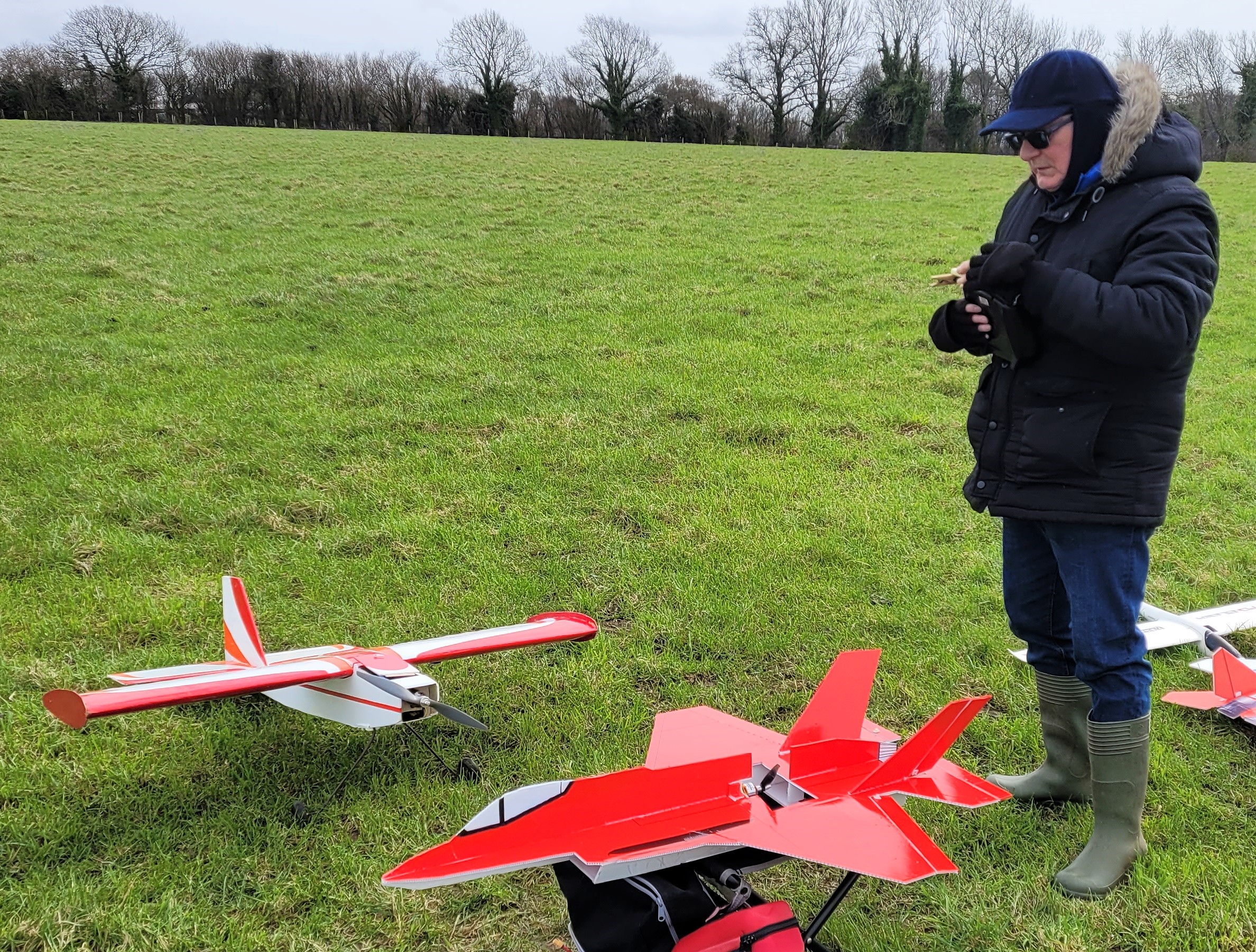 Remember Fablon? It’s a thin sticky back vinyl that first came out in the sixties and I haven’t seen it for years but a quick Google showed that it’s still alive and kicking and is available in a huge range of colours and finishes. It can be found on eBay and Amazon as well as from B&Q and Homebase etc. It’s certainly heavier than iron on films and I don’t think it will shrink with heat but it’s probably good for solid surfaces that don’t have any compound curves. It will be interesting to see how durable it turns out to be. So how did it fly? Erm…well…so far not very well! Dwayne had used an online calculator to determine the centre of gravity, something that he’d used before and found it worked well. But the first two or three attempts at flight showed that the centre of gravity was much too far back so Dwayne fitted a larger battery as far forward as possible for the next attempt. This time it was much better and managed a couple of rather hairy circuits before…err…’landing’.
Remember Fablon? It’s a thin sticky back vinyl that first came out in the sixties and I haven’t seen it for years but a quick Google showed that it’s still alive and kicking and is available in a huge range of colours and finishes. It can be found on eBay and Amazon as well as from B&Q and Homebase etc. It’s certainly heavier than iron on films and I don’t think it will shrink with heat but it’s probably good for solid surfaces that don’t have any compound curves. It will be interesting to see how durable it turns out to be. So how did it fly? Erm…well…so far not very well! Dwayne had used an online calculator to determine the centre of gravity, something that he’d used before and found it worked well. But the first two or three attempts at flight showed that the centre of gravity was much too far back so Dwayne fitted a larger battery as far forward as possible for the next attempt. This time it was much better and managed a couple of rather hairy circuits before…err…’landing’.
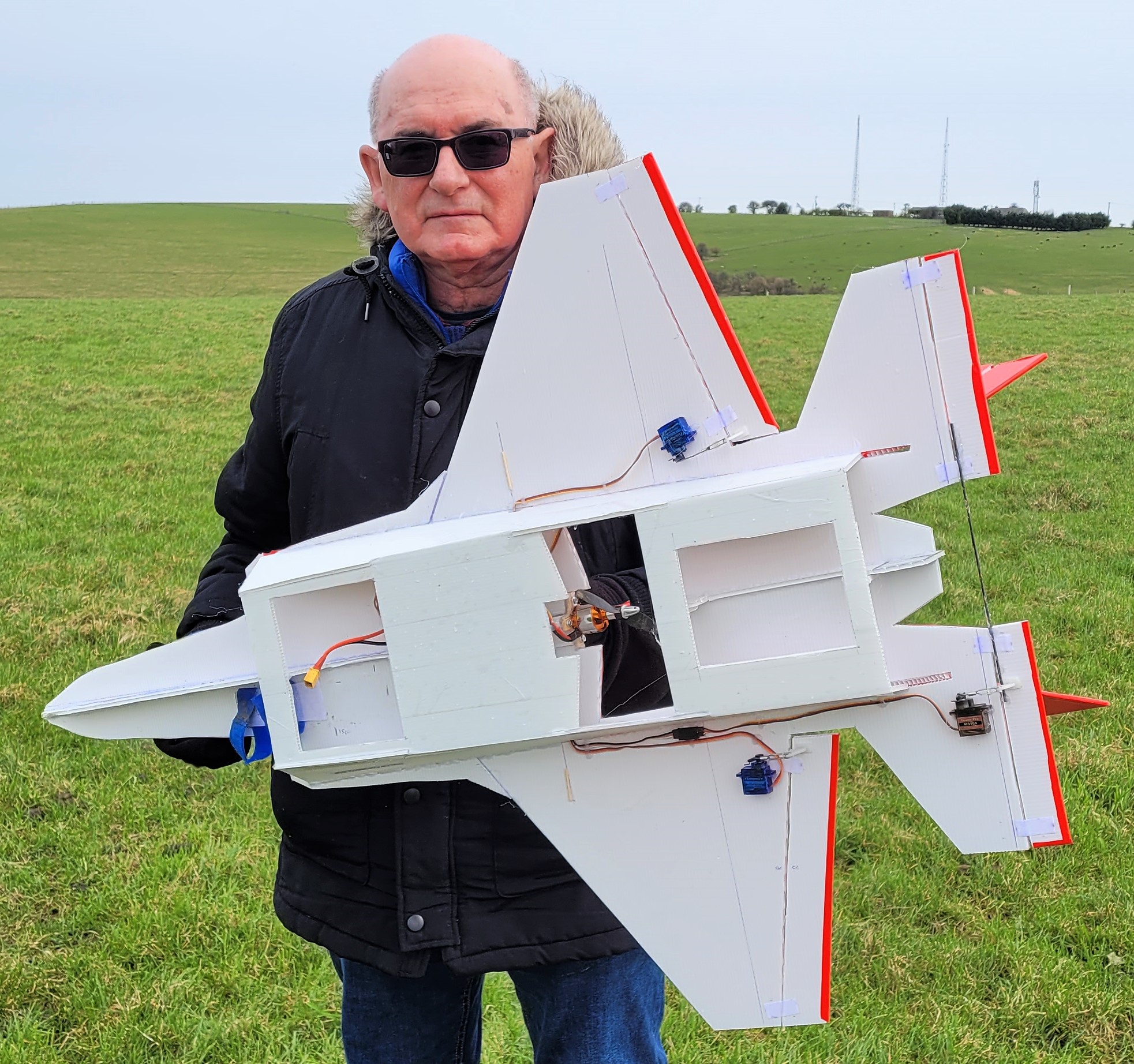 The flight showed what needs to be done and Dwayne headed off back to the workshop to make a few changes to the plane and the control movements but it will be back shortly and I think it will be fine after a few modifications. Sadly only Dwayne and I were at the field that day and I was chief launcher so I wasn’t able to capture any video for you to enjoy.
The flight showed what needs to be done and Dwayne headed off back to the workshop to make a few changes to the plane and the control movements but it will be back shortly and I think it will be fine after a few modifications. Sadly only Dwayne and I were at the field that day and I was chief launcher so I wasn’t able to capture any video for you to enjoy.
The next new model to appear in March was also an F-22 Raptor but this one is a foamboard version built by Woody. He was really happy with how his Su-27 from Ali Express flies and while browsing the site up popped the Raptor complete with the motor, three propellers, 30A esc, and two servos for just £23.48 with free postage!
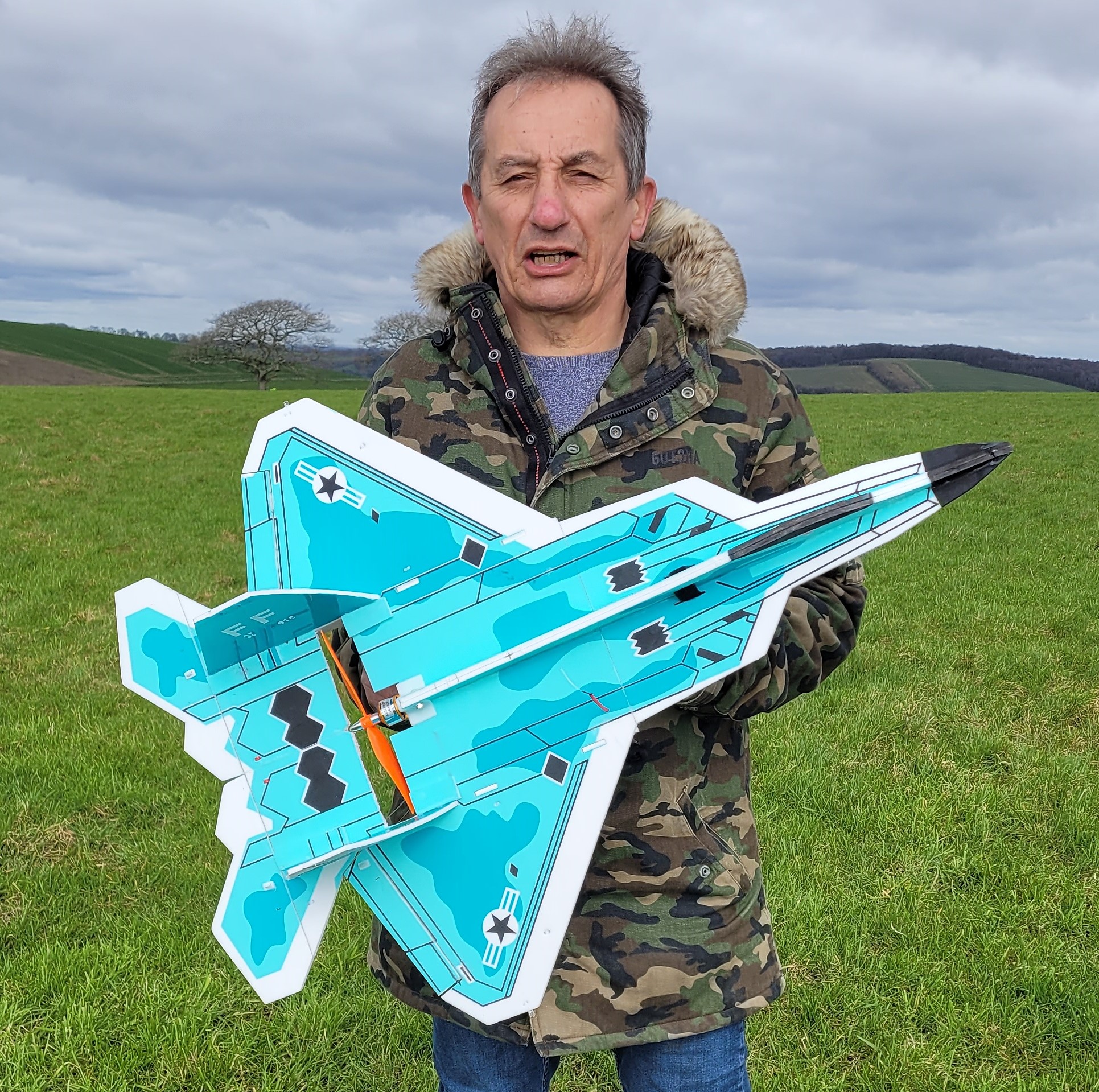 Because it comes from China Ali Express have to add tax but it’s still only £28.29. Woody has made a really nice job of putting it together and the finished model looks very smart.
Because it comes from China Ali Express have to add tax but it’s still only £28.29. Woody has made a really nice job of putting it together and the finished model looks very smart. 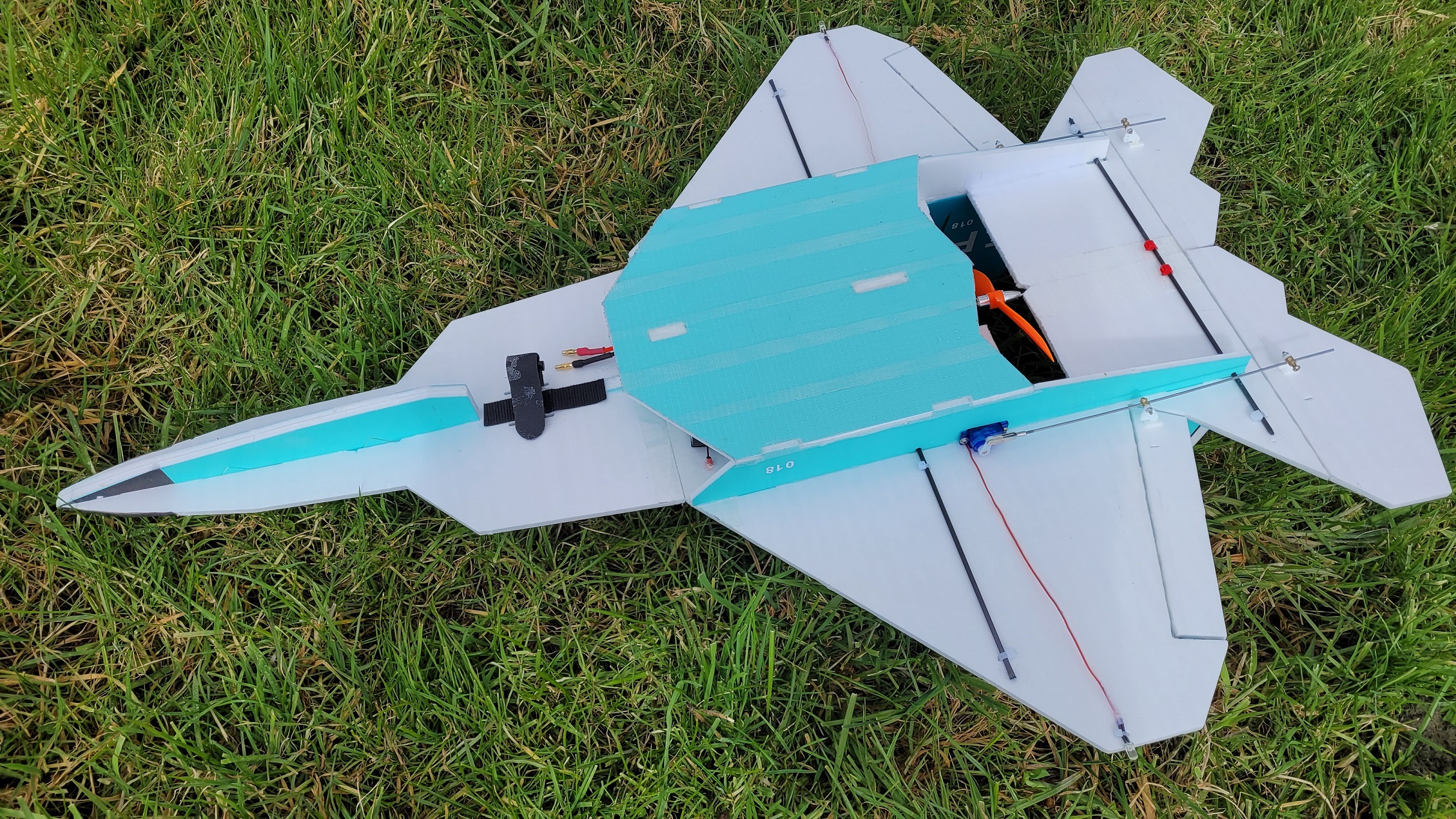 Obviously he’s added some lights but only two on this plane, one on each wingtip.
Obviously he’s added some lights but only two on this plane, one on each wingtip.
 The motor that’s included in the package is an A2212/10T which is 1400kv rather than the 2200kv motors most of us fit to our foamboards so it needs an 8x 6 propeller instead of the usual 6×4 that we use. Before it flew we were a little concerned that it might be underpowered but it flies really well, not quite as fast as most of the foamboards but there’s plenty of power and it will climb almost vertically. Woody was unsure about the centre of gravity position but it turned out to be spot on and the Raptor is a delight to fly.
The motor that’s included in the package is an A2212/10T which is 1400kv rather than the 2200kv motors most of us fit to our foamboards so it needs an 8x 6 propeller instead of the usual 6×4 that we use. Before it flew we were a little concerned that it might be underpowered but it flies really well, not quite as fast as most of the foamboards but there’s plenty of power and it will climb almost vertically. Woody was unsure about the centre of gravity position but it turned out to be spot on and the Raptor is a delight to fly.
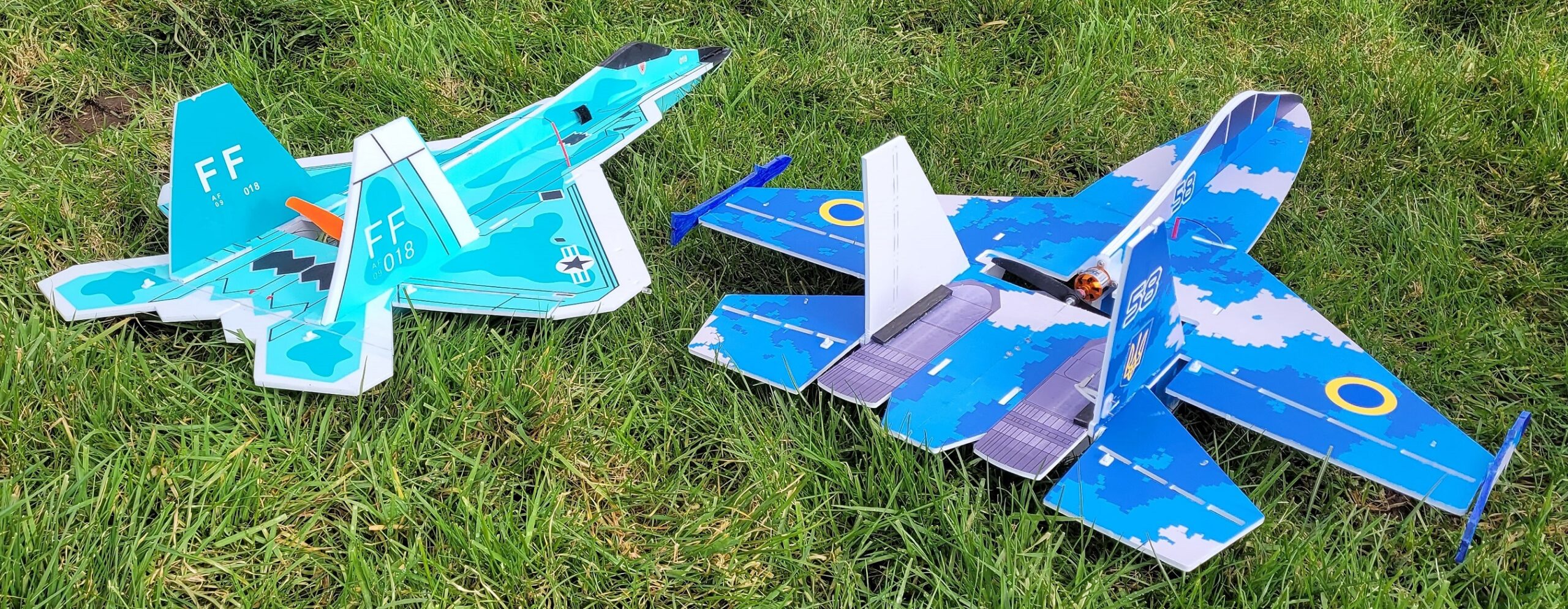 I liked it enough to order one for myself! You can see Woody’s flying in this month’s video.
I liked it enough to order one for myself! You can see Woody’s flying in this month’s video.
Away from foamboards now and back to Gordon Bennett who has bought himself an E-flite P-51 Mustang. Gordon was browsing the adverts and saw that there was a new version of the E-flite Mustang available in the States and it was much cheaper than in England.
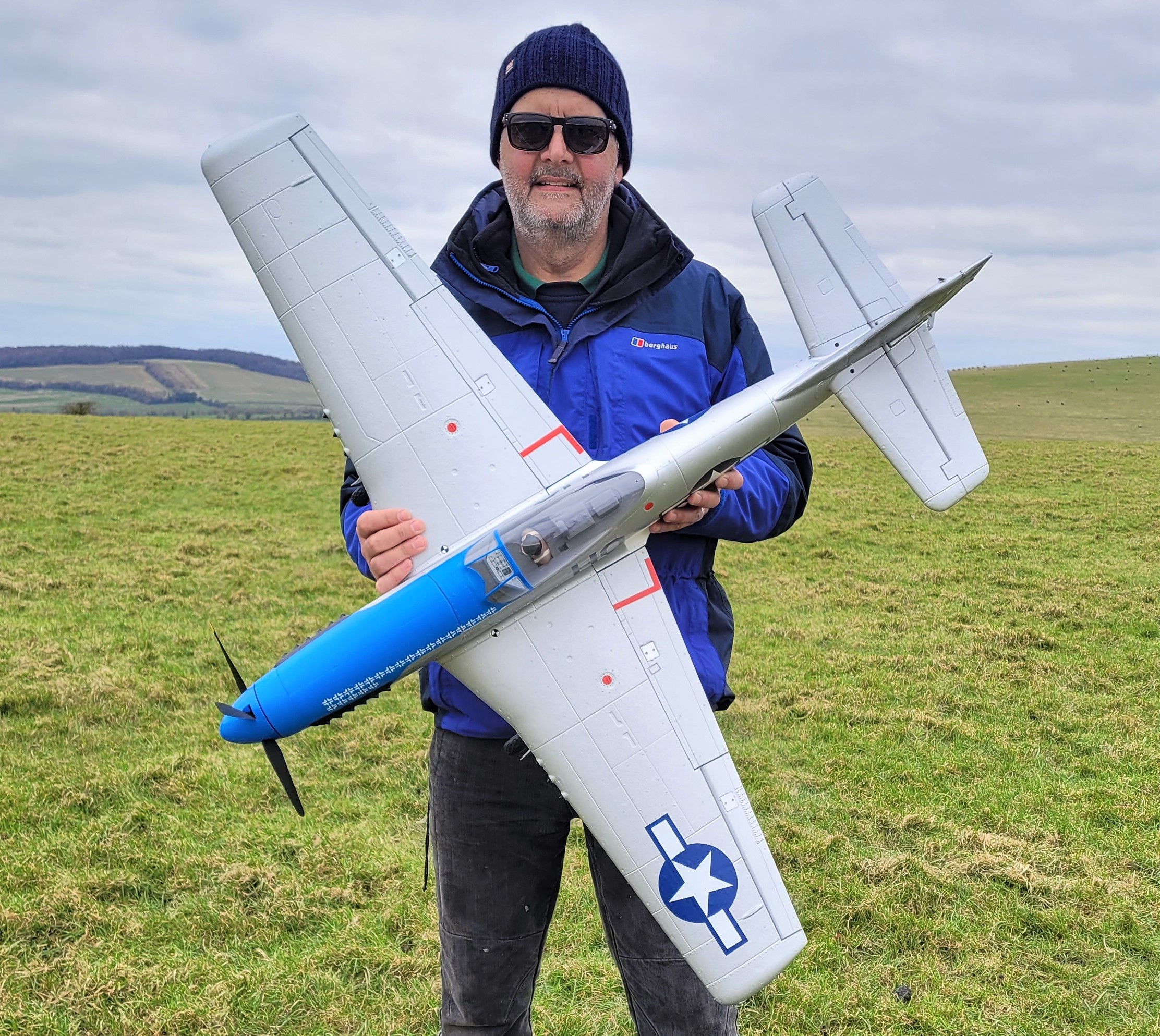 He had a friend in the US military who was able to get things posted to England very cheaply so it seemed only right to ask him to order one. After a bit of a delay due to the US military not wanting to fly any package containing lithium batteries (which it didn’t!) the model arrived safely. This is what E-flite have to say about it: This updated version of the E-flite® P-51D Mustang 1.2m delivers outstanding warbird appeal whether flying or just standing still. It’s now finished in the iconic “Cripes A’Mighty 3rd” trim scheme of George E. Preddy Jr., the top P-51 Mustang ace during World War II who downed six planes in a single day. This replica features a variety of scale details including moulded-in panel lines, a pilot figure, four-blade propeller and more. Plus, its functional flaps and retractable landing gear add to the scale flying experience. The 3S and 4S compatible power system includes an upgraded 70A Spektrum™ Avian™ Smart Lite ESC, and the BNF® Basic version is equipped with an AR631 receiver to deliver real-time telemetry data along with AS3X® and optional-use SAFE® Select technologies.
He had a friend in the US military who was able to get things posted to England very cheaply so it seemed only right to ask him to order one. After a bit of a delay due to the US military not wanting to fly any package containing lithium batteries (which it didn’t!) the model arrived safely. This is what E-flite have to say about it: This updated version of the E-flite® P-51D Mustang 1.2m delivers outstanding warbird appeal whether flying or just standing still. It’s now finished in the iconic “Cripes A’Mighty 3rd” trim scheme of George E. Preddy Jr., the top P-51 Mustang ace during World War II who downed six planes in a single day. This replica features a variety of scale details including moulded-in panel lines, a pilot figure, four-blade propeller and more. Plus, its functional flaps and retractable landing gear add to the scale flying experience. The 3S and 4S compatible power system includes an upgraded 70A Spektrum™ Avian™ Smart Lite ESC, and the BNF® Basic version is equipped with an AR631 receiver to deliver real-time telemetry data along with AS3X® and optional-use SAFE® Select technologies.
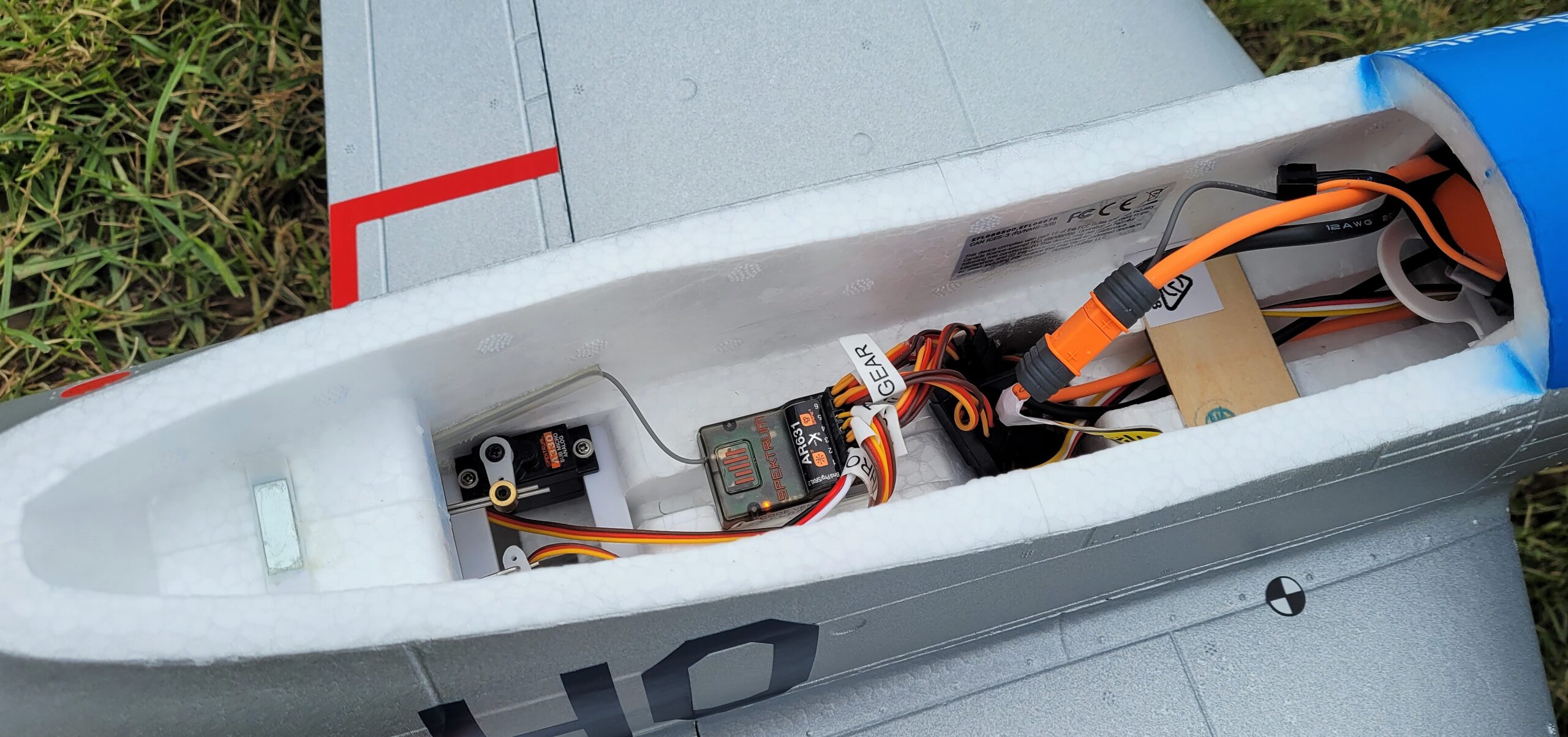
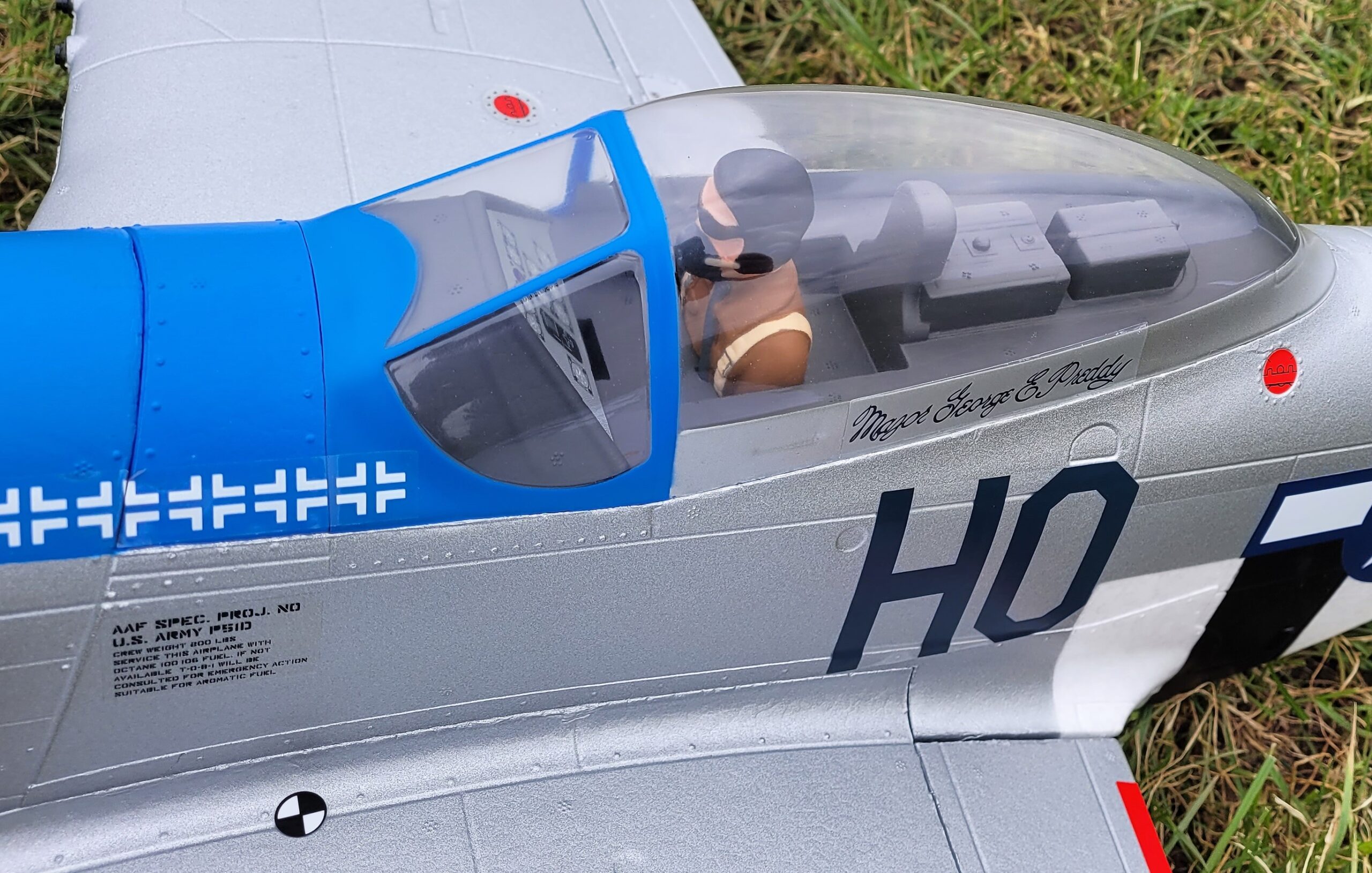 Best of all, no glue is required for final assembly so you can have it ready to fly in less time than it takes to charge a battery! And the 1.2m size allows for easy storage and transport without disassembly, or the one-piece wing can be removed and reinstalled quickly for even greater convenience. So, whether you’re an intermediate or advanced pilot, this P-51D Mustang has the details, features and heart-stopping performance—along with incredible handling at low and high speeds—you need to experience what piloting a legendary thoroughbred is all about.
Best of all, no glue is required for final assembly so you can have it ready to fly in less time than it takes to charge a battery! And the 1.2m size allows for easy storage and transport without disassembly, or the one-piece wing can be removed and reinstalled quickly for even greater convenience. So, whether you’re an intermediate or advanced pilot, this P-51D Mustang has the details, features and heart-stopping performance—along with incredible handling at low and high speeds—you need to experience what piloting a legendary thoroughbred is all about.
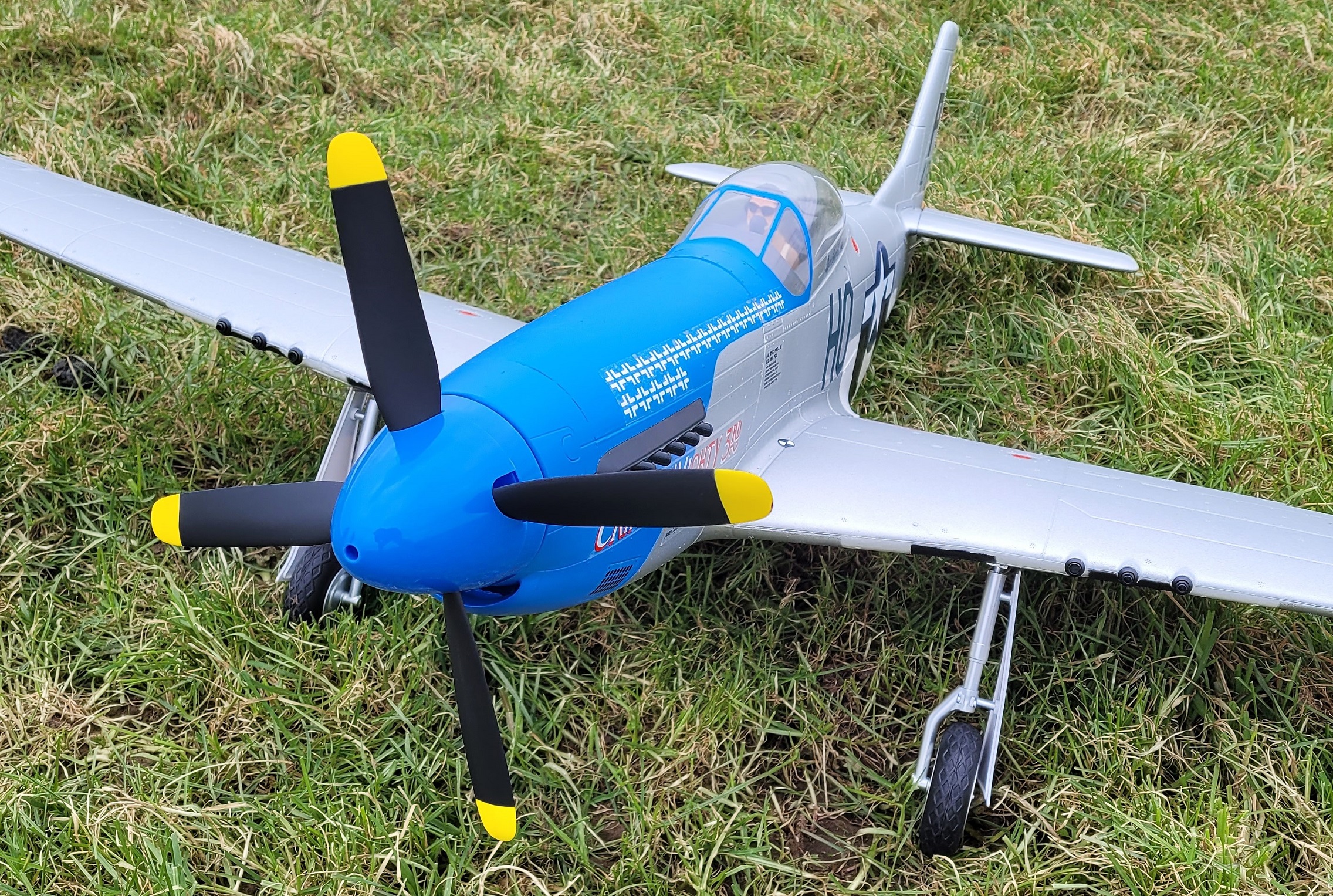
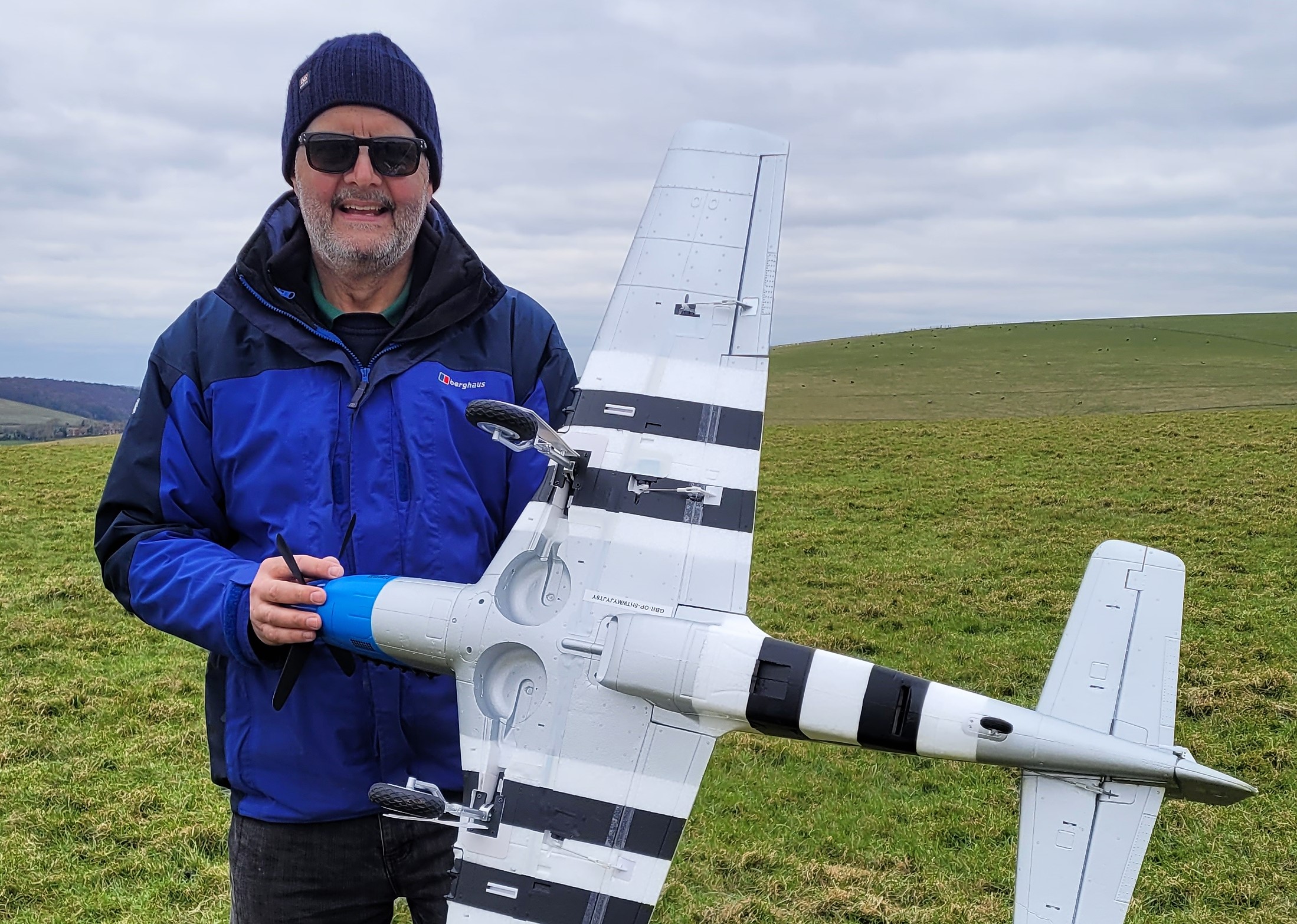 Gordon asked me to do the initial trimming and once I’d managed to stop the nose trying to peck into our patch the Mustang took-off and flew perfectly. The telemetry wouldn’t shut up, it kept saying something about low battery which was very unnerving with a brand new expensive model that wasn’t mine (bl****y Spektrum!). While trying to find the retract switch I inadvertently switched the gyro to ‘child’ mode but I didn’t realise until I tried to roll and it fought back and stated resolutely upright! Once Gordon had switched that out I handed the transmitter over to him for the rest of the flight. Despite the dire telemetry warnings nothing untoward happened and after a few minutes of gentle flight Gordon landed the P-51 safely. He is rather worried about the brand new lipo so will be checking it out before the next flight. You can see some of the flight in this month’s video.
Gordon asked me to do the initial trimming and once I’d managed to stop the nose trying to peck into our patch the Mustang took-off and flew perfectly. The telemetry wouldn’t shut up, it kept saying something about low battery which was very unnerving with a brand new expensive model that wasn’t mine (bl****y Spektrum!). While trying to find the retract switch I inadvertently switched the gyro to ‘child’ mode but I didn’t realise until I tried to roll and it fought back and stated resolutely upright! Once Gordon had switched that out I handed the transmitter over to him for the rest of the flight. Despite the dire telemetry warnings nothing untoward happened and after a few minutes of gentle flight Gordon landed the P-51 safely. He is rather worried about the brand new lipo so will be checking it out before the next flight. You can see some of the flight in this month’s video.
The last new model this month belongs to young Leo and it’s yet another foamboard.
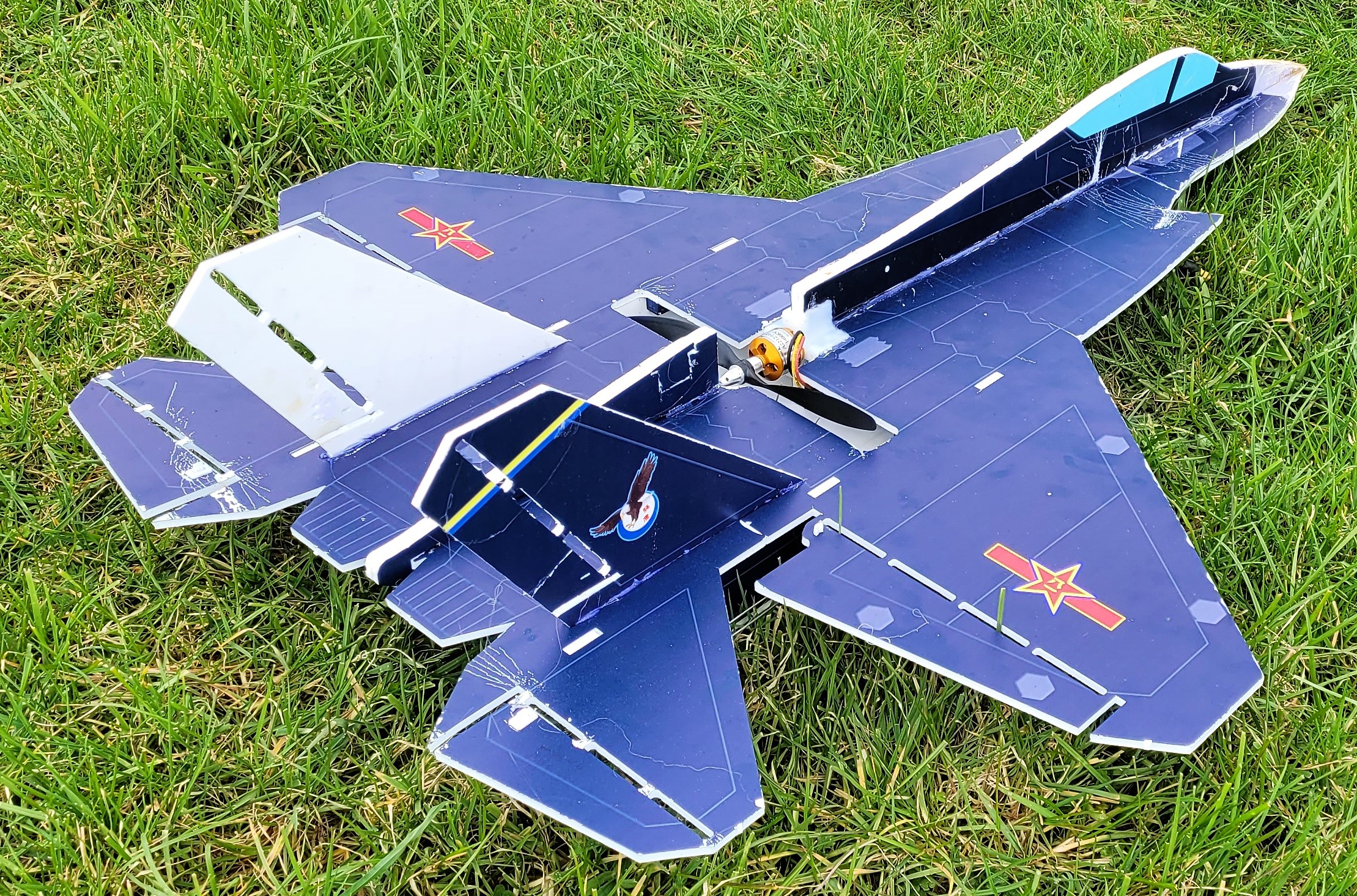 But this one is a bit of an unusual model as it’s a J-31. What’s a J-31 I hear you ask?
But this one is a bit of an unusual model as it’s a J-31. What’s a J-31 I hear you ask?
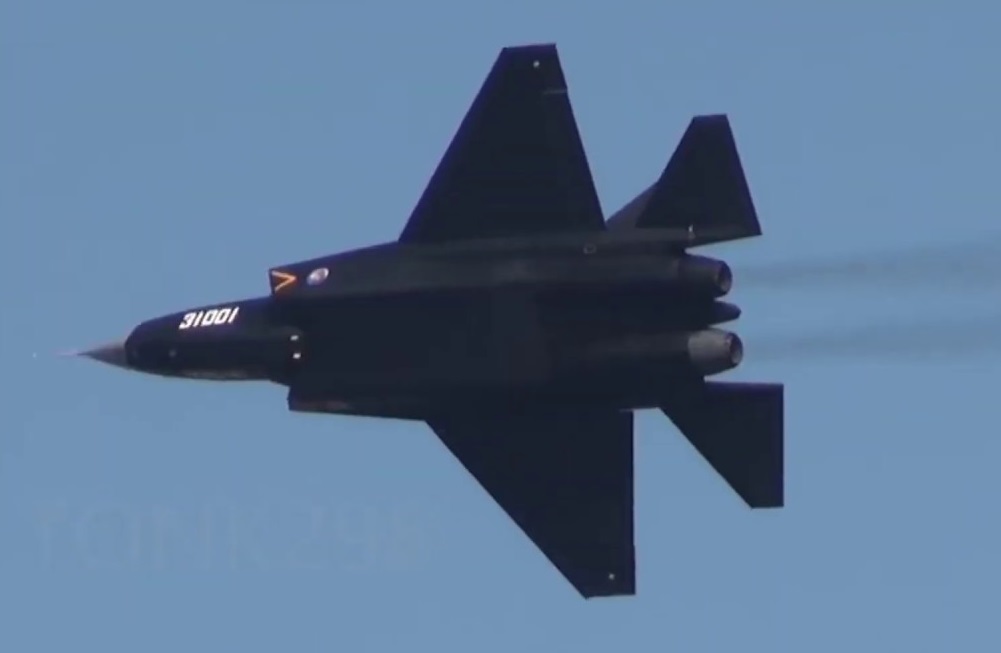 Well it’s a Chinese aircraft made by Shenyang which is sometimes known as an FC-31 and it looks pretty similar to an F-22 Raptor, some say it’s a copy. Leo’s model is another of the range from Ali Express and it came with the same electronics pack as Woody’s F-22 with an A2212/10T 1400kv motor, three 8×6 props, a 30A speed controller, and two servos.
Well it’s a Chinese aircraft made by Shenyang which is sometimes known as an FC-31 and it looks pretty similar to an F-22 Raptor, some say it’s a copy. Leo’s model is another of the range from Ali Express and it came with the same electronics pack as Woody’s F-22 with an A2212/10T 1400kv motor, three 8×6 props, a 30A speed controller, and two servos.
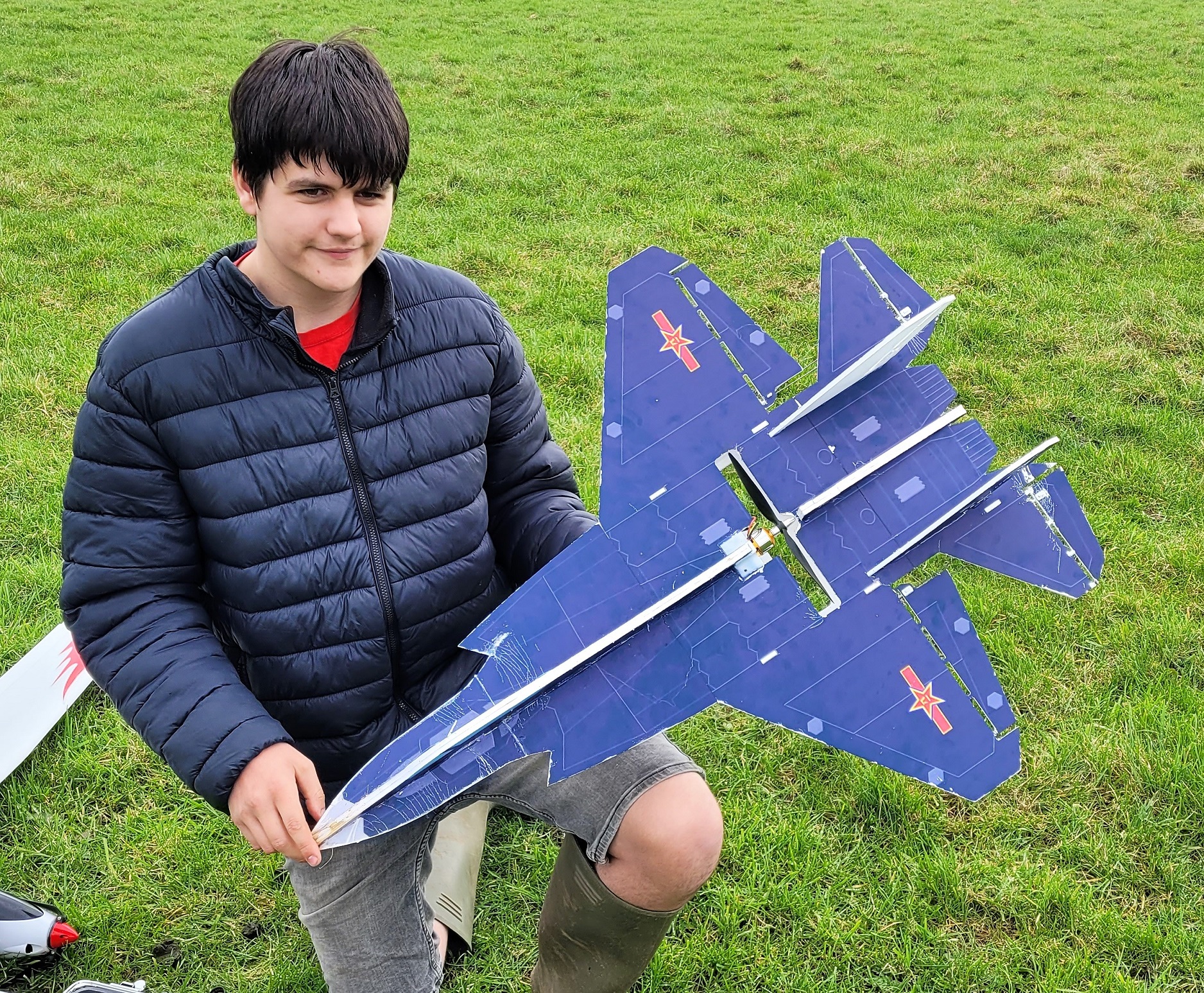
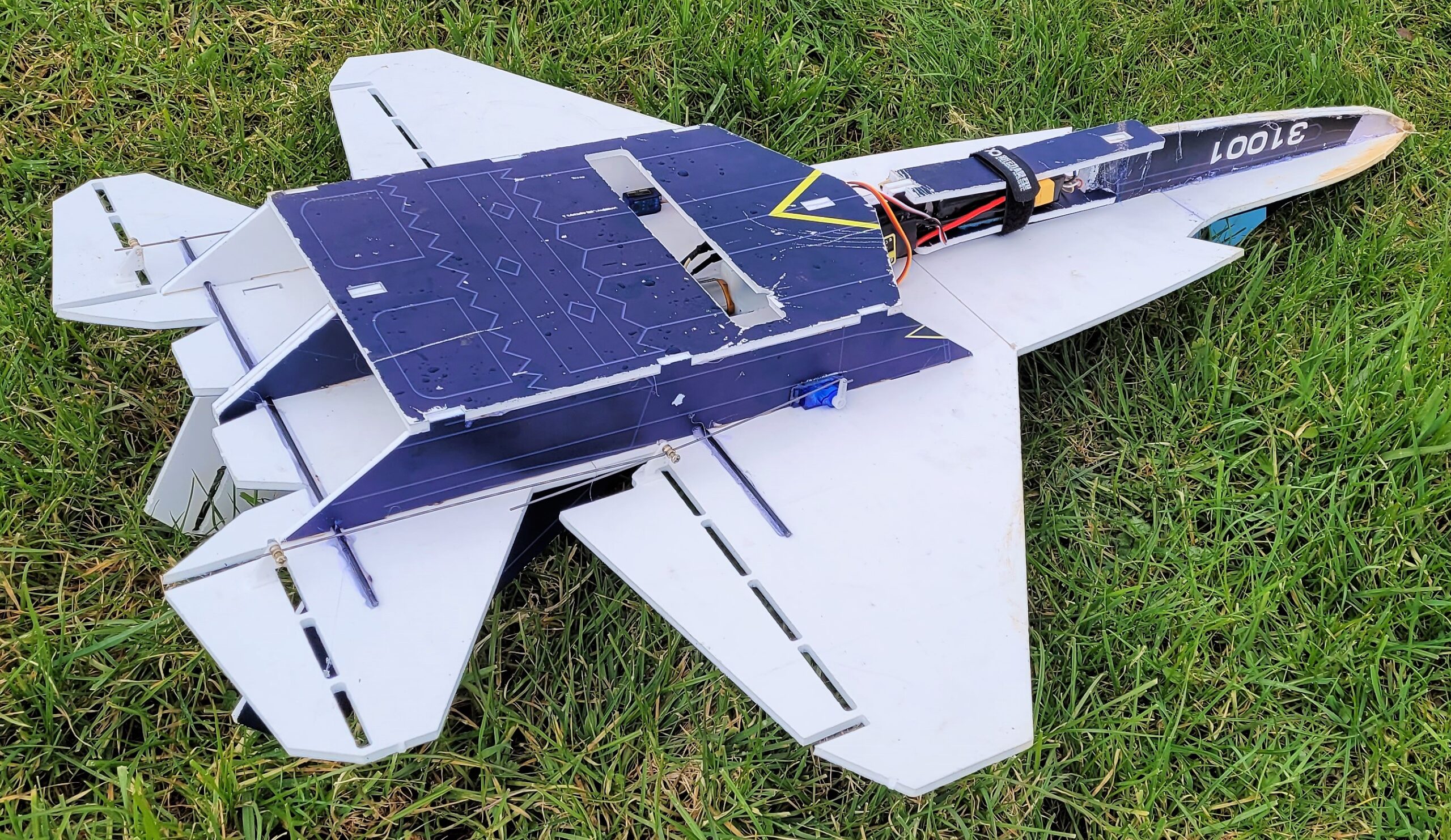 It flies extremely well, most of these foamboards seem to fly better than a flat plate of foam should be expected to fly and Leo has been demonstrating how he can fly it inverted at ridiculously slow speeds. Take a look at it in the video and prepare to be impressed by it.
It flies extremely well, most of these foamboards seem to fly better than a flat plate of foam should be expected to fly and Leo has been demonstrating how he can fly it inverted at ridiculously slow speeds. Take a look at it in the video and prepare to be impressed by it.
For the monthly ‘action’ shots this month I’ve taken stills of some of the lovely models from Gordon’s video. The first one is of a Yak 130, the same as mine so I’ve included mine to see if you can tell the difference. No? OK, I’ll give you a clue, mine has the wheels up:
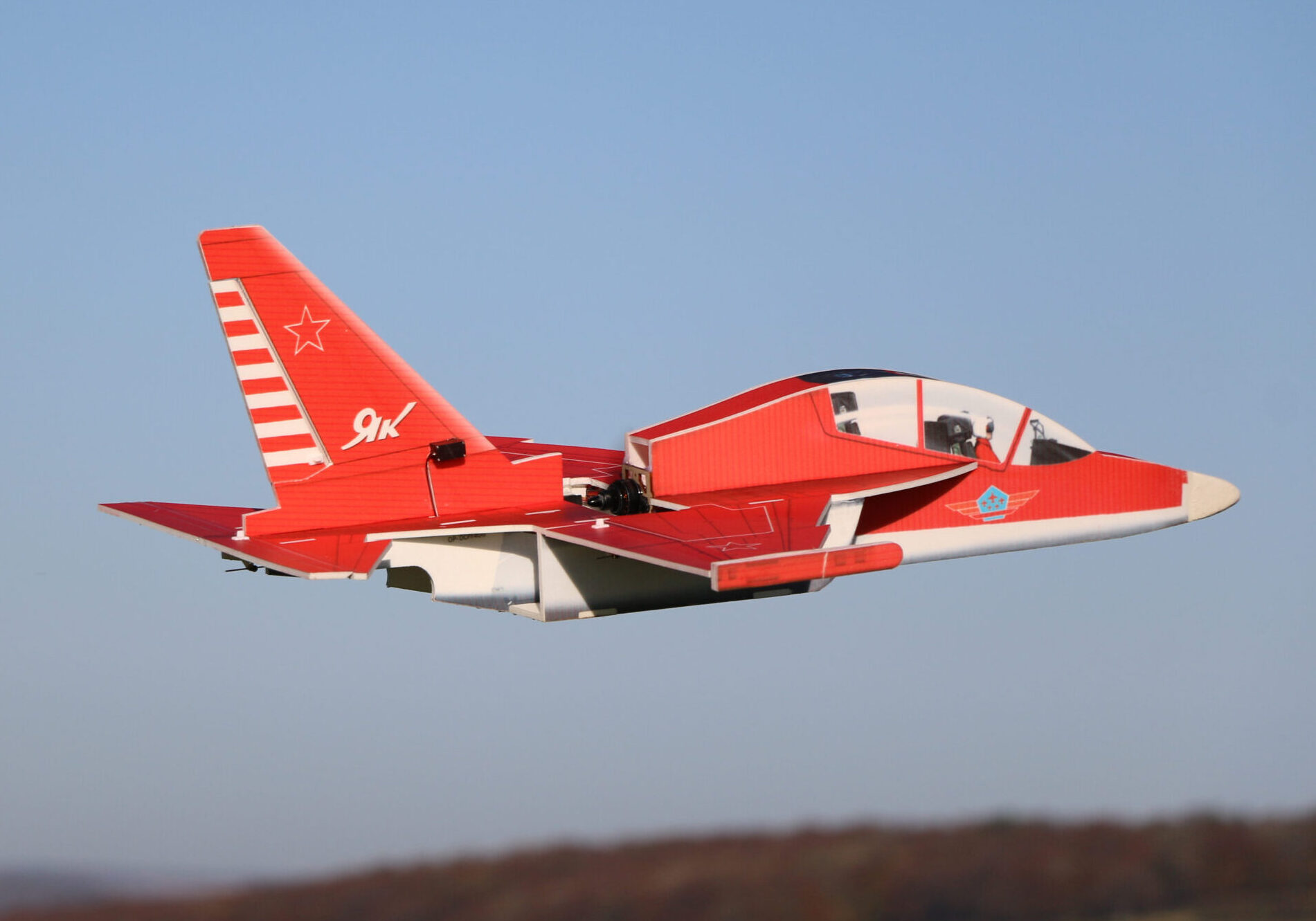
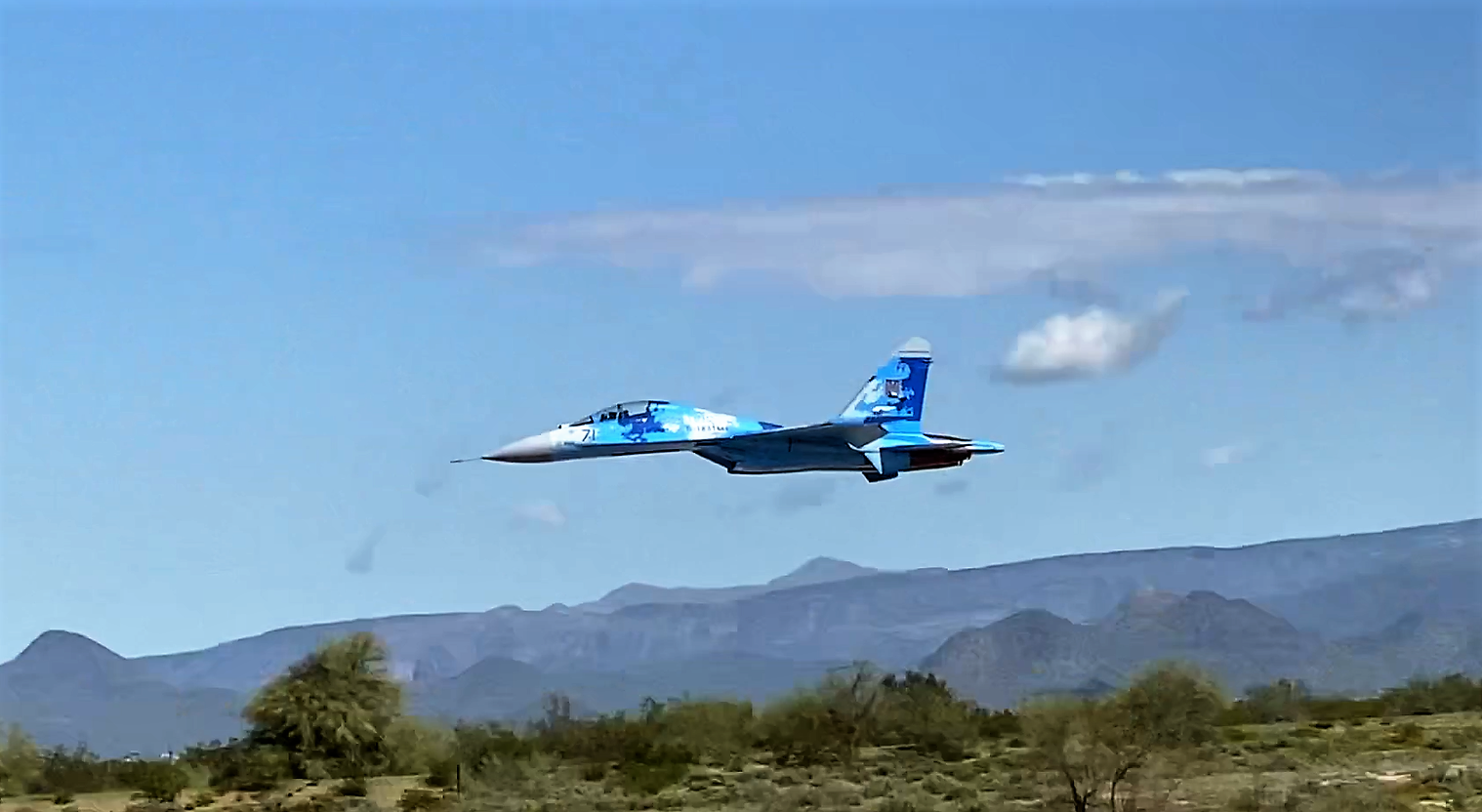
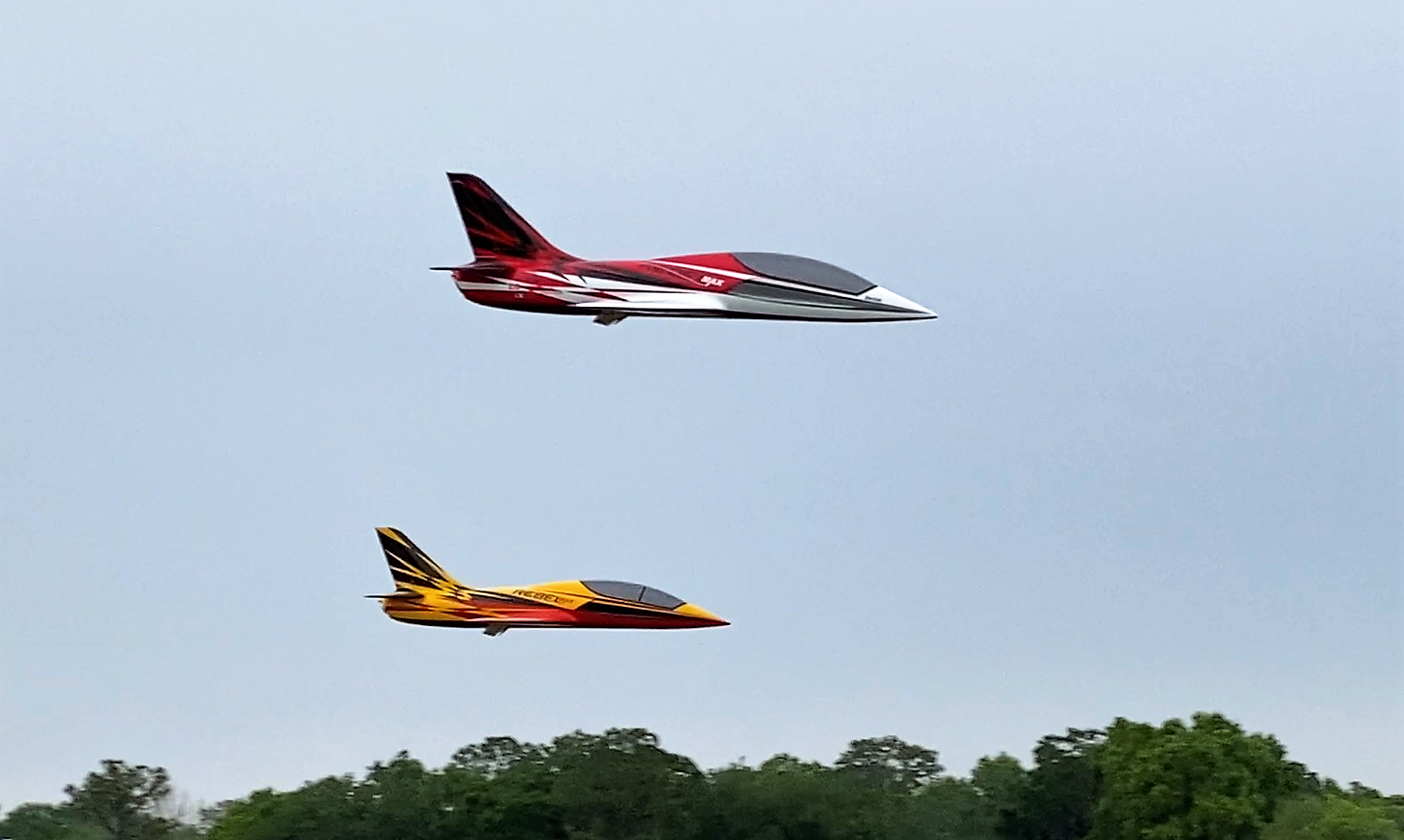
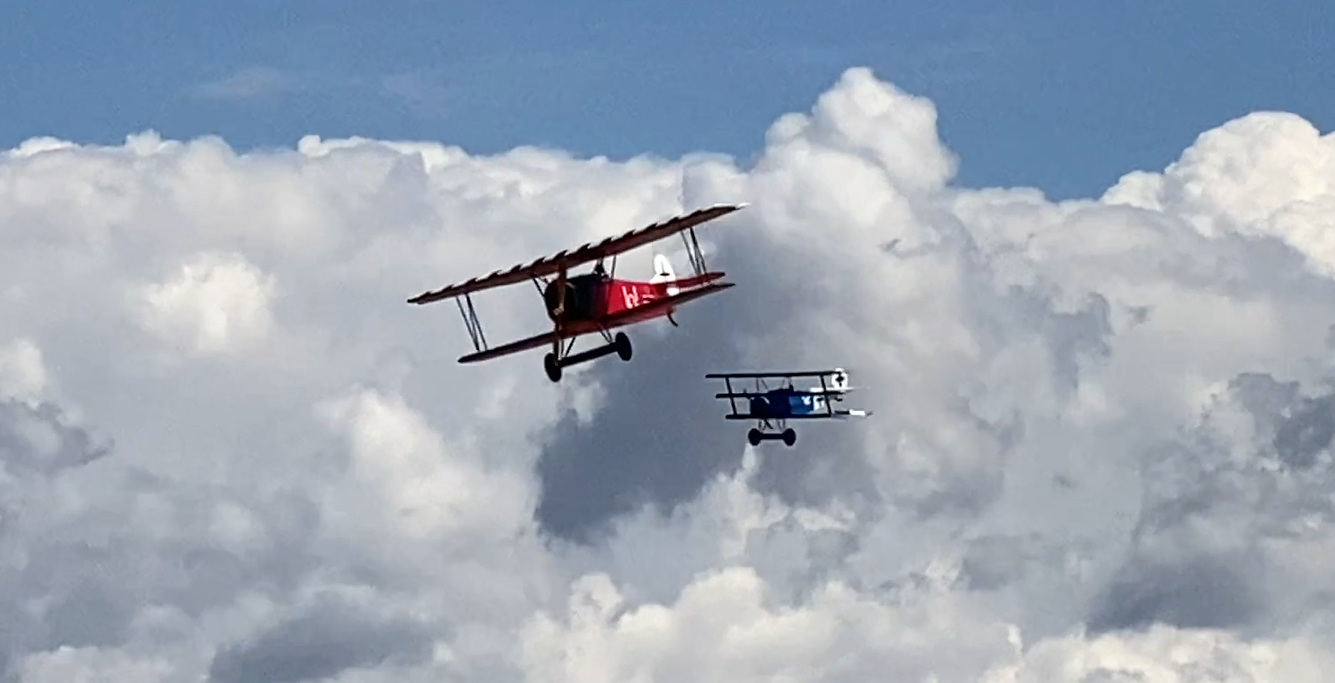
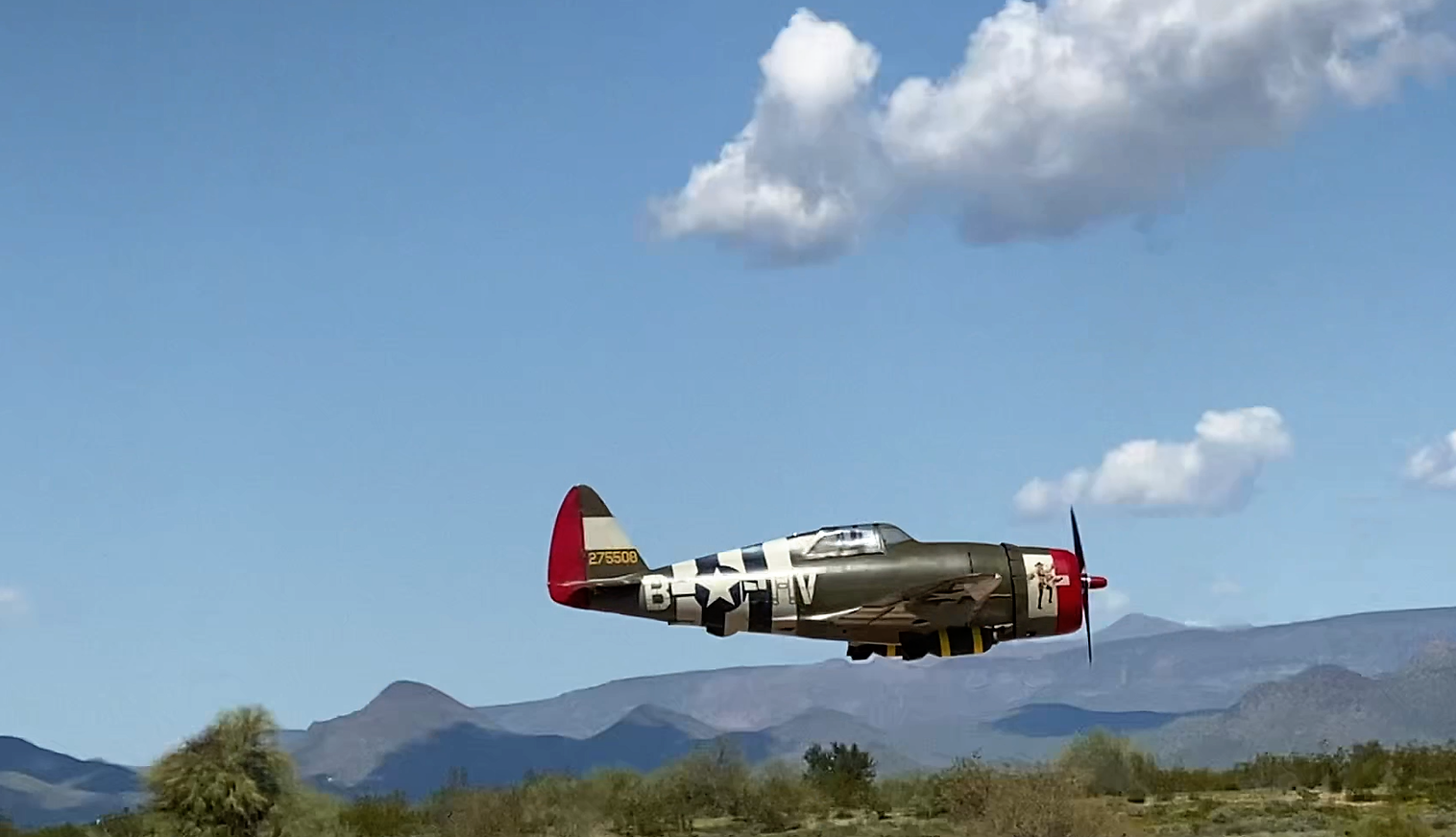

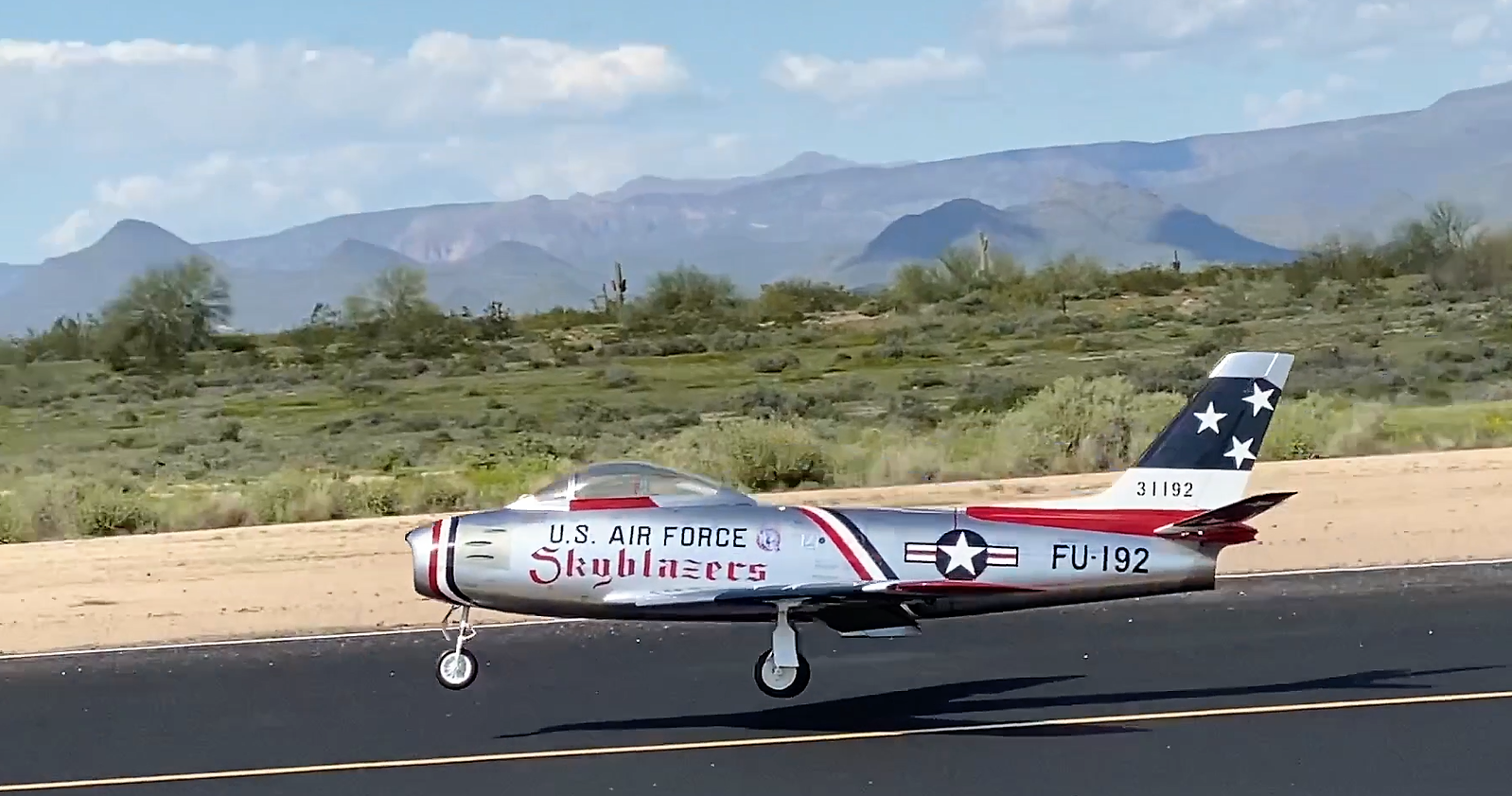 Video time now which this month includes footage shot by Peter F, Captain Slow, Dougal Entendre, and myself. Please watch the video full screen, it’s so much better with small models flying around:
Video time now which this month includes footage shot by Peter F, Captain Slow, Dougal Entendre, and myself. Please watch the video full screen, it’s so much better with small models flying around:
If the video won’t play for you please click HERE
A man was sitting in a Heathrow bar when he noticed a beautiful woman. He thought “Wow, she’s gorgeous, must be a flight attendant. But which airline does she work for?”
Hoping to pick her up, he leant over and uttered the BA slogan: “To Fly. To Serve?”
She gave him a confused look and he immediately thought “No, she doesn’t work for BA”.
He remembered another slogan and leaned towards her “Something special in the air?”
He got the same confused look. Another no, so he crossed American Airlines off the list.
Next he tried the Virgin Atlantic slogan “Everyone can take on the world?”
This time the woman turned to him and snapped “What the **** do you want?”
The man smiled knowingly, slumped back in his chair, and said… “Ah yes, Ryanair”.
Colin Cowplain

